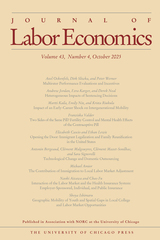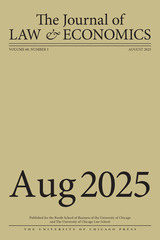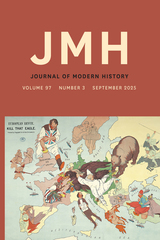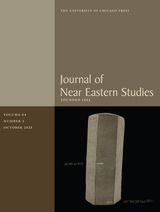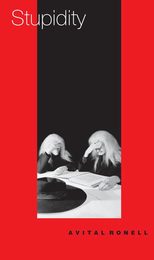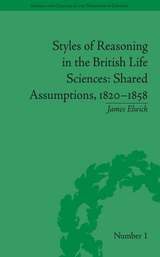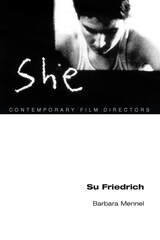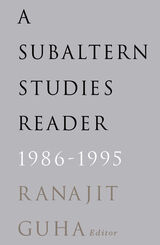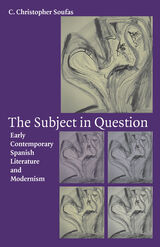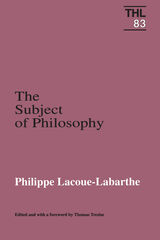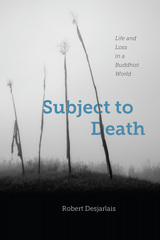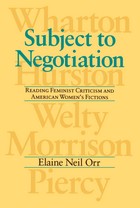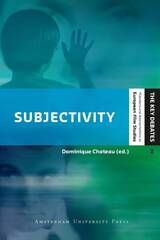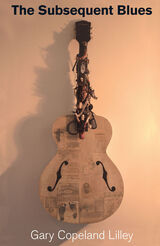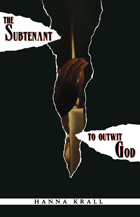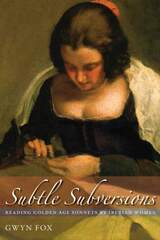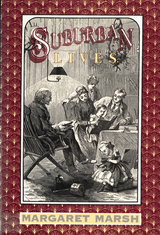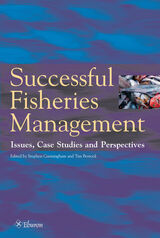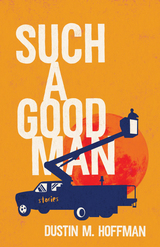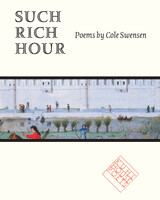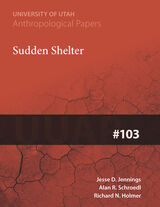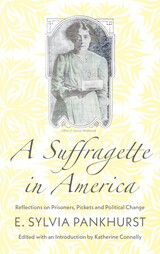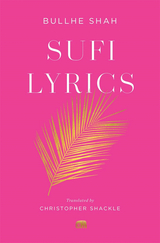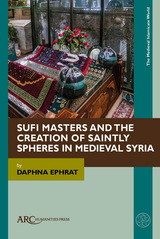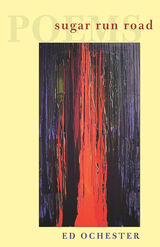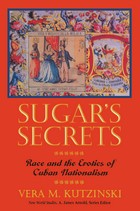Stupidity
Avital Ronell
University of Illinois Press, 2001 In Stupidity Avital Ronell explores the fading empire of cognition, modulating stupidity into idiocy, puerility, and the figure of the ridiculous philosopher instituted by Kant. Drawing on a range of writers including Dostoevsky, Schlegel, Musil, and Wordsworth, Stupidity investigates ignorance, dumbfounded-ness, and the limits of reason.
 The Sturdy Oak: A Composite Novel of American Politics
Elizabeth Jordan
Ohio University Press, 1998 In the spring of 1916, as the workers for woman suffrage were laying plans for another attack on the bastions of male supremacy, the idea for The Sturdy Oak was born. Based on the rules of an old parlor game, wherein one person begins a narrative, another continues it, and another follows, this collaborative effort by the leading writers of the day, such as Fannie Hurst, Dorothy Canfield, and Kathleen Norris, is a satiric look at the gender roles of the time.
There is much in The Sturdy Oak that reflects the New York campaign for suffrage of 1916–1917. The setting is the fictional city of Whitewater in upstate New York. Idealistic reformers are pitted against a ruthless political machine, and the traditional picture of man as “the sturdy oak” supporting woman, “the clinging vine,” is ridiculed in the portrayal of an engaging couple, George and Genevieve Remington. Nonetheless, the purpose of the book is not primarily ridicule but reform, and the reader is taken through the steps by which a confirmed anti-suffragist is gradually transformed into a supporter of the suffrage cause.
Beyond its historical interest, The Sturdy Oak is imbued with a political and social currency that makes it applicable even today. And because of the skill of the writers of this composite novel, even eight decades after its initial publication The Sturdy Oak is still, as the New York Times said in 1917, “irresistibly readable.”
 Stutter
Marc Shell
Harvard University Press, 2005 One person can't help stuttering. The other can't help laughing. And in the way one bodily betrayal of better intentions mirrors the other, we find ourselves in the gray area where mind and body connect--and, at the damnedest moments, disconnect. In a book that explores the phenomenon of stuttering from its practical and physical aspects to its historical profile to its existential implications, Marc Shell plumbs the depths of this murky region between will and flesh, intention and expression, idea and word. Looking into the difficulties encountered by people who stutter--as do fifty million worldwide--Shell shows that, however solitary stutterers may be in their quest for normalcy, they share a kinship with many other speakers, both impeded and fluent.
Stutter takes us back to a time when stuttering was believed to be "diagnosis-induced," then on to the complex mix of physical and psychological causes that were later discovered. Ranging from cartoon characters like Porky Pig to cultural icons like Marilyn Monroe, from Moses to Hamlet, Shell reveals how stuttering in literature plays a role in the formation of tone, narrative progression, and character. He considers such questions as: Why does stuttering disappear when the speaker chants? How does singing ease the verbal tics of Tourette's Syndrome? How do stutterers cope with the inexpressible, the unspeakable?
Written by someone who has himself struggled with stuttering all his life, this provocative and wide-ranging book shows that stuttering has implications for myriad types of expression and helps to define what it means to be human.
 Stuttering and What you can do About it
Wendell Johnson
University of Minnesota Press, 1961 This is a book for parents who are worried about their children’s stuttering, for teachers, doctors, friends, and relatives of those who stutter, and for stutterers themselves. It offers help, encouragement, and guidance in dealing with the problem of stuttering, which troubles more than a million persons in the United States alone.Dr. Johnson, an outstanding authority on the subject, writes in simple language so that anyone can readily understand and follow his suggestions. What he says in this book is based on many years of laboratory research and clinical observation, and his own experience as a stutterer. He tells of his early years of struggle with the handicap and his decision to devote his life to getting at the basic causes of stuttering and finding ways to prevent or alleviate it. He describes his research experiences, likening them to a detective story centered on a search for the causes of stuttering as the culprit in the case. In this account he quotes from interviews which he conducted with parents in an effort to pinpoint the exact conditions or situations in which stuttering was believed to have started. He explains how the problem develops and how it becomes a frustrating “sad-go-round.” Finally, he tells what parents and others can do for children who are threatened with the handicap of stuttering and what adult stutterers can do to help themselves.
 Stuttering in Children and Adults: Thirty Years of Research at the University of Iowa
Wendell Johnson, Editor
University of Minnesota Press, 1955 Stuttering in Children and Adults was first published in 1955. Minnesota Archive Editions uses digital technology to make long-unavailable books once again accessible, and are published unaltered from the original University of Minnesota Press editions. One of the largest groups of handicapped people in the world today is made up of the estimated fifteen million persons who stutter. Their predicament has been one of man's most baffling problems ever since it was first recorded by the ancients, but not until the present century has the mystery of stuttering showed any signs of lifting. The studies collected in this volume represent a substantial step toward the solving of the mystery. The University of Iowa, a pioneer in research on the causes and treatment of stuttering, has carried on its work for many years. This book presents all previously unpublished papers and dissertations (a total of forty-three) that have resulted from this research program. Much of the work centers on the onset of stuttering in children and underlies the theory that stuttering begins with the hearer rather than the speaker. Interrelationships between personality and stuttering have been investigated, a search has been made for a possible physical basis for stuttering, conditions affecting severity of stuttering have been studied, and research on therapy has been attempted. This is an important book for psychologists, educators, social workers, physicians, parents, and others concerned with speech disorders. For those who devote their full effort to the problems discussed—the specialists in speech pathology and therapy—the book is essential.
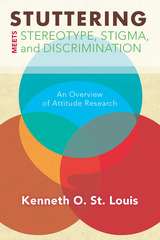 Stuttering Meets Sterotype, Stigma, and Discrimination: An Overview of Attitude Research
Kenneth O. St. Louis
West Virginia University Press, 2015 More than a century of research has sought to identify the causes of stuttering, describe its nature, and enhance its clinical treatment. By contrast, studies directly focused upon public and professional attitudes toward stuttering began in the 1970s. Recent work has taken this research to new levels, including the development of standard attitude measures; addressing the widely reported phenomena of teasing, bullying, and discrimination against people who stutter; and attempting to change public opinion toward stuttering to more accepting and sensitive levels.
Stuttering Meets Stereotype, Stigma, and Discrimination: An Overview of Attitude Research is the only reference work to date devoted entirely to the topic of stuttering attitudes. It features comprehensive review chapters by St. Louis, Boyle and Blood, Gabel, Langevin, and Abdalla; an annotated bibliography by Hughes; and experimental studies by other seasoned and new researchers. The book leads the reader through a maze of research efforts, emerging with a clear understanding of the important issues involved and ideas of where to go next. Importantly, the evidence base for stuttering attitude research extends beyond research in this fluency disorder to such areas as mental illness, obesity, and race. Thus, although of interest primarily to those who work, interact, or otherwise deal with stuttering, the book has potential for increasing understanding, ameliorating negative attitudes, and informing research on any of a host of other stigmatized conditions.
 Style and Music: Theory, History, and Ideology
Leonard B. Meyer
University of Chicago Press, 1997 Leonard Meyer proposes a theory of style and style change that relates the choices made by composers to the constraints of psychology, cultural context, and musical traditions. He explores why, out of the abundance of compositional possibilities, composers choose to replicate some patterns and neglect others.
Meyer devotes the latter part of his book to a sketch-history of nineteenth-century music. He shows explicitly how the beliefs and attitudes of Romanticism influenced the choices of composers from Beethoven to Mahler and into our own time.
"A monumental work. . . . Most authors concede the relation of music to its cultural milieu, but few have probed so deeply in demonstrating this interaction."—Choice
"Probes the foundations of musical research precisely at the joints where theory and history fold into one another."—Kevin Korsyn, Journal of American Musicological Society
"A remarkably rich and multifaceted, yet unified argument. . . . No one else could have brought off this immense project with anything like Meyer's command."—Robert P. Morgan, Music Perception
"Anyone who attempts to deal with Romanticism in scholarly depth must bring to the task not only musical and historical expertise but unquenchable optimism. Because Leonard B. Meyer has those qualities in abundance, he has been able to offer fresh insight into the Romantic concept."—Donal Henahan, New York Times
 Style and Seduction: Jewish Patrons, Architecture, and Design in Fin de Siècle Vienna
Elana Shapira
Brandeis University Press, 2016 A recent surge of interest in Jewish patronage during the golden years of Vienna has led to the question, Would modernism in Vienna have developed in the same fashion had Jewish patrons not been involved? This book uniquely treats Jewish identification within Viennese modernism as a matter of Jews active fashioning of a new language to convey their aims of emancipation along with their claims of cultural authority. In this provocative reexamination of the roots of Viennese modernism, Elana Shapira analyzes the central role of Jewish businessmen, professionals, and writers in the evolution of the city’s architecture and design from the 1860s to the 1910s. According to Shapira, these patrons negotiated their relationship with their non-Jewish surroundings and clarified their position within Viennese society by inscribing Jewish elements into the buildings, interiors, furniture, and design objects that they financed, produced, and co-designed. In the first book to investigate the cultural contributions of the banker Eduard Todesco, the steel tycoon Karl Wittgenstein, the textile industrialist Fritz Waerndorfer, the author Peter Altenberg, the tailor Leopold Goldman, and many others, Shapira reconsiders theories identifying the crisis of Jewish assimilation as a primary creative stimulus for the Jewish contribution to Viennese modernism. Instead, she argues that creative tensions between Jews and non-Jews—patrons and designers who cooperated and arranged well-choreographed social encounters with one another—offer more convincing explanations for the formation of a new semantics of modern Viennese architecture and design than do theories based on assimilation. This thoroughly researched and richly illustrated book will interest scholars and students of Jewish studies, Vienna and Viennese culture, and modernism.
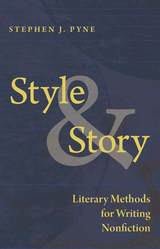 Style and Story: Literary Methods for Writing Nonfiction
Stephen J. Pyne
University of Arizona Press, 2018 There are two basic rules for writing nonfiction, says historian and award-winning author Stephen J. Pyne. Rule 1: You can’t make stuff up. Rule 2: You can’t leave out known stuff that affects our understanding. Follow these rules, and you are writing nonfiction. Writing for different audiences and genres will require further guidelines. But all readers expect that style and story (or more broadly, theme) will complement one another.
Style and Story is for those who wish to craft nonfiction texts that do more than simply relay facts and arguments. Pyne explains how writers can employ literary tools and strategies to have art and craft add value to their theme. With advice gleaned from nearly a dozen years of teaching writing to graduate students, Pyne offers pragmatic guidance on how to create powerful nonfiction, whether for an academic or popular audience.
Each chapter offers samples that span genres, showcasing the best kinds of nonfiction writing. Pyne analyzes these examples that will help writers understand how they can improve their nonfiction through their choice of voice, words, structure, metaphors, and narrative. Pyne builds on his previous guide, Voice and Vision, expanding the range of topics to include openings and closings, humor and satire, historical writing, setting scenes, writing about technical matters and deep details, long and short narration, reading for craft, and thoughts on writing generally. He also includes in this volume a set of exercises to practice writing techniques.
Style and Story will be treasured by anyone, whether novice or expert, who seeks guidance to improve the power of their nonfiction writing.
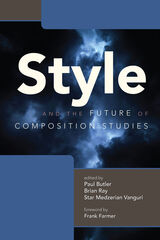 Style and the Future of Composition Studies
Paul Butler
Utah State University Press, 2020 Style and the Future of CompositionStudies explores style’s potential for informing how students are taught to write well and its power as a tool for analyzing the language and discourse practices of writers and speakers in a range of contexts.
Many college writing teachers operate under the belief that style still refers primarily to the kinds of issues discussed in Strunk and White’s popular but outdated book The Elements of Style. This work not only challenges this view but also offers theories and pedagogies from diverse perspectives that help teachers and students develop strategic habits and mindsets to negotiate languages, genres, and discourse conventions. The chapters explore the ways in which style directly affects—and is affected by—multiple sources of shifting disciplinary inquiry, contributing new insights by drawing on research in cultural studies, sociolinguistics, discourse studies, translingualism, and writing across the curriculum, as well as new approaches to classical rhetorical theory.
The reemergence of stylistic inquiry can be used dynamically to produce new insights not only about emerging disciplinary interests but also about the study of style as a kind of language in and of itself. Style and the Future of Composition Studies demonstrates that style deserves to be a central focus of writing teaching. More than just the next style collection, the book advocates for style’s larger prominence in composition discussions generally. It will be of interest to a broad range of students and scholars of writing studies, as well as a wider set of readers in academe.
Contributors:
Cydney Alexis, Laura Aull, Anthony Box, Jimmy Butts, Mike Duncan, William FitzGerald, Melissa Goldthwaite, Eric House, TR Johnson, Almas Khan, Zak Lancaster, Eric Leake, Andrea Olinger, Thomas Pace, Jarron Slater, Jonathan Udelson
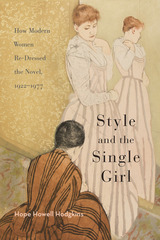 Style and the Single Girl: How Modern Women Re-Dressed the Novel, 1922–1977
Hope Howell Hodgkins
Ohio State University Press, 2016 Style and the Single Girl by Hope Howell Hodgkins reveals how four very different single-girl novelists employed modern modes to re-dress the traditional English marriage plot. In the first monograph to use fashion theory and history to trace the literary progress of British women in later modernity, Hodgkins argues that correspondences between a gendered sartorial style and a gendered literary style persisted throughout the modern era. She demonstrates how those correspondences did not fade but became fraught as women matured in the sharply gendered crucible of war.
Hodgkins delineates how in the 1920s and 1930s, popular novels by Dorothy Sayers and high-art fiction by Jean Rhys used dress to comment wittily and bitterly on gender relations. During World War II, changes in British Vogue and compromises made by the literary journal Horizon signaled the death of modernist styles, as Elizabeth Bowen’s gender-bent wartime stories show. Then demure and reserved postwar styles—Dior’s curvy New Look, the Movement’s understated literary irony—were intertwined in the fictions of Barbara Pym and Muriel Spark, who re-dressed the novel with a vengeance. Whether fashioning detective fiction, literary impressionism, or postwar comedy, these novelists used style in every sense to redefine that famous question, “What do women want?”
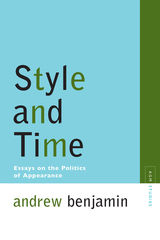 Style and Time: Essays on the Politics of Appearance
Andrew Benjamin
Northwestern University Press, 2006 Interruption is often read as the foundational gesture of modernity—the means through which modernity asserts its existence by claiming its discontinuity with the past. Exposing the limitations of such an understanding, this book offers a very different approach: here, modernity is the site that poses the question of how we are to continue when every attempt to think and understand the present is marked by the necessity of an interruption. Through a reading of Walter Benjamin's writings—particularly on interruption, fashion, and Jugendstil (or Art Nouveau)—Andrew Benjamin in this work offers a sustained meditation on the role of interruption in modernity. His book departs from and elaborates an important but overlooked dimension of Benjamin's discourse: the question of style as it bears upon temporality and spatiality. Extending this meditation in exciting and unexpected ways--toward problems of cosmopolitanism, immigration, and the graphically pornographic, for instance—the author is able to translate Benjamin's multifaceted formulations on style, the dialectical image, awakening, temporality, and spatiality into lucid and highly intelligent stylistics underscoring the philosophical notions of Schein and Erscheining, the interruptions of modernity, and the politics of sameness and otherness.
Nothing less than a rethinking of the conditions of Western art as it relates to politics, architecture, and time, this study of Walter Benjamin's modernity in temporal and spatial terms is a provocative and original work of philosophy in its own right—a work that suggests that the time has come to revise existing paradigms.
 Style as Argument: Contemporary American Nonfiction
Chirs Anderson
Southern Illinois University Press, 1987 Taking the position that style has a value in its own right, that language forms a major component of the story a nonfiction writer has to tell, Anderson analyzes the work of America’s foremost practitioners of New Journalism—Tom Wolfe, Truman Capote, Norman Mailer, and Joan Didion. Anderson does for nonfiction what insightful critics have long been doing for fiction and poetry. His approach is rhetorical, and his message is that the rhetoric of Wolfe, Capote, Mailer, and Didion is a direct response to the problem of trying to convey to a general audience the sublime, inexplicable, or private and intuitive experiences that conventional rhetoric cannot evoke. The emphasis in this book is on style, not genre, and the analysis characterizes the distinctive styles of four American writers, showing how the richness and complexity of their prose discloses an important argument about the value of language itself. Their prose is complex, nuanced, layered, affecting, always aware of itself as style. This self-consciousness, Anderson contends, prepares the reader to regard style as argument, a “tacit but powerful statement about the value of form as form, style as style.”
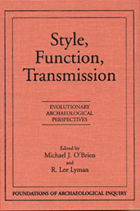 Style, Function, Transmission: Evolutionary Archaeological Perspectives
Michael J O'Brien
University of Utah Press, 2003 Darwin's theory of evolutionary descent with modification rests in part on the notion that there is heritable continuity affected by transmission between ancestor and descendant. It is precisely this continuity that allows one to trace hylogenetic histories between fossil taxa of various ages and recent taxa. Darwin was clear that were an analyst to attempt such tracings, then the anatomical characters of choice are those least influenced by natural selection, or what are today referred to as adaptively neutral traits. The transmission of these traits is influenced solely by such mechanisms as drift and not by natural selection. The application of Darwin's theory to archaeological phenomena requires that the theory be retooled to accommodate artifacts. One aspect that has undergone this retooling concerns cultural transmission, the mechanism that affects heritable continuity between cultural phenomena. Archaeologists have long traced what is readily interpreted as heritable continuity between artifacts, but the theory underpinning their tracings is seldom explicit. Thus what have been referred to as artifacts styles underpin such tracings because styles are adaptively neutral. Other traits are referred to as functional. In their introduction to Style, Function, Transmission, Michael O’Brien and R. Lee Lyman outline in detail the interrelations of a theory of cultural descent with modification and the concepts of drift, style, and function. The chapters in the volume specifically address the issues of selection and drift and their relation to style and function. In non-polemic presentations, contributors specify empirical implications of aspects of cultural transmission for evolutionary lineages of artifacts and then present archaeological data for those implications.
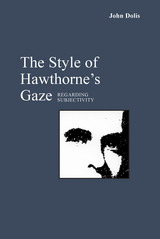 The Style of Hawthorne's Gaze: Regarding Subjectivity
John Dolis
University of Alabama Press, 1993 An exploration of Nathaniel Hawthorne’s narrative technique and unique vision of the world
The Style of Hawthorne’s Gaze is an unusual and insightful work that employs a combination of critical strategies drawn from art history, philosophy, psychoanalysis, and contemporary aesthetic and literary theory to explore Nathaniel Hawthorne’s narrative technique and his unique vision of the world. Dolis studies Hawthorne’s anti-technological and essentially Romantic view of the external world and examines the recurring phenomena of lighting, motion, aspectivity, fragmentation, and imagination as they relate to his descriptive techniques. Dolis sets the world of Hawthorne’s work over and against the aesthetic and philosophical development of the world understood as a “view”, from its inception in the camera obscura and perspective in general, to its 19th-century articulation in photography. In light of this general technology of the image, and drawing upon a wide range of contemporary critical theories, Dolis begins his study of Hawthorne at the level of description, where the world of the work first arises in the reader’s consciousness. Dolis shows how the work of Heidegger, Merleau-Ponty, Freud, Lacan, and Derrida can provide fresh insights into the sophisticated style of Hawthorne’s perception of and system for representing reality.
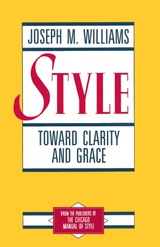 Style: Toward Clarity and Grace
Joseph M. Williams
University of Chicago Press, 1990 This acclaimed book is a master teacher's tested program for turning clumsy prose into clear, powerful, and effective writing. A logical, expert, easy-to-use plan for achieving excellence in expression, Style offers neither simplistic rules nor endless lists of dos and don'ts. Rather, Joseph Williams explains how to be concise, how to be focused, how to be organized. Filled with realistic examples of good, bad, and better writing, and step-by-step strategies for crafting a sentence or organizing a paragraph, Style does much more than teach mechanics: it helps anyone who must write clearly and persuasively transform even the roughest of drafts into a polished work of clarity, coherence, impact, and personality.
"Buy Williams's book. And dig out from storage your dog-eared old copy of The Elements of Style. Set them side by side on your reference shelf."—Barbara Walraff, Atlantic
"Let newcoming writers discover this, and let their teachers and readers rejoice. It is a practical, disciplined text that is also a pleasure to read."— Christian Century
"An excellent book....It provides a sensible, well-balanced approach, featuring prescriptions that work."—Donald Karzenski, Journal of Business Communication
"Intensive fitness training for the expressive mind."— Booklist
(The college textbook version, Style: Ten Lessons in Clarity and Grace, 9th edition, is available from Longman. ISBN 9780321479358.)
Styles of Reasoning in the British Life Sciences: Shared Assumptions, 1820–1858
James Elwick
University of Pittsburgh Press, 2007 Elwick explores how the concept of "compound individuality" brought together life scientists working in pre-Darwinian London. Scientists conducting research in comparative anatomy, physiology, cellular microscopy, embryology and the neurosciences repeatedly stated that plants and animals were compounds of smaller independent units. Discussion of a "bodily economy" was widespread. But by 1860, the most flamboyant discussions of compound individuality had come to an end in Britain. Elwick relates the growth and decline of questions about compound individuality to wider nineteenth-century debates about research standards and causality. He uses specific technical case studies to address overarching themes of reason and scientific method.
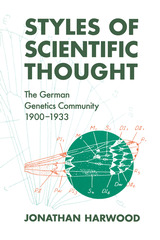 Styles of Scientific Thought: The German Genetics Community, 1900-1933
Jonathan Harwood
University of Chicago Press, 1992 In this detailed historical and sociological study of the development of scientific ideas, Jonathan Harwood argues that there is no such thing as a unitary scientific method driven by an internal logic. Rather, there are national styles of science that are defined by different values, norms, assumptions, research traditions, and funding patterns.
The first book-length treatment of genetics in Germany, Styles of Scientific Thought demonstrates the influence of culture on science by comparing the American with the German scientific traditions. Harwood examines the structure of academic and research institutions, the educational backgrounds of geneticists, and cultural traditions, among many factors, to explain why the American approach was much more narrowly focussed than the German.
This tremendously rich book fills a gap between histories of the physical sciences in the Weimar Republic and other works on the humanities and the arts during the intellectually innovative 1920s, and it will interest European historians, as well as sociologists and philosophers of science.
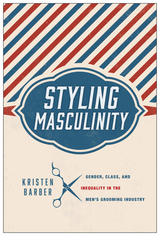 Styling Masculinity: Gender, Class, and Inequality in the Men's Grooming Industry
Barber, Kristen
Rutgers University Press, 2016 The twenty-first century has seen the emergence of a new style of man: the metrosexual. Overwhelmingly straight, white, and wealthy, these impeccably coiffed urban professionals spend big money on everything from facials to pedicures, all part of a multi-billion-dollar male grooming industry. Yet as this innovative study reveals, even as the industry encourages men to invest more in their appearance, it still relies on women to do much of the work. Styling Masculinity investigates how men’s beauty salons have persuaded their clientele to regard them as masculine spaces. To answer this question, sociologist Kristen Barber goes inside Adonis and The Executive, two upscale men’s salons in Southern California. Conducting detailed observations and extensive interviews with both customers and employees, she shows how female salon workers not only perform the physical labor of snipping, tweezing, waxing, and exfoliating, but also perform the emotional labor of pampering their clients and pumping up their masculine egos. Letting salon employees tell their own stories, Barber not only documents occasions when these workers are objectified and demeaned, but also explores how their jobs allow for creativity and confer a degree of professional dignity. In the process, she traces the vast network of economic and social relations that undergird the burgeoning male beauty industry.
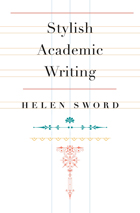 Stylish Academic Writing
Helen Sword
Harvard University Press, 2011 Elegant data and ideas deserve elegant expression, argues Helen Sword in this lively guide to academic writing. For scholars frustrated with disciplinary conventions, and for specialists who want to write for a larger audience but are unsure where to begin, here are imaginative, practical, witty pointers that show how to make articles and books a pleasure to read—and to write.
Dispelling the myth that you cannot get published without writing wordy, impersonal prose, Sword shows how much journal editors and readers welcome work that avoids excessive jargon and abstraction. Sword’s analysis of more than a thousand peer-reviewed articles across a wide range of fields documents a startling gap between how academics typically describe good writing and the turgid prose they regularly produce.
Stylish Academic Writing showcases a range of scholars from the sciences, humanities, and social sciences who write with vividness and panache. Individual chapters take up specific elements of style, such as titles and headings, chapter openings, and structure, and close with examples of transferable techniques that any writer can master.
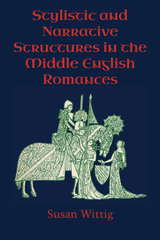 Stylistic and Narrative Structures in the Middle English Romances
By Susan Wittig
University of Texas Press, 1978 This volume provides a generic description, based on a formal analysis of narrative structures, of the Middle English noncyclic verse romances. As a group, these poems have long resisted generic definition and are traditionally considered to be a conglomerate of unrelated tales held together in a historical matrix of similar themes and characters. As single narratives, they are thought of as random collections of events loosely structured in chronological succession. Susan Wittig, however, offers evidence that the romances are carefully ordered (although not always consciously so) according to a series of formulaic patterns and that their structures serve as vehicles for certain essential cultural patterns and are important to the preservation of some community-held beliefs. The analysis begins on a stylistic level, and the same theoretical principles applied to the linguistic formulas of the poems also serve as a model for the study of narrative structures. The author finds that there are laws that govern the creation, selection, and arrangement of narrative materials in the romance genre and that act to restrict innovation and control the narrative form. The reasons for this strict control are to be found in the functional relationship of the genre to the culture that produced it. The deep structure of the romance is viewed as a problem-solving pattern that enables the community to mediate important contradictions within its social, economic, and mythic structures. Wittig speculates that these contradictions may lie in the social structures of kinship and marriage and that they have been restructured in the narratives in a “practical” myth: the concept of power gained through the marriage alliance, and the reconciliation of the contradictory notions of marriage for power’s sake and marriage for love’s sake. This advanced, thorough, and completely original study will be valuable to medieval specialists, classicists, linguists, folklorists, and Biblical scholars working in oral-formulaic narrative structure.
Styrbiorn the Strong
E. R. Eddison
University of Minnesota Press, 2011 E. R. Eddison’s classic saga novel now in paperback—includes for the first time Eddison’s remarkable letter of introduction and his unabridged closing note Styrbiorn the Strong tells the grand tale of Styrbiorn Olafsson, heir to the Swedish throne and known both for his impressive size and strength and his unruly, quarrelsome nature. Denied his birthright and exiled from Sweden, Styrbiorn becomes the leader of the Jomsvikings and sets out to reclaim the Swedish throne in the epic Battle of Fýrisvellir. A rediscovered classic, Styrbiorn the Strong is a tale reminiscent of the Old Norse sagas, a historical novel from one of the twentieth century’s most influential masters of fantasy.
Su Friedrich
Barbara Mennel
University of Illinois Press, 2023 Auteurism expanded With acclaimed films like Sink or Swim and The Odds of Recovery, Su Friedrich’s body of work stands at the forefront of avant-garde and Queer cinema. Barbara Mennel examines the career of an experimental auteur whose merger of technical innovation and political critique connects with both cinephiles and activists. Friedrich’s integration of cinematic experimentation with lesbian advocacy serves as a beginning rather than an end point of analysis. With that in mind, Mennel provides an essential overview of the filmmaker’s oeuvre while highlighting the defining characteristics of her artistic and political signature. She also situates Friedrich within the cultural, political, and historical contexts that both shape the films and are shaped by them. Finally, Mennel expands our notion of auteurism to include directors who engage in collaborative and creative processes rooted in communities.
The Sub: A Study in Witchcraft
Thomas M. Disch
University of Minnesota Press, 2010
The Sub, the fourth novel in Thomas M. Disch's Supernatural Minnesota series, which uses different supernatural horrors to satirize modern America, focuses on Diana Turney, a substitute teacher in the town of Leech Lake, Minnesota, left to care for her niece after her sister is imprisoned for the attempted murder of her philandering husband. Haunted by her father's ghost and disturbing repressed memories, Diana discovers she has the power to turn people into their animal totems and proceeds to transform locals into an array of creatures from spiders to pigs. Diana, her cruelty growing in proportion to her power, dismisses a warning from her father's ghost that she is destined to kill everyone she loves and continues on a spree of violence and mayhem.
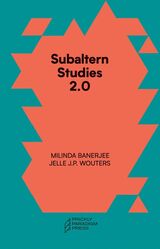 Subaltern Studies 2.0: Being against the Capitalocene
Milinda Banerjee and Jelle J.P. Wouters
Prickly Paradigm Press, 2022 On a second wave of anti-colonial revolutions.
State and Capital reign over the Age of Sorrow. We face inequality, pandemics, ethnocide, climate crisis, and mass extinction. Our desire for security and power governs us as State. Our desire for possessions governs us as Capital. Our desires imprison and rule us beings as Unbeing. Yet, from Nagaland to New Zealand, Bhutan to Bolivia, a second wave of anti-colonial revolutions has begun. Arising from assemblies of humans and other-than-humans, these revolutions replace possessive individualism with non-exploitative interdependence. Naga elders, Bhutanese herders and other indigenous communities, feminists, poets, seers, yaks, cranes, vultures, and fungi haunt this pamphlet. The original Subaltern Studies narrated how Indian peasant communities destroyed the British empire. Subaltern Studies 2.0 prophesies the multi-being demos and liberates Being from Unbeing. Re-kin, Re-nomad, Re-animate, Re-wild! The Animist Revolution has come.
 The Subaltern Ulysses
Enda Duffy
University of Minnesota Press, 1994 The Subaltern Ulysses was first published in 1994. Minnesota Archive Editions uses digital technology to make long-unavailable books once again accessible, and are published unaltered from the original University of Minnesota Press editions. How might an IRA bomb and James Joyce's Ulysses have anything in common? Could this masterpiece of modernism, written at the violent moment of Ireland's national emergence, actually be the first postcolonial novel? Exploring the relation of Ulysses to the colony in which it is set, and to the nation being born as the book was written, Enda Duffy uncovers a postcolonial modernism and in so doing traces another unsuspected strain within the one-time critical monolith. In the years between 1914 and 1921, as Joyce was composing his text, Ireland became the first colony of the British Empire to gain its independence in this century after a violent anticolonial war. Duffy juxtaposes Ulysses with documents and photographs from the archives of both empire and insurgency, as well as with recent postcolonial literary texts, to analyze the political unconscious of subversive strategies, twists on class and gender, that render patriarchal colonialist culture unfamiliar. Ulysses, Duffy argues, is actually a guerrilla text, and here he shows how Joyce's novel pinpoints colonial regimes of surveillance, mocks imperial stereotypes of the "native," exposes nationalism and other chauvinistic ideologies of "imagined community" as throwbacks to the colonial ethos, and proposes versions of a postcolonial subject. A significant intervention in the massive "Joyce industry" founded on the rhetoric and aesthetics of high modernism, Duffy's insights show us not only Ulysses, but also the origins of postcolonial textuality, in a startling new way. Enda Duffy is assistant professor of English at the University of California at Santa Barbara.
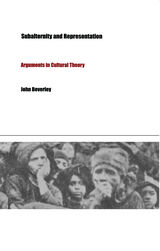 Subalternity and Representation: Arguments in Cultural Theory
John Beverley
Duke University Press, 1999 The term “subalternity” refers to a condition of subordination brought about by colonization or other forms of economic, social, racial, linguistic, and/or cultural dominance. Subaltern studies is, therefore, a study of power. Who has it and who does not. Who is gaining it and who is losing it. Power is intimately related to questions of representation—to which representations have cognitive authority and can secure hegemony and which do not and cannot. In this book John Beverley examines the relationship between subalternity and representation by analyzing the ways in which that relationship has been played out in the domain of Latin American studies. Dismissed by some as simply another new fashion in the critique of culture and by others as a postmarxist heresy, subaltern studies began with the work of Ranajit Guha and the South Asian Subaltern Studies collective in the 1980s. Beverley’s focus on Latin America, however, is evidence of the growing province of this field. In assessing subaltern studies’ purposes and methods, the potential dangers it presents, and its interactions with deconstruction, poststructuralism, cultural studies, Marxism, and political theory, Beverley builds his discussion around a single, provocative question: How can academic knowledge seek to represent the subaltern when that knowledge is itself implicated in the practices that construct the subaltern as such? In his search for answers, he grapples with a number of issues, notably the 1998 debate between David Stoll and Rigoberta Menchú over her award-winning testimonial narrative, I, Rigoberta Menchú. Other topics explored include the concept of civil society, Florencia Mallon’s influential Peasant and Nation, the relationship between the Latin American “lettered city” and the Túpac Amaru rebellion of 1780–1783, the ideas of transculturation and hybridity in postcolonial studies and Latin American cultural studies, multiculturalism, and the relationship between populism, popular culture, and the “national-popular” in conditions of globalization. This critique and defense of subaltern studies offers a compendium of insights into a new form of knowledge and knowledge production. It will interest those studying postcolonialism, political science, cultural studies, and Latin American culture, history, and literature.
Subalternity, Antagonism, Autonomy: Constructing the Political Subject
Massimo Modonesi
Pluto Press, 2013 In this bold and innovative book, Massimo Modonesi weaves together theory and political practice by relating the concepts of subalternity, antagonism and autonomy to contemporary movements in Latin America and elsewhere.
In a sophisticated account, Modonesi reconstructs the debates between Marxist authors and schools of thought in order to sketch out informed strategies of resistance. He reviews the works of Gramsci, Negri, Castoriadis and Lefort, and engages with the arguments made by E. P. Thompson, Spivak, Laclau and Mouffe.
Subalternity, Antagonism, Autonomy firmly roots key theoretical arguments from a range of critical thinkers within specific political movements in order to recover these concepts as analytical instruments which can help to guide contemporary struggles.
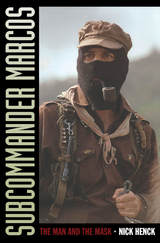 Subcommander Marcos: The Man and the Mask
Nick Henck
Duke University Press, 2007 Subcommander Marcos made his debut on the world stage on January 1, 1994, the day the North American Free Trade Agreement took effect. At dawn, from a town-hall balcony he announced that the Zapatista Army of National Liberation had seized several towns in the Mexican state of Chiapas in rebellion against the government; by sunset Marcos was on his way to becoming the most famous guerrilla leader since Che Guevara. Subsequently, through a succession of interviews, communiqués, and public spectacles, the Subcommander emerged as a charismatic spokesperson for the indigenous Zapatista uprising and a rallying figure in the international anti-globalization movement. In this, the first English-language biography of Subcommander Marcos, Nick Henck describes the thought, leadership, and personality of this charismatic rebel spokesperson. He traces Marcos’s development from his provincial middle-class upbringing, through his academic career and immersion in the clandestine world of armed guerrillas, to his emergence as the iconic Subcommander. Henck reflects on what motivated an urbane university professor to reject a life of comfort in Mexico City in favor of one of hardship as a guerrilla in the mountainous jungles of Chiapas, and he examines how Marcos became a conduit through which impoverished indigenous Mexicans could communicate with the world. Henck fully explores both the rebel leader’s renowned media savvy and his equally important flexibility of mind. He shows how Marcos’s speeches and extensive writings demonstrate not only the Subcommander’s erudition but also his rejection of Marxist dogmatism. Finally, Henck contextualizes Marcos, locating him firmly within the Latin American guerrilla tradition.
 Subcontinental Drift: Domestic Politics and India's Foreign Policy
Rajesh Basrur
Georgetown University Press How domestic constraints hamper India’s foreign policy and its potential as a superpower One of the most important developments in today’s changing international system is the emergence of India as a rising power. However, Rajesh Basrur finds that India is hobbled by serious domestic constraints. Subcontinental Drift explains why India’s foreign policy is often characterized by multiple hesitations, delays, and diversions that may ultimately hamper its rise. Basrur analyzes the concept of policy drift through the lens of neoclassical realist theory to reveal why this drift occurs so regularly in Indian foreign policy and how it affects India’s quest for major power status. Using four cases—the India-US strategic partnership, India-Sri Lanka relations, India’s nuclear strategy, and crossborder terrorism—Basrur identifies two basic explanations for India’s indecision on critical issues. The first, involuntary drift, is related to the distribution of domestic material power, while the second, voluntary drift, is produced by a responsibility deficit. Basrur develops a fresh theoretical basis for understanding the relationship between India’s foreign and domestic policies and introduces a series of theoretical refinements to neoclassical realism. Subcontinental Drift also provides advice on how policy makers might lower the costs of policy drift. This innovative analysis is essential to understanding the constraints around India’s foreign and domestic security decisions and how they will affect its rise.
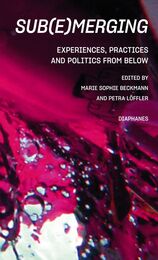 Sub(e)merging: Experiences, Practices and Politics from Below
Edited by Marie Sophie Beckmann and Petra Löffler
Diaphanes, 2025 A cross-disciplinary perspective of the medial, aesthetic, and material aspects of submerging, as well as its methodological qualities as a resistant practice and figure of thought.
Whether it is the ocean, the ground, or soil, a metaphorical or symbolic underworld, or a political figure of thought, the subsurface intervenes in recent debates about ecological, social, and postcolonial conflicts and power inequalities in the humanities and beyond. However, turning to the unstable grounds of the subterranean always involves a conceptual or methodological movement and a practice of submersion, and thus a critical reflection on the conditions, technologies, aesthetics, and politics of knowledge production.
It is precisely at this point that this volume picks up with approaches from the fields of artistic practice as well as media studies, art history, queer theory, and decolonial studies. From this transdisciplinary perspective, this anthology explores the medial, aesthetic, and material aspects of sub(e)merging, as well as its potential as a resistant practice and figure of thought: from submerging to emerging.
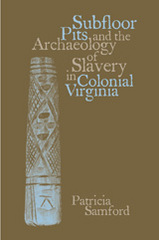 Subfloor Pits and the Archaeology of Slavery in Colonial Virginia
Patricia Samford
University of Alabama Press, 2007 Investigates the development of hypotheses about how West African, possibly Igbo, cultural traditions were maintained and transformed in the Virginia Chesapeake
Enslaved Africans and their descendants comprised a significant portion of colonial Virginia populations, with most living on rural slave quarters adjacent to the agricultural fields in which they labored. Archaeological excavations into these home sites have provided unique windows into the daily lifeways and culture of these early inhabitants. A common characteristic of Virginia slave quarters is the presence of subfloor pits beneath the houses. The most common explanations of the functions of these pits are as storage places for personal belongings or root vegetables, and some contextual and ethnohistoric data suggest they may have served as West Africa-style shrines. Through excavations of 103 subfloor pits dating from the 17th through mid-19th centuries, Samford reveals a wealth of data including shape, location, surface area, and depth, as well as contents and patterns of related feature placement. Archaeology reveals the material circumstances of slaves’ lives, which in turn opens the door to illuminating other aspects of life: spirituality, symbolic meanings assigned to material goods, social life, individual and group agency, and acts of resistance and accommodation. Analysis of the artifact assemblages allows the development of hypotheses about how West African, possibly Igbo, cultural traditions were maintained and transformed in the Virginia Chesapeake.
 The Subhāṣitaratnakoṣa
Vidyākara
Harvard University Press This edition of the Sanskrit text of the Subhāṣitaratnakoṣa—in the editors’ opinion the oldest known general anthology of Sanskrit verse—is the result of years of work deciphering and comparing the five different versions to arrive at a complete and reliable text. The editors’ aim has been to restore, as far as the sources permit, the text compiled by Vidyākara somewhere between A.D. 1100 and 1130. In the absence of written records from the period, studies such as this one are invaluable as sources of information about the literary and cultural history of eleventh century India, especially about Sanskrit poets, and also about the changes of ideas since the eleventh century as they have affected the versions compiled since Vidyākara’s. Included with the complete Sanskrit text and footnotes to the stanzas is an introductory section in which D. D. Kosambi discusses in detail the various versions in existence, the cultural background, and the authors and sources of individual verses.
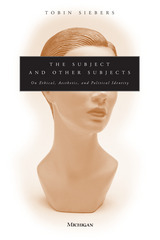 The Subject and Other Subjects: On Ethical, Aesthetic, and Political Identity
Tobin Siebers
University of Michigan Press, 1998 The Subject and Other Subjects theorizes the differences among ethical, aesthetic, and political conceptions of identity. When a person is called beautiful, why does it strike us as an objectification? Is a person whom we consider to be an exemplary person still a person, and not an example? Can one person conceive what it means to have the perspective of a community? This study treats these thorny issues in the context of recent debates in cultural studies, feminism, literary criticism, narrative theory, and moral philosophy concerning the nature and directions of multiculturalism, post-modernity, and sexual politics.
Tobin Siebers raises a series of questions that "cross the wires" among ethical, aesthetic, and political definitions of the self, at once exposing our basic assumptions about these definitions and beginning the work of reconceiving them. The Subject and Other Subjects will broaden our ideas about the strange interplay between subjects and objects (and other subjects!) that characterizes modern identity, and so provoke lively debate among anthropologists, art historians, literary theorists, philosophers, and others concerned with how the question of the subject becomes entangled with ethics, aesthetics, and politics. As Siebers argues, the subject is in fact a tangled network of subjectivities, a matrix of identities inconceivable outside of symbols and stories.
Tobin Siebers is Professor of English at the University of Michigan, and author of Cold War Criticism and the Politics of Skepticism; Morals and Stories; The Ethics of Criticism; The Romantic Fantastic; and The Mirror of Medusa.
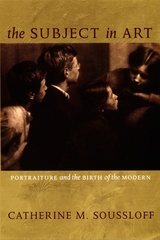 The Subject in Art: Portraiture and the Birth of the Modern
Catherine M. Soussloff
Duke University Press, 2006 Challenging prevailing theories regarding the birth of the subject, Catherine M. Soussloff argues that the modern subject did not emerge from psychoanalysis or existential philosophy but rather in the theory and practice of portraiture in early-twentieth-century Vienna. Soussloff traces the development in Vienna of an ethics of representation that emphasized subjects as socially and historically constructed selves who could only be understood—and understand themselves—in relation to others, including the portrait painters and the viewers. In this beautifully illustrated book, she demonstrates both how portrait painters began to focus on the interior lives of their subjects and how the discipline of art history developed around the genre of portraiture. Soussloff combines a historically grounded examination of art and art historical thinking in Vienna with subsequent theories of portraiture and a careful historiography of philosophical and psychoanalytic approaches to human consciousness from Hegel to Sartre and from Freud to Lacan. She chronicles the emergence of a social theory of art among the art historians of the Vienna School, demonstrates how the Expressionist painter Oskar Kokoschka depicted the Jewish subject, and explores the development of pictorialist photography. Reflecting on the implications of the visualized, modern subject for textual and linguistic analyses of subjectivity, Soussloff concludes that the Viennese art historians, photographers, and painters will henceforth have to be recognized as precursors to such better-known theorists of the subject as Sartre, Foucault, and Lacan.
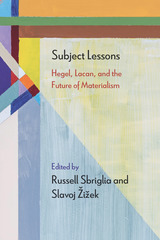 Subject Lessons: Hegel, Lacan, and the Future of Materialism
Edited by Russell Sbriglia and Slavoj Zizek
Northwestern University Press, 2020 Responding to the ongoing “objectal turn” in contemporary humanities and social sciences, the essays in Subject Lessons present a sustained case for the continued importance— indeed, the indispensability—of the category of the subject for the future of materialist thought.
Approaching matters through the frame of Hegel and Lacan, the contributors to this volume, including the editors, as well as Andrew Cole, Mladen Dolar, Nathan Gorelick, Adrian Johnston, Todd McGowan, Borna Radnik, Molly Anne Rothenberg, Kathryn Van Wert, and Alenka Zupančič—many of whom stand at the forefront of contemporary Hegel and Lacan scholarship—agree with neovitalist thinkers that material reality is ontologically incomplete, in a state of perpetual becoming, yet they maintain that this is the case not in spite of but, rather, because of the subject.
Incorporating elements of philosophy, psychoanalysis, and literary and cultural studies, Subject Lessons contests the movement to dismiss the subject, arguing that there can be no truly robust materialism without accounting for the little piece of the Real that is the subject.
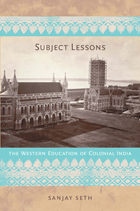 Subject Lessons: The Western Education of Colonial India
Sanjay Seth
Duke University Press, 2007 Subject Lessons offers a fascinating account of how western knowledge “traveled” to India, changed that which it encountered, and was itself transformed in the process. Beginning in 1835, India’s British rulers funded schools and universities to disseminate modern, western knowledge in the expectation that it would gradually replace indigenous ways of knowing. From the start, western education was endowed with great significance in India, not only by the colonizers but also by the colonized, to the extent that today almost all “serious” knowledge about India—even within India—is based on western epistemologies. In Subject Lessons, Sanjay Seth’s investigation into how western knowledge was received by Indians under colonial rule becomes a broader inquiry into how modern, western epistemology came to be seen not merely as one way of knowing among others but as knowledge itself. Drawing on history, political science, anthropology, and philosophy, Seth interprets the debates and controversies that came to surround western education. Central among these were concerns that Indian students were acquiring western education by rote memorization—and were therefore not acquiring “true knowledge”—and that western education had plunged Indian students into a moral crisis, leaving them torn between modern, western knowledge and traditional Indian beliefs. Seth argues that these concerns, voiced by the British as well as by nationalists, reflected the anxiety that western education was failing to produce the modern subjects it presupposed. This failure suggested that western knowledge was not the universal epistemology it was thought to be. Turning to the production of collective identities, Seth illuminates the nationalists’ position vis-à-vis western education—which they both sought and criticized—through analyses of discussions about the education of Muslims and women.
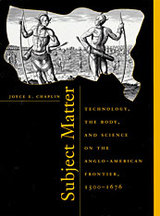 Subject Matter: Technology, the Body, and Science on the Anglo-American Frontier, 1500-1676
Joyce E. Chaplin
Harvard University Press, 2003 With this sweeping reinterpretation of early cultural encounters between the English and American natives, Joyce E. Chaplin thoroughly alters our historical view of the origins of English presumptions of racial superiority, and of the role science and technology played in shaping these notions. By placing the history of science and medicine at the very center of the story of early English colonization, Chaplin shows how contemporary European theories of nature and science dramatically influenced relations between the English and Indians within the formation of the British Empire.
In Chaplin's account of the earliest contacts, we find the English--impressed by the Indians' way with food, tools, and iron--inclined to consider Indians as partners in the conquest and control of nature. Only when it came to the Indians' bodies, so susceptible to disease, were the English confident in their superiority. Chaplin traces the way in which this tentative notion of racial inferiority hardened and expanded to include the Indians' once admirable mental and technical capacities. Here we see how the English, beginning from a sense of bodily superiority, moved little by little toward the idea of their mastery over nature, America, and the Indians--and how this progression is inextricably linked to the impetus and rationale for empire.
 The Subject Matters: Classroom Activity in Math and Social Studies
Susan S. Stodolsky
University of Chicago Press, 1988 To achieve quality education in American schools, we need a better understanding of the way classroom instruction works. Susan S. Stodolsky addresses this need with her pioneering analysis of the interrelations between forms of instruction, levels of student involvement, and subject matter. Her intensive observation of fifth-grade math and social studies classes reveals that subject matter, a variable overlooked in recent research, has a profound effect on instructional practice.
Stodolsky presents a challenge to educational research. She shows that classroom activities are coherent actions shaped by the instructional context—especially what is taught. Stodolsky contradicts the received view of both teaching and learning as uniform and consistent. Individual teachers arrange instruction very differently, depending on what they are teaching, and students respond to instruction very differently, depending on the structure and demands of the lesson.
The instructional forms used in math classes, a "basic" subject, and social studies classes, an "enrichment" subject, differ even when the same teacher conducts both classes. Social studies classes show more diversity in activities, while math classes are very similar to one another. Greater variety is found in social studies within a given teacher's class and when different teachers' classes are compared. Nevertheless, in the classrooms Stodolsky studied, the range of instructional arrangements is very constricted.
Challenging the "back to basics" movement, Stodolsky's study indicates that, regardless of subject matter, students are more responsive to instruction that requires a higher degree of intellectual complexity and performance, to learning situations that involve them in interaction with their peers, and to active modes of learning. Stodolsky also argues that students develop ideas about how to learn a school subject, such as math, by participating in particular activities tied to instruction in the subject. These conceptions about learning are unplanned but enduring and significant consequences of schooling.
The Subject Matters has important implications for instructional practice and the training, education, and supervision of teachers. Here is a new way of understanding the dynamics of teaching and learning that will transform how we think about schools and how we study them.
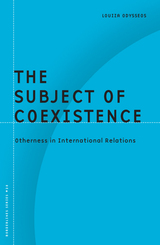 The Subject of Coexistence: Otherness in International Relations
Louiza Odysseos
University of Minnesota Press, 2007 In this pioneering book, Louiza Odysseos argues that debates about ethnic conflict, human rights, and the viability of multicultural communities all revolve around the question of coexistence. Yet, issues of coexistence have not been adequately addressed by international relations. Instead of being regarded as a question, “coexistence” is a term whose meaning is considered self-evident. The Subject of Coexistence traces the institutional neglect of coexistence to the ontological commitments of international relations as a modern social science predicated on conceptions of modern subjectivity. This reliance leads to the assumption that coexistence means little more than the social and political copresence of individuals, a premise that occludes the roles of otherness in the constitution of the self. Countering this reliance necessitates the examination of how existence itself is coexistential from the start. Odysseos opens up the possibility of a coexistential ontology, drawing on Martin Heidegger and his interlocutors, in which selfhood can be rethought beyond subjectivism, reinstating coexistence as a question for global politics—away from the restrictive discursive parameters of the modern subject. Louiza Odysseos is senior lecturer in international relations at the University of Sussex.
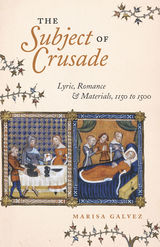 The Subject of Crusade: Lyric, Romance, and Materials, 1150 to 1500
Marisa Galvez
University of Chicago Press, 2020 In the Middle Ages, religious crusaders took up arms, prayed, bade farewell to their families, and marched off to fight in holy wars. These Christian soldiers also created accounts of their lives in lyric poetry, putting words to the experience of personal sacrifice and the pious struggle associated with holy war. The crusaders affirmed their commitment to fighting to claim a distant land while revealing their feelings as they left behind their loved ones, homes, and earthly duties. Their poems and related visual works offer us insight into the crusaders’ lives and values at the boundaries of earthly and spiritual duties, body and soul, holy devotion and courtly love.
In The Subject of Crusade, Marisa Galvez offers a nuanced view of holy war and crusade poetry, reading these lyric works within a wider conversation with religion and culture. Arguing for an interdisciplinary treatment of crusade lyric, she shows how such poems are crucial for understanding the crusades as a complex cultural and historical phenomenon. Placing them in conversation with chronicles, knightly handbooks, artworks, and confessional and pastoral texts, she identifies a particular “crusade idiom” that emerged out of the conflict between pious and earthly duties. Galvez fashions an expanded understanding of the creative works made by crusaders to reveal their experiences, desires, ideologies, and reasons for taking up the cross.
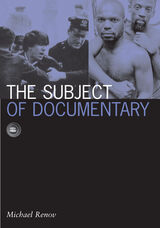 Subject Of Documentary
Michael Renov
University of Minnesota Press, 2004 The documentary, a genre as old as cinema itself, has traditionally aspired to objectivity. Whether making ethnographic, propagandistic, or educational films, documentarians have pointed the camera outward, drawing as little attention to themselves as possible. In recent decades, however, a new kind of documentary has emerged in which the filmmaker has become the subject of the work. Whether chronicling family history, sexual identity, or a personal or social world, this new generation of nonfiction filmmakers has defiantly embraced autobiography. In The Subject of Documentary, Michael Renov focuses on how documentary filmmaking has become an important means for both examining and constructing selfhood. By looking at key figures in documentary filmmaking as well as noncanonical video art and avant-garde artists, Renov broadens the definition of what counts as documentary, and explores the intersection of the personal and political, considering how memory can create a way into asking troubling questions about identity, oppression, and resiliency. Offering historical context for the explosion of personal nonfiction filmmaking in the 1980s and 1990s, Renov analyzes films in which the subjectivity of the filmmaker is expressly defined in relation to political struggle or historical trauma, from Haskell Wexler's Medium Cool to Jonas Mekas's Lost, Lost, Lost. And, looking beyond the traditional documentary, Renov contemplates such nontraditional modes of autobiographical practice as the essay film, the video confession, and the personal Web page.Unique in its attention to diverse expressions of personal nonfiction filmmaking, The Subject of Documentary forges a new understanding of the heightened role and function of subjectivity in contemporary documentary practice.Michael Renov is professor of critical studies at the USC School of Cinema-Television. He is the editor of Theorizing Documentary and the coeditor of Resolutions: Contemporary Video Practices (Minnesota, 1996) and Collecting Visible Evidence (Minnesota, 1999).
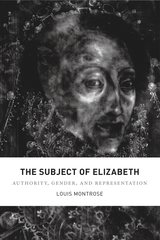 The Subject of Elizabeth: Authority, Gender, and Representation
Louis Montrose
University of Chicago Press, 2006 As a woman wielding public authority, Elizabeth I embodied a paradox at the very center of sixteenth-century patriarchal English society. Louis Montrose’s long-awaited book, The Subject of Elizabeth, illuminates the ways in which the Queen and her subjects variously exploited or obfuscated this contradiction.
Montrose offers a masterful account of the texts, pictures, and performances in which the Queen was represented to her people, to her court, to foreign powers, and to Elizabeth herself. Retrieving this “Elizabethan imaginary” in all its richness and fascination, Montrose presents a sweeping new account of Elizabethan political culture. Along the way, he explores the representation of Elizabeth within the traditions of Tudor dynastic portraiture; explains the symbolic manipulation of Elizabeth’s body by both supporters and enemies of her regime; and considers how Elizabeth’s advancing age provided new occasions for misogynistic subversions of her royal charisma.
This book, the remarkable product of two decades of study by one of our most respected Renaissance scholars, will be welcomed by all historians, literary scholars, and art historians of the period.
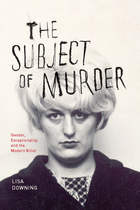 The Subject of Murder: Gender, Exceptionality, and the Modern Killer
Lisa Downing
University of Chicago Press, 2013 The subject of murder has always held a particular fascination for us. But, since at least the nineteenth century, we have seen the murderer as different from the ordinary citizen—a special individual, like an artist or a genius, who exists apart from the moral majority, a sovereign self who obeys only the destructive urge, sometimes even commanding cult followings. In contemporary culture, we continue to believe that there is something different and exceptional about killers, but is the murderer such a distinctive type? Are they degenerate beasts or supermen as they have been depicted on the page and the screen? Or are murderers something else entirely?
In The Subject of Murder, Lisa Downing explores the ways in which the figure of the murderer has been made to signify a specific kind of social subject in Western modernity. Drawing on the work of Foucault in her studies of the lives and crimes of killers in Europe and the United States, Downing interrogates the meanings of media and texts produced about and by murderers. Upending the usual treatment of murderers as isolated figures or exceptional individuals, Downing argues that they are ordinary people, reflections of our society at the intersections of gender, agency, desire, and violence.
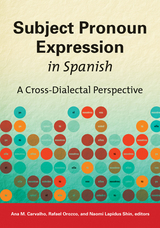 Subject Pronoun Expression in Spanish: A Cross-Dialectal Perspective
Ana M. Carvalho, Rafael Orozco, and Naomi Lapidus Shin, Editors
Georgetown University Press Much recent scholarship has sought to identify the linguistic and social factors that favor the expression or omission of subject pronouns in Spanish. This volume brings together leading experts on the topic of language variation in Spanish to provide a panoramic view of research trends, develop probabilistic models of grammar, and investigate the impact of language contact on pronoun expression. The book consists of three sections. The first studies the distributional patterns and conditioning forces on subject pronoun expression in four monolingual varieties—Dominican, Colombian, Mexican, and Peninsular—and makes cross-dialectal comparisons. In the second section, experts explore Spanish in contact with English, Maya, Catalan, and Portuguese to determine the extent to which each language influences this syntactic variable. The final section examines the acquisition of variable subject pronoun expression among monolingual and bilingual children as well as adult second language learners.
 Subject Pronoun Expression in Spanish: A Cross-Dialectal Perspective
Ana M. Carvalho
Georgetown University Press "[A] superb collection of studies that substantially increases our understanding, not only of variation in subject personal pronouns, but also of variable morphosyntactic processes generally.... clearly relevant to all students and scholars who wish to understand the complexities of linguistic variation and dialect contact." -- Robert Bayley, professor of linguistics, University of California, Davis "Students and scholars will find that this volume is an essential reference in the field of Spanish language variation. If the study of final /s/ has led Spanish sociophonetics, the study of subject pronouns stars in sociogrammar. This volume presents a 3D analysis of how subject pronouns are used and acquired in Spanish. This comprehensive volume is not only of interest to those concerned with Spanish grammar, but also to anyone interested in pro-drop languages. The vision of Carvalho, Orozco and Shin has harmonized an excellent collective volume." -- Francisco Moreno-Fernández, professor of Hispanic linguistics. University of Alcala (Spain) and Instituto Cervantes at Harvard University. , "If you seek innovative, theoretically and empirically driven research into syntactic variation, open this book and read on. Here a variationist focus on alternating sound and silence, something and nothing, or subject pronouns and nulls generates striking insights into the nature of Spanish and those who speak and learn it." -- Richard Cameron,, University of Illinois at Chicago
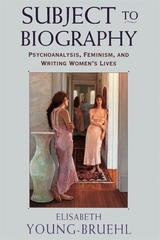 Subject to Biography: Psychoanalysis, Feminism, and Writing Women’s Lives
Elisabeth Young-Bruehl
Harvard University Press, 1998 In this provocative new book, Elisabeth Young-Bruehl illuminates the psychological and intellectual demands writing biography makes on the biographer and explores the complex and frequently conflicted relationship between feminism and psychoanalysis.
A practicing psychoanalyst, a distinguished scholar, and the widely praised biographer of Anna Freud and Hannah Arendt, Young-Bruehl here reflects on the relations between self-knowledge, autobiography, biography, and cultural history. She considers what remains valuable in Sigmund Freud's work, and what areas--theory of character, for instance--must be rethought to be useful for current psychoanalytic work, for feminist studies, and for social theory.
Psychoanalytic theory used for biography, she argues, can yield insights for psychoanalysis itself, particularly in the understanding of creativity. Subject to Biography offers not simply the products of an astute mind, but an entrée into the thinking process; it welcomes the reader into the writer's workshop.
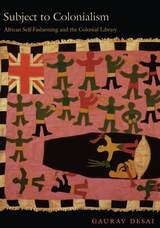 Subject to Colonialism: African Self-Fashioning and the Colonial Library
Gaurav Desai
Duke University Press, 2001 Subject to Colonialism provides a much needed revisionist perspective on the way twentieth-century Africa is viewed and analyzed among scholars. Employing literary, historical, and anthropological techniques, Gaurav Desai attempts to generate a new understanding of issues that permeate discussions of Africa by disrupting the centrality of postcolonial texts and focusing instead on the cultural and intellectual production of colonial Africans. In particular, Desai calls for a reevaluation of the “colonial library”—that set of representations and texts that have collectively “invented” Africa as a locus of difference and alterity.
Presenting colonialism not as a singular, monolithic structure but rather as a practice frought with contradictions and tensions, Desai works to historicize the foundation of postcolonialism by decentering both canonical texts and privileged categories of analysis such as race, capitalism, empire, and nation. To achieve this, he focuses on texts that construct or reform—rather than merely reflect—colonialism, placing explicit emphasis on processes, performances, and the practices of everyday life. Reading these texts not merely for the content of their assertions but also for how they were created and received, Desai looks at works such as Jomo Kenyatta’s ethnography of the Gikuyu and Akiga Sai’s history of the Tiv and makes a particular plea for the canonical recuperation of African women’s writing.
Scholars in African history, literature, and philosophy, postcolonial studies, literary criticism, and anthropology will welcome publication of this book.
Subject to Death: Life and Loss in a Buddhist World
Robert Desjarlais
University of Chicago Press, 2016 If any anthropologist living today can illuminate our dim understanding of death’s enigma, it is Robert Desjarlais. With Subject to Death, Desjarlais provides an intimate, philosophical account of death and mourning practices among Hyolmo Buddhists, an ethnically Tibetan Buddhist people from Nepal. He studies the death preparations of the Hyolmo, their specific rituals of grieving, and the practices they use to heal the psychological trauma of loss. Desjarlais’s research marks a major advance in the ethnographic study of death, dying, and grief, one with broad implications. Ethnologically nuanced, beautifully written, and twenty-five years in the making, Subject to Death is an insightful study of how fundamental aspects of human existence—identity, memory, agency, longing, bodiliness—are enacted and eventually dissolved through social and communicative practices.
 Subject to Delusions: Narcissism, Modernism, Gender
Caroline Rupprecht
Northwestern University Press, 2006 A figure of reflexivity, narcissism describes a relation between self and other mediated through the mirror or reflection. As such, the concept might help us to consider how what we come to know as the other, or the object, is always the result of a process of image-making. It is in this suggestive sense that narcissism interests Caroline Rupprecht in Subject to Delusions.
Because "the other," or the object, is constructed, Rupprecht finds in narcissism the possibility of rewriting notions of identity. She then pursues this possibility through modern literary texts in which narcissism acts as a structuring principle—works by the expressionist poet Henriette Hardenberg, the American avant-garde novelist Djuna Barnes, and the surrealist writer Unica Zürn—reading each within the critical framework of the evolution of the idea of narcissism in psychoanalytic theory. All written by women, these works also raise questions of gender and sexuality. Moreover, because each of these authors belonged to or was influenced by a particular literary movement, Rupprecht's analysis advances our understanding of the poetics of these movements and of the movement of modernism itself. Underlying all is a deep engagement with psychoanalytic theory. Drawing on Freud, his contemporaries and rivals, Jacques Lacan, Melanie Klein, and many other theorists, Rupprecht interrogates preconceived notions of identity and subjectivity through her readings of the "transgressive potential" of narcissism as it is enacted in the texts under study. Bringing the works of literary modernism and psychoanalysis together in an innovative and provocative way, her book succeeds in enhancing our sense of both, and in clarifying the complex role of narcissism in our cultural narrative.
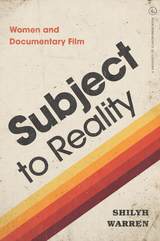 Subject to Reality: Women and Documentary Film
Shilyh Warren
University of Illinois Press, 2019 Revolutionary thinking around gender and race merged with new film technologies to usher in a wave of women's documentaries in the 1970s. Driven by the various promises of second-wave feminism, activist filmmakers believed authentic stories about women would bring more people into an imminent revolution. Yet their films soon faded into obscurity. Shilyh Warren reopens this understudied period and links it to a neglected era of women's filmmaking that took place from 1920 to 1940, another key period of thinking around documentary, race, and gender. Drawing women’s cultural expression during these two explosive times into conversation, Warren reconsiders key debates about subjectivity, feminism, realism, and documentary and their lasting epistemological and material consequences for film and feminist studies. She also excavates the lost ethnographic history of women's documentary filmmaking in the earlier era and explores the political and aesthetic legacy of these films in more explicitly feminist periods like the Seventies. Filled with challenging insights and new close readings, Subject to Reality sheds light on a profound and unexamined history of feminist documentaries while revealing their influence on the filmmakers of today.
 Subject Without Nation: Robert Musil and the History of Modern Identity
Stefan Jonsson
Duke University Press, 2001 This innovative study of the works of Robert Musil opens a new window on the history of modern identity in western culture. Stefan Jonsson argues that Musil’s Austria was the first postimperial state in modern Europe. Prior to its destruction in 1918, the Austro-Hungarian Empire had ruled over a vast array of nationalities and, in the course of its demise as well as after, Austria was beset by nationalism, racism, and other forms of identity politics that ultimately led to the triumph of Nazism.
It was to this society that Musil responded in his great work The Man Without Qualities. Exploring the nooks and crannies of this modernist classic, Jonsson shows that Musil’s narrative evolves along two axes that must be considered in tandem: Whereas the central plot portrays a Viennese elite that in 1913 attempts to restore social cohesion by gathering popular support for the cultural essence of the empire, the protagonist discovers that he lacks essence altogether and finds himself attracted by monsters, criminals, and revolutionary figures that reject the social order. In this way, Musil’s novel traces the disappearance of what Jonsson calls the expressivist paradigm—the conviction that identities such as gender, nationality, class, and social character are expressions of permanent intrinsic dispositions. This, Jonsson argues, is Musil’s great legacy. For not only did the Austrian author seek to liquidate prevailing conceptions of personal and cultural identity; he also projected “a new human being,” one who would resist assimilation into imperialist, nationalist, or fascist communities.
Subject Without Nation presents a new interpretation of Viennese modernity and uncovers the historical foundations of poststructural and postcolonial reconceptualizations of human subjectivity. Illuminating links between Musil’s oeuvre as a whole and post-war developments in critical thought, this book locates an important crossroads between literary criticism, intellectual history, and cultural theory.
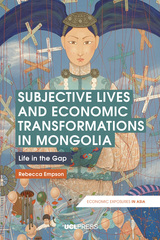 Subjective Lives and Economic Transformations in Mongolia: Life in the Gap
Rebecca M. Empson
University College London, 2020 Almost 10 years ago the mineral-rich country of Mongolia experienced rapid economic growth, fueled by China’s need for coal and copper. Hopes were raised that the economy would avoid ‘over-heating’ and Mongolia could emerge independently wealthy and powerful. This period of growth is now over. The country is facing increasing public and private debt, conflicts around sovereignty and land, multiple forms of political protest that seem to go unnoticed, and a turn toward a more conservative politics that critiques ideas about democracy and protects its own but ignores the masses. This book details this story through the intimate lives of five women. It explores how they carve out a life for themselves in a landscape that is constantly shifting, while reflecting on past hopes and aspirations. Building on long-term friendships and familiarity with the region, Rebecca attends to the ways these women have come to theorize their experiences of living a ‘life in the gap’, between desired outcomes and actual materializations. In doing so, and through attention to their different strategies, she offers a re-viewing and re-configuring – to build on the analytical vocabulary developed in the book – of official accounts to describe what is going on in this extractivist-based economy.
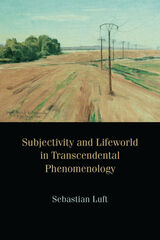 Subjectivity and Lifeworld in Transcendental Phenomenology
Sebastian Luft
Northwestern University Press, 2011 Subjectivity and Lifeworld in Transcendental Phenomenology contributes to discussions about Edmund Husserl’s phenomenology in light of the ongoing publication of his manuscripts. It accounts for the historical origins and influence of the phenomenological project by articulating Husserl's relationship to authors who came before and after him. Finally, it argues for the viability of the phenomenological project as conceived by Husserl in his later years, showing that Husserlian phenomenology is not exhausted in its early, Cartesian perspective, which is indeed its weakest and most vulnerable perspective. Rather, Sebastian Luft convincingly argues, Husserlian phenomenology is a robust and philosophically necessary approach when considered from its late, hermeneutic perspective.
The key point Luft brings into focus is that Husserl's hermeneutic phenomenology is distinct from other hermeneutic philosophers', namely Ernst Cassirer, Martin Heidegger, and Hans-Georg Gadamer. Unlike them, Husserl's focus centers on the work subjects must do in order to uncover the prejudices that guide their unreflective relationship to the world. Luft also demonstrates that there is a deep consistency within Husserl's own writings—from early to late—around the guiding themes of the natural attitude, the need and function of the epoché, and the split between egos, where the transcendental self (distinct from the natural self) is seen as the fundamental ability we all have to inquire into the genesis of our tradition-laden attitudes toward the world.
Subjectivity and Selfhood in Chinese Philosophy: Phenomenological, Comparative and Historical Perspectives
Kai Marchal
Amsterdam University Press, 2025 Human beings have always been concerned with fundamental questions about their selves, including the deeply personal nature of human experience, the persistence of the self over time, the relation between mind and body, and the interdependence between self and community. The goal of this volume is to rethink these questions against the backdrop of the Chinese philosophical traditions, covering the ideas of major thinkers from Classical to late imperial China, with a particular focus on the fact that human experience is necessarily characterized by the first-person perspective. The contributors to this volume employ different methods (historical, comparative, phenomenological), but they all aim at bringing the rich resources of Chinese philosophy to life in our global present.
Subjectivity: Filmic Representation and the Spectator's Experience
Dominique Chateau
Amsterdam University Press, 2011 Subjectivity is a central concept in film theory, philosophy and cultural studies. It was also a key term in the reception of the Nouvelle Vague film movement in France and Italy from the start of 1945. This timely volume explores the ways in which the concept of subjectivity has made its way into film theory, history, practice and criticism, as well as the confrontations of the subject with this rapidly changing medium.
Contributors to this timely study include Francesco Casetti, Gregory Currie, Marina Grzinic, Maria Klonaris and Katerina Thomadaki, Jacinto Lageira, José Moure, Pere Salabert, Céline Scemama, Karl Sierek, Vivian Sobchack, and Pierre Taminiaux. Their illuminating essays are a testimony to their profound involvement in the subjectivity debate, enriching our perception of film history and our understanding of the medium.
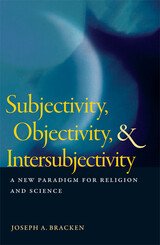 Subjectivity, Objectivity, and Intersubjectivity: A New Paradigm for Religion and Science
Joseph A. Bracken
Templeton Press, 2009 During the Middle Ages, philosophers and theologians argued over the extramental reality of universal forms or essences. In the early modern period, the relation between subjectivity and objectivity, the individual self and knowledge of the outside world, was a rich subject of debate. Today, there is considerable argument about the relation between spontaneity and determinism within the evolutionary process, whether a principle of spontaneous self-organization as well as natural selection is at work in the aggregation of molecules into cells and the development of primitive forms of life into complex organisms. In Subjectivity, Objectivity and Intersubjectivity, Joseph A. Bracken proposes that what is ultimately at stake here is the age-old problem of the relationship between the One and the Many, universality and particularity on different levels of existence and activity within nature. Bracken rejects traditional models of this relationship, wherein either the One or the Many is presupposed to have priority over the other. He instead suggests that a new social ontology—one that is grounded in a theory of universal intersubjectivity—protects both the concrete particularity of individual entities in their specific relations to one another and their enduring corporate reality as a stable community or environment within Nature.
What emerges is a bold reimagining of the sometimes strained relationship between religion and science. Bracken's clear writing, sophisticated philosophical analysis, and exemplary scholarship will lend this new work an enthusiastic appreciation by readers with deep interests in philosophy and philosophical theology.
Subject/Object and Beyond: Women in Early Modern France
Edited by Nancy M. Frelick and Edith Benkov
Iter Press, 2023 A collection of essays on early modern women from a collection of leading figures in the field.
Subject/Object and Beyond brings together essays by established and emerging scholars to honor the exceptionally rich contributions and career of scholar Colette H. Winn. It also celebrates fifty years of sustained scholarship on early modern women, along with the foundation of Women’s Studies as a recognized academic discipline in North America. The collection comprises seventeen articles that explore multiple perspectives on early modern women, including their writings, translations, reception, and contributions to various fields, including literature, music, politics, religion, and science.
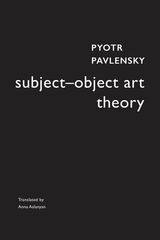 Subject–Object Art Theory
Pyotr Pavlensky
Seagull Books, 2025 Pyotr Pavlensky turns state violence into his medium—now, in his own words, he reveals the theory behind the fire.
Pyotr Pavlensky’s Subject–Object Art Theory is both a manifesto and a method—an incendiary redefinition of what art can and should be in an era of increasing repression. Known for his radical public performances, such as setting fire to government buildings, stitching his lips shut, or nailing his own body to the ground, Pavlensky has been called a provocateur. In this book, he offers his own framework: subject–object art, a practice that weaponizes state mechanisms against themselves, forcing institutions to react and, thus, become part of the work.
Venturing past the confines of political art, he examines the historical intersections of art and power, situating his work within a lineage of radical avant-garde movements. Whether seen as a guide or an act of defiance in itself, Subject–Object Art Theory urges the reader to rethink artistic freedom; not as an abstract ideal, but as a confrontation with authority.
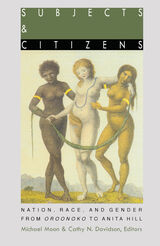 Subjects and Citizens: Nation, Race, and Gender from Oroonoko to Anita Hill
Michael Moon and Cathy N. Davidson, eds.
Duke University Press, 1995 Focusing on intersecting issues of nation, race, and gender, this volume inaugurates new models for American literary and cultural history. Subjects and Citizens reveals the many ways in which a wide range of canonical and non-canonical writing contends with the most crucial social, political, and literary issues of our past and present. Defining the landscape of the New American literary history, these essays are united by three interrelated concerns: ideas of origin (where does "American literature" begin?), ideas of nation (what does "American literature" mean?), and ideas of race and gender (what does "American literature" include and exclude and how?). Work by writers as diverse as Aphra Behn, James Fenimore Cooper, Edgar Allan Poe, Frances Harper, Harriet Beecher Stowe, Herman Melville, William Faulkner, Harriet Jacobs, Frederick Douglass, Abraham Lincoln, Bharati Mukherjee, Booker T. Washington, Mark Twain, Kate Chopin, Américo Paredes, and Toni Morrison are discussed from several theoretical perspectives, using a variety of methodologies. Issues of the "frontier" and the "border" as well as those of coloniality and postcoloniality are explored. In each case, these essays emphasize the ideological nature of national identity and, more specifically, the centrality of race and gender to our concept of nationhood. Collected from recent issues of American Literature, with three new essays added, S ubjects and Citizens charts the new directions being taken in American literary studies. Contributors. Daniel Cooper Alarcón, Lori Askeland, Stephanie Athey, Nancy Bentley, Lauren Berlant, Michele A. Birnbaum, Kristin Carter-Sanborn, Russ Castronovo, Joan Dayan, Julie Ellison, Sander L. Gilman, Karla F. C. Holloway, Annette Kolodny, Barbara Ladd, Lora Romero, Ramón Saldívar, Maggie Sale, Siobhan Senier, Timothy Sweet, Maurice Wallace, Elizabeth Young
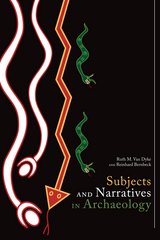 Subjects and Narratives in Archaeology
Ruth M. Van Dyke
University Press of Colorado, 2015 Seeking to move beyond the customary limits of archaeological prose and representation, Subjects and Narratives in Archaeology presents archaeology in a variety of nontraditional formats. The volume demonstrates that visual art, creative nonfiction, archaeological fiction, video, drama, and other artistic pursuits have much to offer archaeological interpretation and analysis.
Chapters in the volume are augmented by narrative, poetry, paintings, dialogues, online databases, videos, audio files, and slideshows. The work will be available in print and as an enhanced ebook that incorporates and showcases the multimedia elements in archaeological narrative. While exploring these new and not-so-new forms, the contributors discuss the boundaries and connections between empirical data and archaeological imagination.
Both a critique and an experiment, Subjects and Narratives in Archaeology addresses the goals, advantages, and difficulties of alternative forms of archaeological representation. Exploring the idea that academically sound archaeology can be fun to create and read, the book takes a step beyond the boundaries of both traditional archaeology and traditional publishing.
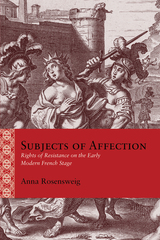 Subjects of Affection: Rights of Resistance on the Early Modern French Stage
Anna Rosensweig
Northwestern University Press, 2022 Subjects of Affection offers an alternative to the modern model of human rights in an unexpected archive: the monarchist tragedies that shaped Louis XIV’s absolutist France. Pairing political theory with performance studies, Anna Rosensweig argues that the right of resistance, largely thought to have disappeared from French political thought in the aftermath of the religious wars of the sixteenth century, actually endured throughout the seventeenth century as a conceptual framework embedded and embodied in tragic drama.
Contemporary scholars have critiqued the modern rights paradigm for its failure to acknowledge the ways in which individual rights depend upon state protection and national belonging. Through a reappraisal of early modern French tragedy, Rosensweig provides a corrective to accounts of human rights that begin with the French Revolution, exploring previously unrecognized models for collective action that had emerged during the religious wars. Subjects of Affection reveals how French tragedy sustained these models of collective action by binding together individuals and groups through affect. Rosensweig places sixteenth-century political treatises in dialogue with dramas by Robert Garnier, Jean Rotrou, Pierre Corneille, and Jean Racine that were performed and published between 1550 and 1700. In so doing, she demonstrates how these tragedies, through their poetics and performance potential, stage a subject of rights whose collective constitution differs from the individualism of our modern rights framework. Through fresh insights and incisive readings, Subjects of Affection explores a form of political subjectivity that locates political power in connection to others—from staged characters and choruses to unseen collectives.
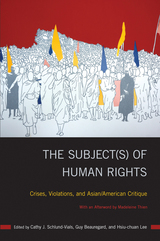 The Subject(s) of Human Rights: Crises, Violations, and Asian/American Critique
Cathy J. Schlund-Vials
Temple University Press, 2020 Human rights violations have always been part of Asian American studies. From Chinese immigration restrictions, the incarceration of Japanese Americans, yellow peril characterizations, and recent acts of deportation and Islamophobia, Asian Americans have consistently functioned as subordinated “subjects” of human rights violations. The Subject(s) of Human Rights brings together scholars from North America and Asia to recalibrate these human rights concerns from both sides of the Pacific. The essays in this collection provide a sharper understanding of how Asian/Americans have been subjected to human rights violations, how they act as subjects of history and agents of change, and how they produce knowledge around such subjects. The editors of and contributors to The Subject(s) of Human Rights examine refugee narratives, human trafficking, and citizenship issues in twentieth- and twenty-first century literature. These themes further refract issues of American war-making, settler colonialism, military occupation, collateral damage, and displacement that relocate the imagined geographies of Asian America from the periphery to the center of human rights critique.
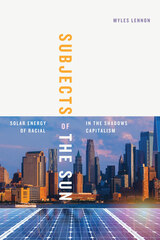 Subjects of the Sun: Solar Energy in the Shadows of Racial Capitalism
Myles Lennon
Duke University Press, 2025 In the face of accelerating climate change, anticapitalist environmental justice activists and elite tech corporations increasingly see eye to eye. Both envision solar-powered futures where renewable energy redresses gentrification, systemic racism, and underemployment. However, as Myles Lennon argues in Subjects of the Sun, solar power is no less likely to exploit marginalized communities than dirtier forms of energy. Drawing from ethnographic research on clean energy corporations and community solar campaigns in New York City, Lennon argues that both groups overlook solar’s extractive underside because they primarily experience energy from the sun in the virtual world of the cloud. He shows how the material properties of solar technology—its shiny surfaces, decentralized spatiality, and modularity—work closely with images, digital platforms, and quantitative graphics to shape utopic visions in which renewable energy can eradicate the constitutive tensions of racial capitalism. As a corrective to this virtual world, Lennon calls for an equitable energy transition that centers the senses and sensibilities neglected by screenwork: one’s haptic care for their local environment; the full-bodied feel of infrastructural labor; and the sublime affect of the sun.
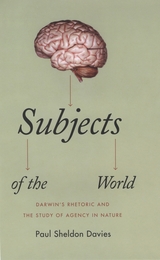 Subjects of the World: Darwin's Rhetoric and the Study of Agency in Nature
Paul Sheldon Davies
University of Chicago Press, 2009 Being human while trying to scientifically study human nature confronts us with our most vexing problem. Efforts to explicate the human mind are thwarted by our cultural biases and entrenched infirmities; our first-person experiences as practical agents convince us that we have capacities beyond the reach of scientific explanation. What we need to move forward in our understanding of human agency, Paul Sheldon Davies argues, is a reform in the way we study ourselves and a long overdue break with traditional humanist thinking. Davies locates a model for change in the rhetorical strategies employed by Charles Darwin in On the Origin of Species. Darwin worked hard to anticipate and diminish the anxieties and biases that his radically historical view of life was bound to provoke. Likewise, Davies draws from the history of science and contemporary psychology and neuroscience to build a framework for the study of human agency that identifies and diminishes outdated and limiting biases. The result is a heady, philosophically wide-ranging argument in favor of recognizing that humans are, like everything else, subjects of the natural world—an acknowledgement that may free us to see the world the way it actually is.
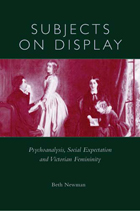 Subjects on Display: Psychoanalysis, Social Expectation, and Victorian Femininity
Beth Newman
Ohio University Press, 2004 Subjects on Display explores a recurrent figure at the heart of many nineteenth-century English novels: the retiring, self-effacing woman who is conspicuous for her inconspicuousness. Beth Newman draws upon both psychoanalytic theory and recent work in social history as she argues that this paradoxical figure, who often triumphs over more dazzling, eye-catching rivals, is a response to the forces that made personal display a vexed issue for Victorian women. Chief among these is the changing socioeconomic landscape that made the ideal of the modest woman outlive its usefulness as a class signifier even as it continued to exert moral authority. This problem cannot be grasped in its full complexity, Newman shows, without considering how the unstable social meanings of display interacted with psychical forces-specifically, the desire to be seen by others that is central to both masculine and feminine subjectivity. This desire raises an issue that feminist theorists have been reluctant to address: the importance of pleasure in being the object of the look. Their reluctance is characteristic of cultural theory, which has tended to equate subjectivity with the position of the observer rather than the observed. Through a consideration of fiction by Charlotte Brontë, Charles Dickens, George Eliot, and Henry James, Newman shifts the inquiry toward the observed in the experience of being seen. In the process she reopens the question of the gaze and its relation to subjectivity. Subjects on Display will appeal to scholars and students in several disciplines as it returns psychoanalysis to a central position within literary and cultural studies.
 Subjects without Selves: Transitional Texts in Modern Fiction
Gabriele Schwab
Harvard University Press, 1994 How do aesthetic forms contribute to different kinds of cultural knowledge? Gabriele Schwab responds to this question with an analysis of the nature of subjectivity in modernist fiction. Drawing on French and Anglo-American psychoanalysis as well as reader response theory, she explores the relationship between language and subjectivity and in so doing illuminates the cultural politics and psychological functions implicit in the aesthetic practices and literary forms of modernism and postmodernism. The result of this exploration is a new understanding of the function of literature as a form of cultural knowledge.
Schwab demonstrates how literature creates a transitional space where boundaries of language and subjectivity are continually aped and reshaped on both an individual and a cultural eve. Modern and postmodern experimental texts, in particular, fulfill this function through the multifarious exploration of the boundaries of poetic language and their opening to the unconscious. Undertaking what she terms a literary ethnography of the decentered subject, Schwab examines five novels: Herman Melville's Moby-Dick, Virginia Woolfs The Waves, James Joyce's Finnegans Wake, Samuel Beckett's The Unnamable, and Thomas Pynchon's Gravity's Rainbow. Schwab demonstrates how the aesthetic figurations of unconscious experience in these texts generate new forms of literary language and an aesthetic reception that is directly relevant to an increasingly global and hybridized culture.
In her concluding chapter, which introduces the notion of “textual ecologies,” Schwab analyzes the literary subjectivity of “transitional texts” in light of such contemporary theories as systems theory, cybernetics, and the new physics. From this perspective, such texts not only reflect cultural practices but take part in shaping their change and innovation.
 Subjunctive Aesthetics: Mexican Cultural Production in the Era of Climate Change
Carolyn Fornoff
Vanderbilt University Press, 2024 Premio al Mejor Libro en Humanidades, Latin American Studies Association–Mexico Section, 2025
Honorable Mention, LASA Environment Best Book Prize, Latin American Studies Association–Environment Section, 2025
During the twenty-first century, Mexico has escalated extractive concessions at the same time that it has positioned itself as an international leader in the fight against climate change. Cultural production emergent from this contradiction frames this impasse as a crisis of imagination. Subjunctive Aesthetics studies how contemporary writers, filmmakers, and visual artists grapple with the threat that climate change and extractivist policies pose to Mexico's present and future. It explores how artists rise to the challenge of envisioning alternative forms of territoriality (ways of being in relation to the environment) through strategies ranging from rewriting to counterfactual speculation.
Whereas ecocritical studies have often focused on art's evidentiary role—its ability to visualize and prove the urgency of environmental damage—author Carolyn Fornoff argues that what unites the artists under consideration is their use of more hypothetical, uncertain representational modes, or "subjunctive aesthetics." In English, the subjunctive is a grammatical mode that articulates the imagined, desired, and possible. In the Spanish language, it is even more widely used to express doubts, denials, value judgments, and emotions. Each chapter of Subjunctive Aesthetics takes up one of these modalities to examine how Mexican artists, writers, and filmmakers activate approaches to the planet not just as it is, but as it could be or should be.
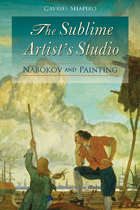 The Sublime Artist's Studio: Nabokov and Painting
Gavriel Shapiro
Northwestern University Press, 2009 In his youth, Vladimir Nabokov aspired to become a landscape artist. Even though he eventually realized that his true vocation was literature, his keen sense of visual detail, nuanced perception of color, and vast knowledge of the fine arts are all manifest in his literary works, which abound with painters and paintings, real and imaginary, as well as with magnificent pictorial imagery rendered in a verbal medium. The relation of the visual arts to Nabokov’s work is the subject of The Sublime Artist’s Studio, an in-depth and detailed study of one of the most significant facets of this modern master’s oeuvre. Gavriel Shapiro pursues his inquiry throughout Nabokov’s literary legacy—poetry, short prose, novels, plays, memoirs, lectures, essays, interviews, and letters. What is the import of Nabokov’s lifelong fascination with the Old Masters? How does landscape function in Nabokov’s writings? What was the author’s relationship to contemporary artists? By addressing these and other questions, while examining Nabokov’s references and allusions to the visual arts and to particular works and artists, Shapiro is able to reveal the centrality of painting to Nabokov’s belles lettres. His book offers a new and promising approach to one of the twentieth century’s most celebrated writers.
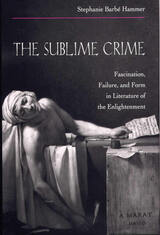 The Sublime Crime: Fascination, Failure, and Form in Literature of the Enlightenment
Stephanie Barbe Hammer
Southern Illinois University Press, 1993
In this hermeneutic analysis of seven literary texts, Stephanie Barbé Hammer studies the roles of criminal protagonists in the dramas of George Lillo (The London Merchant) and Friedrich Schiller (The Robbers) and in the narratives of Abbé de Prévost (Manon Lescaut), Henry Fielding (Jonathan Wild), Marquis de Sade (Justine), William Godwin (Caleb Williams), and Heinrich von Kleist (Michael Kohlhaas).
Hammer reflects the current interest in cultural critique by utilizing the social theories of Michel Foucault and the feminist approaches of Hélène Cixous and Eve Sedgwick to redefine the Enlightenment as a movement of thought rather than as a strictly defined period synonymous with the eighteenth century. In addition, through the examination of the works of three post–World War II authors (Jean Genet, Anthony Burgess, and Peter Handke), Hammer suggests that the Enlightenment’s artistic representations of criminality are unparalleled by subsequent modern literature.
Hammer explains that the seven works she focuses on have been dismissed as failures by readers who have misunderstood the texts’ aesthetic elements. While claiming that the form of these works breaks down under the pressure of their criminal protagonists, she asserts that this formal failure actually contributes to the success of the works as art. The works "fail" because, like the criminal characters themselves, they break laws. The criminal protagonist effectively sabotages the official story that the text seeks to tell by deflecting the plot, style, and formal requirements in question, subverting its message—be it moral, sentimental, or libertine— through a kind of structural undermining, forcing the text beyond its own formal boundaries. For example, Hammer maintains that the presence of the criminal figure, Millwood, in Lillo’s bourgeois tragedy actually makes the play covertly antibourgeois.
Hammer insists that the criminal’s subversive presence in these seven works inaugurates new insight, and her analysis thereby challenges late twentieth-century readers to continue the investigation that the works themselves have begun.
This book will prove indispensable to scholars of comparative literature, especially eighteenth-century specialists, as well as to all individuals interested in cultural critique.
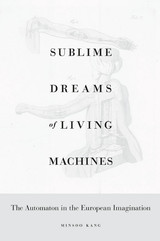 Sublime Dreams of Living Machines: The Automaton in the European Imagination
Minsoo Kang
Harvard University Press, 2011 From the dawn of European civilization to the twentieth century, the automaton—better known today as the robot—has captured the Western imagination and provided a vital lens into the nature of humanity.
Historian Minsoo Kang argues that to properly understand the human-as-machine and the human-as-fundamentally-different-from-machine, we must trace the origins of these ideas and examine how they were transformed by intellectual, cultural, and artistic appearances of the automaton throughout the history of the West. Kang tracks the first appearance of the automaton in ancient myths through the medieval and Renaissance periods, marks the proliferation of the automaton as a central intellectual concept in the Scientific Revolution and the subsequent backlash during the Enlightenment, and details appearances in Romantic literature and the introduction of the living machine in the Industrial Age. He concludes with a reflection on the destructive confrontation between humanity and machinery in the modern era and the reverberations of the humanity-machinery theme today.
Sublime Dreams of Living Machines is an ambitious historical exploration and, at heart, an attempt to fully elucidate the rich and varied ways we have utilized our most uncanny creations to explore essential questions about ourselves.
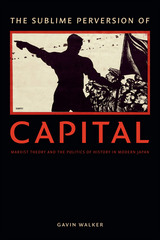 The Sublime Perversion of Capital: Marxist Theory and the Politics of History in Modern Japan
Gavin Walker
Duke University Press, 2016 In The Sublime Perversion of Capital Gavin Walker examines the Japanese debate about capitalism between the 1920s and 1950s, using it as a "prehistory" to consider current discussions of uneven development and contemporary topics in Marxist theory and historiography. Walker locates the debate's culmination in the work of Uno Kōzō, whose investigations into the development of capitalism and the commodification of labor power are essential for rethinking the national question in Marxist theory. Walker's analysis of Uno and the Japanese debate strips Marxist historiography of its Eurocentric focus, showing how Marxist thought was globalized from the start. In analyzing the little-heralded tradition of Japanese Marxist theory alongside Marx himself, Walker not only offers new insights into the transition to capitalism, the rise of globalization, and the relation between capital and the formation of the nation-state; he provides new ways to break Marxist theory's impasse with postcolonial studies and critical theory.
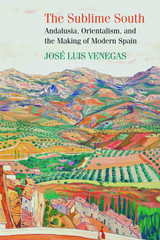 The Sublime South: Andalusia, Orientalism, and the Making of Modern Spain
Jose Luis Venegas
Northwestern University Press, 2018 The Sublime South: Andalusia, Orientalism, and the Making of Modern Spain is the first systematic study on cultural images of Andalusia as Spain’s “Orient” and the impact they have had on nation-building and modernization since the late nineteenth century. While a wealth of studies have examined how northern Europeans from the Romantic period viewed Spain and Andalusia as Europe’s Orient, little attention has been paid to how contemporary Spanish artists and intellectuals assimilated Romantic legacies to engage in an internal form of orientalism.
José Luis Venegas deftly explores Spain’s shifting engagements with oriental identity and otherness by looking, not just beyond national, ethnic, and racial borders, but at a territory that is institutionally embedded in the nation-state while symbolically placed between inclusion and abjection. The Sublime South shifts the focus and scale of Edward Said’s notion of orientalism by examining how it evolves and manifests transnationally, as the result of European colonialism in Africa and Asia, and intra-nationally, in a European yet orientalized country. Finally, Venegas challenges ethnocentric notions of Iberian cultures and fosters an understanding of the encounters between Western and Muslim cultures beyond opposing, and often mutually negating, essentialisms.
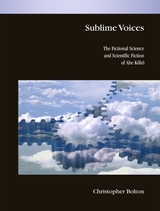 Sublime Voices: The Fictional Science and Scientific Fiction of Abe Kōbō
Christopher Bolton
Harvard University Press, 2009 Since the 1950s, Abe Kōbō (1924–1993) has achieved an international reputation for his surreal or grotesque brand of avant-garde literature. From his early forays into science fiction to his more mature psychological novels and films, and finally the complicated experimental works produced near the end of his career, Abe weaves together a range of “voices”: the styles of science and the language of literary forms.
In Abe’s oeuvre, this stylistic interplay links questions of language and subjectivity with issues of national identity and technological development in a way that ultimately aspires to become the catalyst for an artistic revolution. While recognizing the disruptions such a revolution might entail, Abe’s texts embrace these disjunctions as a way of realizing radical new possibilities beyond everyday experience and everyday values.
By arguing that the crisis of identity and postwar anomie in Abe’s works is inseparable from the need to marshal these different scientific and literary voices, Christopher Bolton explores how this reconciliation of ideas and dialects is for Abe part of the process whereby texts and individuals form themselves—a search for identity that must take place at the level of the self and society at large.
 Sublimity and Skepticism in Montaigne and Milton
David L. Sedley
University of Michigan Press, 2005 Traditional approaches to understanding sublimity and skepticism have often asserted the primacy and importance of one concept over the other. However, in Sublimity and Skepticism in Montaigne and Milton, David L. Sedley argues that literary and philosophical notions of skepticism and sublimity simultaneously developed and influenced one another. By exposing the twin origins of skepticism and sublimity, Sedley contributes to ongoing discussions of the origins of modernity and genealogies of modern habits of criticism.
Sedley uses the juxtaposition of Montaigne and Milton to argue that two seminal early modern phenomena, the rise of the sublime as an aesthetic category and the emergence of skepticism as a philosophical problem, are interrelated. The comparison of these two Renaissance writers highlights the traditions that have canonized them and also complicates the canonical views: Sedley's perspective reveals how Montaigne cultivated his famous skepticism in order to produce sublimity, while Milton forged his renowned sublimity through his encounter with skepticism. Sedley's first argument is that sublimity motivated skepticism: the sense that a force existed outside the aesthetic categories conventional in the Renaissance drove authors into a skeptical frame of mind. His second argument is that skepticism created sublimity: the skeptical mind-set offered alternative resources of aesthetic power and enabled authors to fashion a sublime style. These claims revise standard views of skepticism and sublimity, suggesting a mandate for an enriched aesthetics behind late-Renaissance loss of belief and exposing the Renaissance impulse behind modern notions of sublimity.
"Sedley's work takes seriously our ongoing engagement with doubt. It is a brisk and brilliant guide to the disparate pathways through which early modern skepticism made its way to the sublime."
-Eileen Reeves, Associate Professor of Comparative Literature, Princeton University
"Sublimity and Skepticism in Montaigne and Milton is a powerful piece of revisionist intellectual history. By demonstrating the close links between the rise of skepticism and the power of the sublime, Sedley offers a welcome antidote to the heavily ideological tenor of much recent cultural studies. With clarity and elegance Sedley shows that two of the greatest writers of the late Renaissance, Montaigne and Milton, are haunted by a crisis of authority, which is accompanied by the irruption of the sublime, by an inchoate sense of being overwhelmed by the phenomenal world. Through deft and intelligent readings Sedley shows how key moments in the works of these two great authors are structured by the intersection of the sublime and the skeptical. This book should be of great interest to literary scholars, aestheticians, and intellectual historians working in several languages. It is a very fine piece of work."
-Tim Hampton, Professor of French, UC Berkeley
"A refreshingly modern and elegant understanding of Montaigne and Milton as inaugurating the sublime possibilities of the fragmentary and incomprehensible. Sedley reinserts these writers into a history of the transformation of admiration into awe, and makes us revisit the beginnings and the justifications of our own esthetics of the sublime."
-Ullrich Langer, Professor of French and Italian, University of Wisconsin
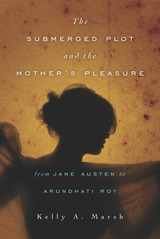 The Submerged Plot and the Mother's Pleasure from Jane Austen to Arundhati Roy
Kelly A. Marsh
Ohio State University Press, 2016 In The Submerged Plot and the Mother’s Pleasure from Jane Austen to Arundhati Roy, Kelly A. Marsh examines the familiar, overt plot of the motherless daughter growing into maturity and argues that it is accompanied by a covert plot. Marsh’s insightful analyses of nineteenth- and twentieth-century Anglophone novels reveal that these novels are far richer and more complexly layered than the overt plot alone suggests. According to Marsh, as the daughter approaches adulthood and marriage, she seeks validation for her pleasure in her mother’s story. However, because the mother’s pleasure is taboo under patriarchy and is therefore unnarratable, the daughter must seek her mother’s story by repeating it. These repetitions alert us to the ways the two plots are intertwined and alter our perception of the narrative progression.
Combining feminist and rhetorical narratological approaches, Marsh’s study offers fresh readings of Persuasion, Jane Eyre, Bleak House, The Woman in White, The House of Mirth, The Last September, The Color Purple, A Thousand Acres, Bastard Out of Carolina, Talking to the Dead, and The God of Small Things. Through these readings, The Submerged Plot and the Mother’s Pleasure explores how the unnarratable can be communicated in fiction and offers a significant contribution to our understanding of narrative progression.
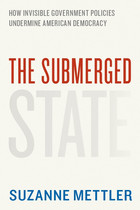 The Submerged State: How Invisible Government Policies Undermine American Democracy
Suzanne Mettler
University of Chicago Press, 2011 “Keep your government hands off my Medicare!” Such comments spotlight a central question animating Suzanne Mettler’s provocative and timely book: why are many Americans unaware of government social benefits and so hostile to them in principle, even though they receive them? The Obama administration has been roundly criticized for its inability to convey how much it has accomplished for ordinary citizens. Mettler argues that this difficulty is not merely a failure of communication; rather it is endemic to the formidable presence of the “submerged state.”
In recent decades, federal policymakers have increasingly shunned the outright disbursing of benefits to individuals and families and favored instead less visible and more indirect incentives and subsidies, from tax breaks to payments for services to private companies. These submerged policies, Mettler shows, obscure the role of government and exaggerate that of the market. As a result, citizens are unaware not only of the benefits they receive, but of the massive advantages given to powerful interests, such as insurance companies and the financial industry. Neither do they realize that the policies of the submerged state shower their largest benefits on the most affluent Americans, exacerbating inequality. Mettler analyzes three Obama reforms—student aid, tax relief, and health care—to reveal the submerged state and its consequences, demonstrating how structurally difficult it is to enact policy reforms and even to obtain public recognition for achieving them. She concludes with recommendations for reform to help make hidden policies more visible and governance more comprehensible to all Americans.
The sad truth is that many American citizens do not know how major social programs work—or even whether they benefit from them. Suzanne Mettler’s important new book will bring government policies back to the surface and encourage citizens to reclaim their voice in the political process.
 Subprime Health: Debt and Race in U.S. Medicine
Nadine Ehlers
University of Minnesota Press, 2017 From race-based pharmaceutical prescriptions and marketing, to race-targeted medical “hot spotting” and the Affordable Care Act, to stem-cell trial recruitment discourse, Subprime Health is a timely examination of race-based medicine as it intersects with the concept of debt. The contributors to this volume propose that race-based medicine is inextricable from debt in two key senses. They first demonstrate how the financial costs related to race-based medicine disproportionately burden minorities, as well as how monetary debt and race are conditioned by broader relations of power. Second, the contributors investigate how race-based medicine is related to the concept of indebtedness and is often positioned as a way to pay back the debt that the medical establishment—and society at large—owes for the past and present neglect and abuses of many communities of color. By approaching the subject of race-based medicine from an interdisciplinary perspective—critical race studies, science and technology studies, public health, sociology, geography, and law—this volume moves the discussion beyond narrow and familiar debates over racial genomics and suggests fruitful new directions for future research. Contributors: Ruha Benjamin, Princeton U; Catherine Bliss, U of California, San Francisco; Khiara M. Bridges, Boston U; Shiloh Krupar, Georgetown U; Jenna M. Loyd, U of Wisconsin–Milwaukee; Anne Pollock, Georgia Tech.
The Subsequent Blues
Gary Copeland Lilley
Four Way Books, 2004 Gary Copeland Lilley writes sonnets and he writes scat, applying traditional forms to untraditional subjects, achieving great grace and insight via ‘high’ and ‘low’ cultural fusions. He examines the DC ghetto and an assortment of its players (voodoo priests, junkies, soldiers, mothers…) through the lenses of both a sonnet’s crucial turn and the jazz riff’s apparent, adamant stream-of-consciousness. E. Ethelbert Miller writes of The Subsequent Blues, “Gary Copeland Lilley writes like a man who owns a Stetson hat. Is he Stagolee? The Subsequent Blues is a book filled with a sinner’s honesty. Lilley captures life with all its blue tones and shades. From cigarette smoke, to drinks and drugs, a few of the poems are as seductive as a woman’s thighs. Lilley has seen enough bad times and death that each poem he writes has that flicker of light we once called soul. Put this book in your mojo bag.”
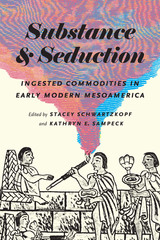 Substance and Seduction: Ingested Commodities in Early Modern Mesoamerica
Edited by Stacey Schwartzkopf and Kathryn E. Sampeck
University of Texas Press, 2017 Chocolate and sugar, alcohol and tobacco, peyote and hallucinogenic mushrooms—these seductive substances have been a nexus of desire for both pleasure and profit in Mesoamerica since colonial times. But how did these substances seduce? And when and how did they come to be desired and then demanded, even by those who had never encountered them before? The contributors to this volume explore these questions across a range of times, places, and peoples to discover how the individual pleasures of consumption were shaped by social, cultural, economic, and political forces. Focusing on ingestible substances as a group, which has not been done before in the scholarly literature, the chapters in Substance and Seduction trace three key links between colonization and commodification. First, as substances that were taken into the bodies of both colonizers and colonized, these foods and drugs participated in unexpected connections among sites of production and consumption; racial and ethnic categories; and free, forced, and enslaved labor regimes. Second, as commodities developed in the long transition from mercantile to modern capitalism, each substance in some way drew its enduring power from its ability to seduce: to stimulate bodies; to alter minds; to mark class, social, and ethnic boundaries; and to generate wealth. Finally, as objects of scholarly inquiry, each substance rewards interdisciplinary approaches that balance the considerations of pleasure and profit, materiality and morality, and culture and political economy.
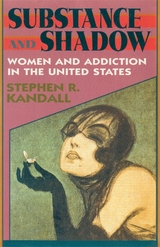 Substance and Shadow: Women and Addiction in the United States
Stephen Kandall
Harvard University Press, 1996 In 1989 Jennifer Johnson was convicted of delivering a controlled substance to a minor. That the minor happened to be Johnson's unborn child made her case all the more complex, controversial, and ultimately, historical. Stephen R. Kandall, a neonatologist and pediatrician, testified as an expert witness on Johnson's behalf. The experience caused him to wonder how one disadvantaged black woman's case became a prosecutorial battlefield in the war on drugs. This book is the product of Kandall's search through the annals of medicine and history to learn how women have fared in this conflict and how drug-dependent women have been treated for the past century and a half.
Kandall's sleuthing uncovers an intriguing and troubling story. Opium, laudanum, and morphine were primary ingredients in the curative "powders" and strengthening "tonics" that physicians freely prescribed and pharmacists dispensed to women a hundred and fifty years ago. Or a woman could easily dose herself with narcotics and alcohol in the readily available form of "patent" medicines sold in every town and touted in popular magazines ("Over a million bottles sold and in every one a cure!"). For the most part unaware of their dangers, women turned to these remedies for "female complaints," such as "womb disease" and "congestion of the ovaries," as well as for "neurasthenia," a widespread but vague nervous malady attributed to women's weaker, more sensitive natures. Not surprisingly, by the latter half of the nineteenth century the majority of America's opiate addicts were women.
The more things change, the more they remain the same: Substance and Shadow shows how, though attitudes and drugs may vary over time--from the laudanum of yesteryear to the heroin of the thirties and forties, the tranquilizers of the fifties, the consciousness-raising or prescription drugs of the sixties, and the ascendance of crack use in the eighties--dependency remains an issue for women. Kandall traces the history of questionable treatment that has followed this trend. From the maintenance clinics of the early twenties to the "federal farms" of mid-century to the detoxification efforts and methadone maintenance that flourished in the wake of the Women's Movement, attempts to treat drug-dependent women have been far from adequate. As he describes current policies that put money into drug interdiction and prisons, but offer little in the way of treatment or hope for women like Jennifer Johnson, Kandall calls our attention to the social and personal costs of demonizing and punishing women addicts rather than trying to improve their circumstances and give them genuine help.
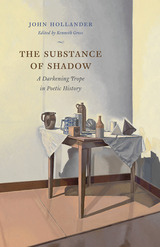 The Substance of Shadow: A Darkening Trope in Poetic History
John Hollander
University of Chicago Press, 2016 John Hollander, poet and scholar, was a master whose work joined luminous learning and imaginative risk. This book, based on the unpublished Clark Lectures Hollander delivered in 1999 at Cambridge University, witnesses his power to shift the horizons of our thinking, as he traces the history of shadow in British and American poetry from the Renaissance to the end of the twentieth century.
Shadow shows itself here in myriad literary identities, revealing its force as a way of seeing and a form of knowing, as material for fable and parable. Taking up a vast range of texts—from the Bible, Dante, Shakespeare, and Milton to Poe, Dickinson, Eliot, and Stevens—Hollander describes how metaphors of shadow influence our ideas of dreaming, desire, doubt, and death. These shadows of poetry and prose fiction point to unknown, often fearful domains of human experience, showing us concealed shapes of truth and possibility. Crucially, Hollander explores how shadows in poetic history become things with a strange substance and life of their own: they acquire the power to console, haunt, stalk, wander, threaten, command, and destroy. Shadow speaks, even sings, revealing to us the lost as much as the hidden self.
An extraordinary blend of literary analysis and speculative thought, Hollander’s account of the substance of shadow lays bare the substance of poetry itself.
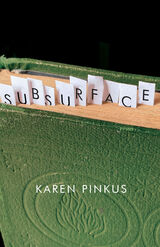 Subsurface
Karen Pinkus
University of Minnesota Press, 2023 A bold new consideration of climate change between narratives of the Earth’s layers and policy of the present
Long seen as a realm of mystery and possibility, the subsurface beneath our feet has taken on all-too-real import in the era of climate change. Can reading narratives of the past that take imaginative leaps under the surface better attune us to our present knowledge of a warming planet? In Subsurface, Karen Pinkus looks below the surface of texts by Edgar Allan Poe, Arthur Conan Doyle, George Sand, E. T. A. Hoffmann, and Jules Verne to find the buried origins of capitalist fantasies in which humans take what they want from the earth. Putting such texts into conversation with narrative theory, critical theory, geology, and climate policy, she shows that the subsurface has been, in our past, a place of myth and stories of male voyages down to gain knowledge—but it is also now the realm of fossil fuels. How do these two modes intertwine? A highly original take on evocative terms such as extraction, burial, fossils, deep time, and speculative futurity, Subsurface questions the certainty of comfortable narrative arcs. It asks us to read literature with and against the figure of the geological column, with and against fossil fuels and the emissions warming our planet. As we see our former selves move into the distance, what new modes of imagination might we summon?
The Subtenant / To Outwit God
Hanna Krall
Northwestern University Press, 1992 This volume presents two works by acclaimed Polish journalist Hanna Krall: The Subtenant, a semi-autobiographical novel, and To Outwit God, a remarkable interview with Marek Edelman, the last surviving leader of the Warsaw Ghetto uprising. The Subtenant explores the troubled and ever-shifting relationships between Poles and Jews, beginning with the author's concealment as a child during the Nazi years and ending in 1981 when martial law was declared in Poland. In To Outwit God, Edelman's words assault conventional assumptions about heroes and heroism, taking in his time not only in the Warsaw Ghetto but his careers as a physician and a Solidarity activist. Taken together, the two works form a powerful memoir of Jewish survival, a meditation on Polish-Jewish relations, and a commentary on the forces that have produced modern Polish opposition movements.
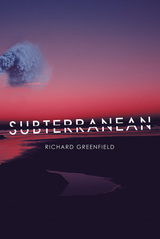 Subterranean
Richard Greenfield
Omnidawn, 2018 The elegies that comprise Richard Greenfield’s third book of poems, Subterranean, open the rhetoric of the form in new ways, creating a site of grieving that transcends a focus on the death of the father. Though lyrical, these elegies juxtapose the collapse of hyper-economies against the collapse of ecosystems, exploring the overlap, or edge effect, of liminal encounters between the living and the dead, between the city and the wilderness, between the human and the animal, and between the haves and the have nots. Greenfield creates a sequence of associative, anxious, rambling, and digressive meditations bridging these harrowing divides and exposing the loneliness of grief and empty promise of connection in the age of late capitalism. Greenfield asks, “Do you want to call someone?” The human voice, transmitted through the cell phone, becomes a spectral voice and streams “up from the basin to the peak and its antenna and striates and sieves through solid structures to arrive in the spiral of the ear of anyone.
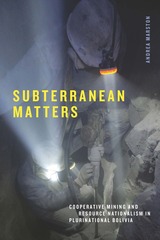 Subterranean Matters: Cooperative Mining and Resource Nationalism in Plurinational Bolivia
Andrea Marston
Duke University Press, 2024 In Subterranean Matters, Andrea Marston examines the ongoing history of Bolivian mining cooperatives, an economic formation that has been central to Bolivian politics and to the country’s economy. Marston outlines how mining cooperatives occupy a contradictory place in Bolivian politics. They were major backers of left-wing president Evo Morales in 2006 and participated significantly in the crafting of the constitution that would declare Bolivia a plurinational state. At the same time, many Bolivians regard mining cooperatives as thieves because they derive personal profits from the subterranean mineral resources that are the legal inheritance of all Bolivians. Through extensive fieldwork underground in Bolivian cooperative mines, Marston explores how these miners—and the subterranean spaces they occupy—embody the tensions at the heart of Bolivia’s plurinational project. Marston shows how persistent commitment to nation and nationalism is a shared feature of left-wing and right-wing politics in Bolivia, illustrating how bodies, identities, and resources fit into this complex political matrix.
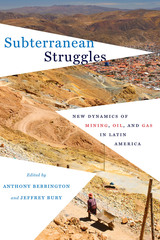 Subterranean Struggles: New Dynamics of Mining, Oil, and Gas in Latin America
Edited by Anthony Bebbington and Jeffrey Bury
University of Texas Press, 2013 Over the past two decades, the extraction of nonrenewable resources in Latin America has given rise to many forms of struggle, particularly among disadvantaged populations. The first analytical collection to combine geographical and political ecological approaches to the post-1990s changes in Latin America’s extractive economy, Subterranean Struggles closely examines the factors driving this expansion and the sociopolitical, environmental, and political economic consequences it has wrought. In this analysis, more than a dozen experts explore the many facets of struggles surrounding extraction, from protests in the vicinity of extractive operations to the everyday efforts of excluded residents who try to adapt their livelihoods while industries profoundly impact their lived spaces. The book explores the implications of extractive industry for ideas of nature, region, and nation; “resource nationalism” and environmental governance; conservation, territory, and indigenous livelihoods in the Amazon and Andes; everyday life and livelihood in areas affected by small- and large-scale mining alike; and overall patterns of social mobilization across the region. Arguing that such struggles are an integral part of the new extractive economy in Latin America, the authors document the increasingly conflictive character of these interactions, raising important challenges for theory, for policy, and for social research methodologies. Featuring works by social and natural science authors, this collection offers a broad synthesis of the dynamics of extractive industry whose relevance stretches to regions beyond Latin America.
Subtle Subversions: Reading Golden Age Sonnets by Iberian Women
Gwyn Fox
Catholic University of America Press, 2008 Subtle Subversions is the first full-length, contextual, and analytical study of the sonnets of five seventeenth-century women in Spain and Portugal: Luisa de Carvajal y Mendoza, Catalina Clara Ramírez de Guzmán, Sor María de Santa Isabel, Leonor de la Cueva y Silva, and Sor Violante del Cielo
 The Subtlety of the Street: The Discourse of Responsibility
M Peregrine Balmat (neé Maureen T. Matarese)
University of Michigan Press, 2026 The Subtlety of the Street examines the effects of small, seemingly mundane words that occur in conversations between street-level workers and those they serve. Combining discourse analysis, public policy studies, and higher education and social work research, M Peregrine Balmat examines data from two distinct ethnographies that comprise over 1100 pages of transcribed social interaction and 24 months of participant observation fieldwork. Balmat uses Interactional Linguistics to examine how responsibility is constructed over time in social work (homeless shelter) and higher education (community college) contexts, bringing to light systemic issues that face street-level disciplines. Analyzing constellations of words—personal pronouns, terms referring to performance benchmarks and assessments, and cultural mythologies—the author shows that clusters of seemingly generic phrases street-level workers use to communicate responsibility can function, in concert, as racialized microaggressions —termed the Gestalt of Responsibility.
These problematic linguistic choices can accumulate over a student’s time in the classroom or over a person’s time in shelter. They shift in response to performance assessments and measurements, increasing in unfriendly, morally-loaded constructions of responsibility as testing days and shelter restrictions approach. While street-level research suggests that strategies like these are utilized because workers believe those discourse practices work, the phrases reflect historical English poor laws and racialized ideologies leveled against enslaved Black people as well as more modern neoliberal welfare state and education politics where such ideologies persist. The Subtlety of the Street offers recommendations for street-level workers’ collaborative professional development and implications for street-level approaches to pedagogy and practice.
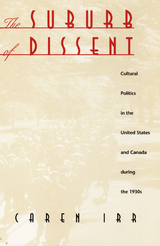 The Suburb of Dissent: Cultural Politics in the United States and Canada during the 1930s
Caren Irr
Duke University Press, 1998 In The Suburb of Dissent Caren Irr explores the leftist literary subculture of the United States and Canada during the 1930s to reconstruct the ideas of mass culture, class, and nationality that emerged as a result of the Great Depression. Unearthing plots and characters that still surface in contemporary narratives, Irr juxtaposes classic and neglected works of criticism, fiction, poetry, and journalism and demonstrates how leftist writers resisted totalitarianism much more thoroughly than Cold War accounts would suggest.
Irr highlights works by Richard Wright, John Dos Passos, Nathanael West, and others to uncover the complex relationship between American anti-communism and communist anti-Americanism. In an unprecedented move, she extends her inquiry to the work of Canadian intellectuals such as Dorothy Livesay and Hugh MacLennan to reveal the important yet overlooked fact that the territory at the border of the United States and Canada provided a vital contact zone and transnational “home” for leftist thinkers. Attending to intersections of race, ethnicity, and gender, Irr illustrates the ways dissenting writers made culture actively respond to the political crises of the Great Depression and questioned the nature of what it means to be “American.”
Drawing on insights from postcolonial and American studies and taking into account the intellectual and cultural dimensions of leftist politics, The Suburb of Dissent is the first study of the 1930s to bring together U.S. and Canadian writings. In doing so, it reveals how the unique culture of the left contributed to North American history at this critical juncture and beyond.
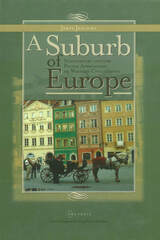 A Suburb of Europe: Nineteenth-Century Polish Approaches to Western Civilization
Jerzy Jedlicki
Central European University Press, 2000 In this lively and original book, the distinguished Polish historian Jerzy Jedlicki tells the story of a century-long Polish dispute over the merits and demerits of the Western model of liberal progress and industrial civilization. As in several countries of Europe, also in Poland, intellectuals--conservatives, liberals, and (later) socialists--quarrelled about whether such a model would suit and benefit their nation, or whether it would spell the ruin of its distinctive cultural features. This heated debate revolved around several pairs of opposing ideas: native cultures v. cosmopolitan civilization; natural v. artificial ways of economic development; Christian morals v. capitalist laissez-faire; traditional customs v. mobile society; romanticism v. scientism, and so on. It is these various aspects of the main issue which the author analyzes and links together here. He describes how difficult and painful the process of modernization was in a nation deprived of its political independence and cultural autonomy.
 Suburban Dreams: Imagining and Building the Good Life
Greg Dickinson
University of Alabama Press, 2014 2016 Choice Outstanding Academic Title and Jane Jacobs Urban Communication Book Award finalist
Explores how the suburban imaginary, composed of the built environment and imaginative texts, functions as a resource for living out the “good life”
Starting with the premise that suburban films, residential neighborhoods, chain restaurants, malls, and megachurches are compelling forms (topos) that shape and materialize the everyday lives of residents and visitors, Greg Dickinson’s Suburban Dreams offers a rhetorically attuned critical analysis of contemporary American suburbs and the “good life” their residents pursue.
Dickinson’s analysis suggests that the good life is rooted in memory and locality, both of which are foundations for creating a sense of safety central to the success of suburbs. His argument is situated first in a discussion of the intersections among buildings, cities, and the good life and the challenges to these relationships wrought by the twentieth and twenty-first centuries. The argument then turns to rich, fully-embodied analyses of suburban films and a series of archetypal suburban landscapes to explore how memory, locality, and safety interact in constructing the suburban imaginary. Moving from the pastoralism of residential neighborhoods and chain restaurants like Olive Garden and Macaroni Grill, through the megachurch’s veneration of suburban malls to the mixed-use lifestyle center’s nostalgic invocation of urban downtowns, Dickinson complicates traditional understandings of the ways suburbs situate residents and visitors in time and place.
The analysis suggests that the suburban good life is devoted to family. Framed by the discourses of consumer culture, the suburbs often privilege walls and roots to an expansive vision of worldliness. At the same time, developments such as farmers markets suggest a continued striving by suburbanites to form relationships in a richer, more organic fashion.
Dickinson’s work eschews casually dismissive attitudes toward the suburbs and the pursuit of the good life. Rather, he succeeds in showing how by identifying the positive rhetorical resources the suburbs supply, it is in fact possible to engage with the suburbs intentionally, thoughtfully, and rigorously. Beyond an analysis of the suburban imaginary, Suburban Dreams demonstrates how a critical engagement with everyday places can enrich daily life. The book provides much of interest to students and scholars of rhetoric, communication studies, public memory, American studies, architecture, and urban planning.
Suburban Lives
Marsh, Margaret
Rutgers University Press, 1990 Focusing on a variety of criminal activities, the author applies his structural criminology to the relationships of power which operate in a range of institutional spheres. He looks at the relationship between class and criminality, showing the inadequacy of a simple causal link and discussing the prevalence of "white collar" crime. Hagan sees other significant structures of power in the relative influence of corporate actors - for example large commercial establishments - who bring charges against individuals, and he analyzes both the legal outcome of such conflicts and the symbolic aspects of sentencing and judicial operations in general. Throughout, these essays stress the structural importance of unemployment, race and gender in the legal definitions of criminal behavior and the need to situate each factor within its complex of power relationships.
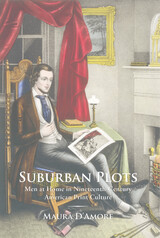 Suburban Plots: Men at Home in Nineteenth-Century American Print Culture
Maura D'Amore
University of Massachusetts Press, 2014 In the middle of the nineteenth century, as Americans contended with rapid industrial and technological change, readers relied on periodicals and books for information about their changing world. Within this print culture, a host of writers, editors, architects, and reformers urged men to commute to and from their jobs in the city, which was commonly associated with overcrowding, disease, and expense. Through a range of materials, from pattern books to novels and a variety of periodicals, men were told of the restorative effects on body and soul of the natural environment, found in the emerging suburbs outside cities such as New York, Boston, and Philadelphia. They were assured that the promise of an ideal home, despite its association with women's work, could help to motivate them to engage in the labor and commute that took them away from it each day.
In Suburban Plots, Maura D'Amore explores how Henry David Thoreau, Henry Ward Beecher, Donald Grant Mitchell, Nathaniel Hawthorne, Nathaniel Parker Willis, and others utilized the pen to plot opportunities for a new sort of male agency grounded, literarily and spatially, in a suburbanized domestic landscape. D'Amore uncovers surprising narratives that do not fit easily into standard critical accounts of midcentury home life. Taking men out of work spaces and locating them in the domestic sphere, these writers were involved in a complex process of portraying men struggling to fulfill fantasies outside of their professional lives, in newly emerging communities. These representations established the groundwork for popular conceptions of suburban domestic life that remain today.
 The Suburban Racial Dilemma: Housing and Neighborhoods
W. Dennis Keating
Temple University Press, 1994 "[Keating] chronicles efforts to break down suburban racial barriers in housing throughout the United States.... Keating's data also point up our urgent need to focus public policy on depopulated and increasingly impoverished and homogeneous urban centers. As he convincingly demonstrates, private and government attempts at suburban integration, as well as special urban integrationist projects, have achieved spotty results at best."
--Publishers Weekly
Whether through affirmative housing policies or mandatory legislation, there have been numerous efforts to integrate America's neighborhoods, especially the historically white, affluent suburbs. Though much of suburbia has rejected such measures out of a fear of losing their communities to an influx of low-income, inner-city, and primarily African American residents, several metropolitan areas have been successful in creating greater racial diversity. W. Dennis Keating documents the desirability, feasibility, and legality of implementing housing diversity policies in the suburbs.
At the heart of this book is the troubling dilemma that the private housing market will inevitably resist race-conscious policies that can be effective only if embraced and supported by individual home buyers and renters, politicians, realtors, financial institutions, and insurers. In the Cleveland, Ohio, metropolitan area, pro-integrative policies have resulted in some examples of long-term racial diversity, particularly in Cleveland Heights and Shaker Heights.
Keating compares Cleveland's suburbs to suburbs around the country that have both failed and succeeded in reducing housing discrimination. While there have been occasional fair housing victories over the last three decades, Keating's analysis points toward strategies for greater progress in the future.
 Suburban Remix: Creating the Next Generation of Urban Places
Edited by Jason Beske and David Dixon
Island Press, 2018 The suburban dream of a single-family house with a white picket fence no longer describes how most North Americans want to live. The dynamics that powered sprawl have all but disappeared. Instead, new forces are transforming real estate markets, reinforced by new ideas of what constitutes healthy and environmentally responsible living. Investment has flooded back to cities because dense, walkable, mixed-use urban environments offer choices that support diverse dreams. Auto-oriented, single-use suburbs have a hard time competing.
Suburban Remix brings together experts in planning, urban design, real estate development, and urban policy to demonstrate how suburbs can use growing demand for urban living to renew their appeal as places to live, work, play, and invest. The case studies and analyses show how compact new urban places are already being created in suburbs to produce health, economic, and environmental benefits, and contribute to solving a growing equity crisis.
Above all, Suburban Remix shows that suburbs can evolve and thrive by investing in the methods and approaches used successfully in cities. Whether next-generation suburbs grow from historic village centers (Dublin, Ohio) or emerge de novo in communities with no historic center (Tysons, Virginia), the stage is set for a new chapter of development—suburbs whose proudest feature is not a new mall but a more human-scale feel and form.
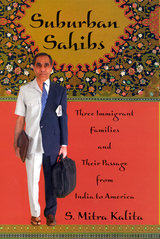 Suburban Sahibs
Kalita, S. Mitra
Rutgers University Press, 2003 From movie theaters showing the songs and gyrations of “Bollywood” to valedictorians named Patel and Shah, signs are everywhere that Middlesex County, New Jersey is home to one of the largest Indian populations in the world outside India. By tracing the migration of three families, this book delves into how immigration has altered the American suburb, and how the suburb, in turn, has altered the immigrant.
In this updated edition, journalist S. Mitra Kalita shows that although the reception from long-time residents has not been entirely welcoming, Indians have come to achieve economic success and their desire for political and social parity continues to grow stronger. She traces the evolution of the suburb from a destination for new arrivals to a launching pad for them.
In the late nineteenth century, tourists descended upon Edison to gawk at its Christmas lights displays. Today, thousands of Indians from all over the United States arrive in the same bedroom community to celebrate their own festivals of lights and colors. Suburban Sahibs attempts to answer the question of how and why they arrived, and offers a window into what America has become: a nation of suburbs as well as a nation of immigrants.
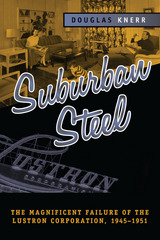 SUBURBAN STEEL: The Magnificent Failure of the Lustron Corporation, 1945–1951
Douglas Knerr
Ohio State University Press, 2004 Suburban Steel chronicles the rise and fall of the Lustron Corporation, once the largest and most completely industrialized housing company in U.S. history. Beginning in 1947, Lustron manufactured porcelain-enameled steel houses in a one-million-square-foot plant in Columbus, Ohio. With forty million dollars in federal funds and support from the highest levels of the Truman administration, the company planned to produce one hundred houses per day, each neatly arranged on specially designed tractor-trailers for delivery throughout the country. Lustron’s unprecedented size and scope of operations attracted intense scrutiny. The efficiencies of uninterrupted production, integrated manufacturing, and economies of scale promised to lead the American housing industry away from its decentralized, undercapitalized, and inefficient past toward a level of rationalization and organization found in other sectors of the industrial economy. The company’s failure marked a watershed in the history of the American housing industry. Although people did not quit talking about industrialized housing, enthusiasm for its role in the transformation of the housing industry at large markedly waned. Suburban Steel considers Lustron’s magnificent failure in the context of historical approaches to the nation’s perpetual shortage of affordable housing, arguing that had Lustron’s path not been interrupted, affordable and desirable housing for America’s masses would be far more prevalent today.
 Suburban Sweatshops: The Fight for Immigrant Rights
Jennifer Gordon
Harvard University Press, 2007 Jorge Bonilla is hospitalized with pneumonia from sleeping at the restaurant where he works, unable to afford rent on wages of thirty cents an hour. Domestic worker Yanira Juarez discovers she has labored for six months with no wages at all; her employer lied about establishing a savings account for her. We live in an era of the sweatshop reborn.
In 1992 Jennifer Gordon founded the Workplace Project to help immigrant workers in the underground suburban economy of Long Island, New York. In a story of gritty determination and surprising hope, she weaves together Latino immigrant life and legal activism to tell the unexpected tale of how the most vulnerable workers in society came together to demand fair wages, safe working conditions, and respect from employers. Immigrant workers--many undocumented--won a series of remarkable victories, including a raise of thirty percent for day laborers and a domestic workers' bill of rights. In the process, they transformed themselves into effective political participants.
Gordon neither ignores the obstacles faced by such grassroots organizations nor underestimates their very real potential for fundamental change. This revelatory work challenges widely held beliefs about the powerlessness of immigrant workers, what a union should be, and what constitutes effective lawyering. It opens up exciting new possibilities for labor organizing, community building, participatory democracy, legal strategies, and social justice.
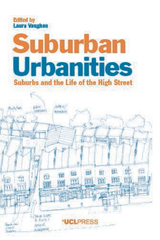 Suburban Urbanities: Suburbs and the Life of the High Street
Edited by Laura Vaughan
University College London, 2015 Suburban space has traditionally been understood as a formless remnant of physical city expansion, without a dynamic or logic of its own. Suburban Urbanities challenges this view by defining the suburb as a temporally evolving feature of urban growth. Anchored in the architectural research discipline of space syntax, this book offers a comprehensive understanding of urban change, touching on the history of the suburb as well as its current development challenges, with a particular focus on suburban centres. Studies of the high street as a centre for social, economic and cultural exchange provide evidence for its critical role in sustaining local centres over time. Contributors from the architecture, urban design, geography, history and anthropology disciplines examine cases spanning Europe and around the Mediterranean. By linking large-scale city mapping, urban design scale expositions of high street activity and local-scale ethnographies, the book underscores the need to consider suburban space on its own terms as a specific and complex field of social practice
The Subversion of Romance in the Novels of Barbara Pym
Tsagaris
University of Wisconsin Press, 1998 This book seeks to explore how Barbara Pym subverts the discourse of the romance novel through her use of food, clothes, heroine and hero characterizations, and marriage customs.
 The Subversion of the Apocalypses in the Book of Jubilees
Todd R. Hanneken
SBL Press, 2012 In spite of some scholars’ inclination to include the book of Jubilees as another witness to “Enochic Judaism,” the relationship of Jubilees to the apocalyptic writings and events surrounding the Maccabean revolt has never been adequately clarified. This book builds on scholarship on genre to establish a clear pattern among the ways Jubilees resembles and differs from other apocalypses. Jubilees matches the apocalypses of its day in overall structure and literary morphology. Jubilees also uses the literary genre to raise the issues typical of the apocalypses—including revelation, angels and demons, judgment, and eschatology—but rejects what the apocalypses typically say about those issues, subverting reader expectations with a corrected view. In addition to the main argument concerning Jubilees, this volume’s survey of what is fundamentally apocalyptic about apocalyptic literature advances the understanding of early Jewish apocalyptic literature and, in turn, of later apocalypses and comparable perspectives, including those of Paul and the Qumran sectarians.
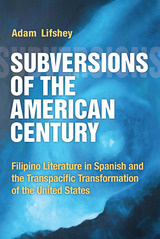 Subversions of the American Century: Filipino Literature in Spanish and the Transpacific Transformation of the United States
Adam Lifshey
University of Michigan Press, 2016 Subversions of the American Century: Filipino Literature in Spanish and the Transpacific Transformation of the United States argues that the moment the United States became an overseas colonial power in 1898, American national identity was redefined across a global matrix. The Philippines, which the United States seized at that point from Spain and local revolutionaries, is therefore the birthplace of a new kind of America, one with a planetary reach that was, most profoundly, accompanied by resistance to that reach by local peoples. Post-1898 Filipino literature in Spanish testifies crucially to this foregrounding fact of American global power, for it is the language of that tradition that speaks directly to the reality of one empire having wrested land from another. Yet this literature is invisible in American Studies programs, Asian Studies programs, Spanish and English departments, and everywhere else. Subversions of the American Century will change that. After Subversions, students and scholars in various American Studies disciplines as well as Asian, Spanish, and Comparative Literature fields will find it necessary to revisit and revamp the basic parameters by which they approach their subjects.
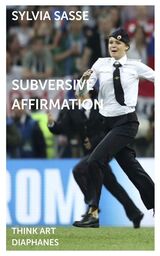 Subversive Affirmation: Critique of Critique Revisited
Sylvia Sasse
Diaphanes, 2025 An analysis of the concept of subversive affirmation, a radical alternative to saying “no” as a form of resistance.
Since the 1960s, theory, the arts, and political activism have increasingly rejected the notion of resistance through negation, raising such arguments as: Doesn’t a critique based on negation make itself dependent on the very system it wants to overcome? Does it not remain trapped in a thinking of oppositions? Although coming from radically different angles, the formulation of concepts like subversive affirmation, hyperaffirmation, overidentification, paradoxical intervention, revolution of the yes, and affirmative sabotage all reflect the emergence of an affirmative critique that overcomes this negation while also making us aware of the difference between conscious consent and conformity, capitulation, indifference, or pragmatism. In her new book, Sylvia Sasse explores and analyzes subversive affirmation as a critical practice in different political systems. She examines the effectiveness of such criticism and its relevance at a time when various political actors have begun appropriating subversive affirmation and are no longer using it as a method of criticism.
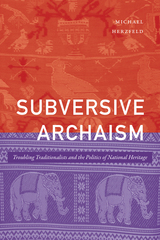 Subversive Archaism: Troubling Traditionalists and the Politics of National Heritage
Michael Herzfeld
Duke University Press, 2021 In Subversive Archaism, Michael Herzfeld explores how individuals and communities living at the margins of the modern nation-state use nationalist discourses of tradition to challenge state authority under both democratic and authoritarian governments. Through close attention to the claims and experiences of mountain shepherds in Greece and urban slum dwellers in Thailand, Herzfeld shows how these subversive archaists draw on national histories and past polities to claim legitimacy for their defiance of bureaucratic authority. Although vilified by government authorities as remote, primitive, or dangerous—often as preemptive justification for violent repression—these groups are not revolutionaries and do not reject national identity, but they do question the equation of state and nation. Herzfeld explores the political strengths and vulnerabilities of their deployment of heritage and the weaknesses they expose in the bureaucratic and ethnonational state in an era of accelerated globalization.
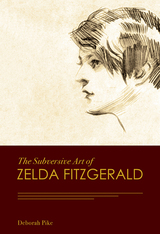 The Subversive Art of Zelda Fitzgerald
Deborah Pike
University of Missouri Press, 2017 This book gives light to the multiple artistic expressions of Great Gatsby-writer’s wife as modernist vanguard.
Known as an icon of the Jazz Age, a flamboyant socialite, and the mad wife of F. Scott, Zelda Fitzgerald has inspired studies of her life and work which focus on her earlier years, and on the myth of the glorious-but-doomed woman. As an unprecedented study of the totality Zelda Fitzgerald’s creative work, this book makes an important contribution to the history of women’s art with new perspectives on women and modernity, plagiarism, creative partnership, and the nature of mental illness.
Zelda Fitzgerald’s creative output was astonishing, considering the conditions under which she lived, and the brevity of her life: she wrote dozens of short stories, several journalistic pieces, a play, two novels, hundreds of letters, kept diaries and produced hundreds of artworks. Employing a new mode of literary analysis that draws upon critics, theorists, and historians to situate her work in its context, The Subversive Art of Zelda Fitzgerald rehabilitates the literary and artistic status of Zelda Fitzgerald by reassessing her life and writings in the light of archival sources. Such materials include medical and psychiatric documents; her unpublished novel; an artistic and spiritual diary; and over one hundred letters written from asylums.
While much of her writing can be read as a tactical response to her husband’s injunctions against her creativity, it can also be read as brilliant work in its own right. Far from imitating Scott’s style, Zelda Fitzgerald’s artistic output is vibrantly alive and utterly her own.
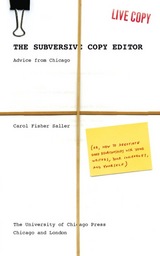 The Subversive Copy Editor: Advice from Chicago (or, How to Negotiate Good Relationships with Your Writers, Your Colleagues, and Yourself)
Carol Fisher Saller
University of Chicago Press, 2009
Each year writers and editors submit over three thousand grammar and style questions to the Q&A page at The Chicago Manual of Style Online. Some are arcane, some simply hilarious—and one editor, Carol Fisher Saller, reads every single one of them. All too often she notes a classic author-editor standoff, wherein both parties refuse to compromise on the "rights" and "wrongs" of prose styling: "This author is giving me a fit." "I wish that I could just DEMAND the use of the serial comma at all times." "My author wants his preface to come at the end of the book. This just seems ridiculous to me. I mean, it’s not a post-face."
In The Subversive Copy Editor, Saller casts aside this adversarial view and suggests new strategies for keeping the peace. Emphasizing habits of carefulness, transparency, and flexibility, she shows copy editors how to build an environment of trust and cooperation. One chapter takes on the difficult author; another speaks to writers themselves. Throughout, the focus is on serving the reader, even if it means breaking "rules" along the way. Saller’s own foibles and misadventures provide ample material: "I mess up all the time," she confesses. "It’s how I know things."
Writers, Saller acknowledges, are only half the challenge, as copy editors can also make trouble for themselves. (Does any other book have an index entry that says "terrorists. See copy editors"?) The book includes helpful sections on e-mail etiquette, work-flow management, prioritizing, and organizing computer files. One chapter even addresses the special concerns of freelance editors.
Saller’s emphasis on negotiation and flexibility will surprise many copy editors who have absorbed, along with the dos and don’ts of their stylebooks, an attitude that their way is the right way. In encouraging copy editors to banish their ignorance and disorganization, insecurities and compulsions, the Chicago Q&A presents itself as a kind of alter ego to the comparatively staid Manual of Style. In The Subversive Copy Editor, Saller continues her mission with audacity and good humor.
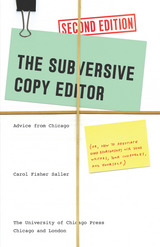 The Subversive Copy Editor, Second Edition: Advice from Chicago (or, How to Negotiate Good Relationships with Your Writers, Your Colleagues, and Yourself)
Carol Fisher Saller
University of Chicago Press, 2016 Longtime manuscript editor and Chicago Manual of Style guru Carol Fisher Saller has negotiated many a standoff between a writer and editor refusing to compromise on the “rights” and “wrongs” of prose styling. Saller realized that when these sides squared off, it was often the reader who lost. In her search for practical strategies for keeping the peace, The Subversive Copy Editor was born. Saller’s ideas struck a chord, and the little book with big advice quickly became a must-have reference for copy editors everywhere.
In this second edition, Saller adds new chapters, on the dangers of allegiance to outdated grammar and style rules and on ways to stay current in language and technology. She expands her advice for writers on formatting manuscripts for publication, on self-editing, and on how not to be “difficult.” Saller’s own gaffes provide firsthand (and sometimes humorous) examples of exactly what not to do. The revised content reflects today’s publishing practices while retaining the self-deprecating tone and sharp humor that helped make the first edition so popular. Saller maintains that through carefulness, transparency, and flexibility, editors can build trust and cooperation with writers.
The Subversive Copy Editor brings a refreshingly levelheaded approach to the classic battle between writers and editors. This sage advice will prove useful and entertaining to anyone charged with the sometimes perilous task of improving the writing of others.
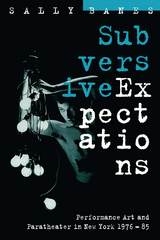 Subversive Expectations: Performance Art and Paratheater in New York, 1976-85
Sally Banes
University of Michigan Press, 1998 As critic for the Soho Weekly News and the Village Voice during the 1970s and 1980s, Sally Banes enjoyed an incomparable perspective on the development of what she describes as "the mongrel, elusive, indefinable genre of performance art." In fact, Banes was present during a crucial point in that development, when a previously marginalized form took, quite literally, center stage and emerged as the preeminent form of avant-garde activity. Her reviews and articles explore the work of established artists such as Meredith Monk, Robert Wilson, Ping Chong, and Joan Jonas; events by the Bread and Puppet Theater, Robert Whitman, Charlotte Moorman, and Chris Burden; revivals of classic avant-garde performances; and the emergence of famous (and some notorious) performers such as Anne Bogart, Karen Finley, Spalding Gray, Steve Buscemi, Tim Miller, and Whoopi Goldberg. The depth and breadth of Banes's criticism realizes not only the continuing growth and development of American performance, but also the complex and sometimes surprising intersection of performance with the "other side" of the art/life divide, the "paratheater" of Japanese tea ceremonies, cat shows, circuses, art exhibits, and amateur nights at the Apollo. Banes's work recognizes the crucial importance of the critic as a situated self that must understand not only the concepts and techniques of avant-garde art, but the rich textures of the community spaces in which that art occurs. Much as her earlier book Greenwich Village 1963: Avant-Garde Performance and the Effervescent Body captured the elusive artistic communities of America's postwar avant-garde activity, Subversive Expectations revels in the invigorating energies of Soho. The author's approach to this complex matrix of art, community, and culture is as interdisciplinary as performance itself, drawing on the histories and theories of painting, photography, dance, theater, and folklore. Her vivid descriptions of ephemeral events and her provocative interpretations fill a gap in the history of contemporary performance, when the avant-garde met the mainstream.
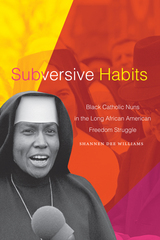 Subversive Habits: Black Catholic Nuns in the Long African American Freedom Struggle
Shannen Dee Williams
Duke University Press, 2022 In Subversive Habits, Shannen Dee Williams provides the first full history of Black Catholic nuns in the United States, hailing them as the forgotten prophets of Catholicism and democracy. Drawing on oral histories and previously sealed Church records, Williams demonstrates how master narratives of women’s religious life and Catholic commitments to racial and gender justice fundamentally change when the lives and experiences of African American nuns are taken seriously. For Black Catholic women and girls, embracing the celibate religious state constituted a radical act of resistance to white supremacy and the sexual terrorism built into chattel slavery and segregation. Williams shows how Black sisters—such as Sister Mary Antona Ebo, who was the only Black member of the inaugural delegation of Catholic sisters to travel to Selma, Alabama, and join the Black voting rights marches of 1965—were pioneering religious leaders, educators, healthcare professionals, desegregation foot soldiers, Black Power activists, and womanist theologians. In the process, Williams calls attention to Catholic women’s religious life as a stronghold of white supremacy and racial segregation—and thus an important battleground in the long African American freedom struggle.
 Subversive Intent: Gender, Politics, and the Avant-Garde
Susan Rubin Suleiman
Harvard University Press, 1990 With this important new book, Susan Suleiman lays the foundation for a postmodern feminist poetics and theory of the avant-garde. She shows how the figure of Woman, as fantasy, myth, or metaphor, has functioned in the work of male avant-garde writers and artists of this century. Focusing also on women's avant-garde artistic practices, Suleiman demonstrates how to read difficult modern works in a way that reveals their political as well as their aesthetic impact.
Suleiman directly addresses the subversive intent of avant-garde movements from Surrealism to postmodernism. Through her detailed readings of provocatively transgressive works by André Breton, Georges Bataille, Roland Barthes, Alain Robbe-Grillet, Marcel Duchamp, Max Ernst, and others, Suleiman demonstrates the central role of the female body in the male erotic imagination and illuminates the extent to which masculinist assumptions have influenced modern art and theory. By examining the work of contemporary women avantgarde artists and theorists--including Hélène Cixous, Marguerite Duras, Monique Wittig, Luce Irigaray, Angela Carter, Jeanette Winterson, Leonora Carrington, Barbara Kruger, Jenny Holzer, and Cindy Sherman--Suleiman shows the political power of feminist critiques of patriarchal ideology, and especially emphasizes the power of feminist humor and parody.
Central to Suleiman's revisionary theory of the avant-garde is the figure of the playful, laughing mother. True to the radically irreverent spirit of the historical avant-gardes and their postmodernist successors, Suleiman's laughing mother embodies the need for a link between symbolic innovation and political and social change.
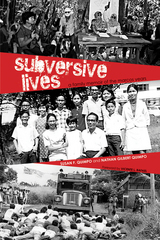 Subversive Lives: A Family Memoir of the Marcos Years
Susan F. Quimpo
Ohio University Press, 2016 From the 1960s to the 1990s, seven members of the Quimpo family dedicated themselves to the anti-Marcos resistance in the Philippines, sometimes at profound personal cost. In this unprecedented memoir, eight siblings (plus one by marriage) tell their remarkable stories in individually authored chapters that comprise a family saga of revolution, persistence, and, ultimately, vindication, even as easy resolution eluded their struggles. Subversive Lives tells of attempts to smuggle weapons for the New People’s Army (the armed branch of the Communist Party of the Philippines); of heady times organizing uprisings and strikes; of the cruel discovery of one brother’s death and the inexplicable disappearance of another (now believed to be dead); and of imprisonment and torture by the military. These stories show the sacrifices and daily heroism of those in the movement. But they also reveal its messy legacies: sons alienated from their father; daughters abused by the military; friends betrayed; and revolutionary affection soured by intractable ideological differences. The rich and distinctive contributions span the martial law years of Ferdinand Marcos’s rule. Subversive Lives is a riveting and accessible primer for those unfamiliar with the era, and a resonant history for those with a personal connection to what it meant to be Filipino at that time, or for anyone who has fought political repression.
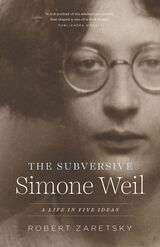 The Subversive Simone Weil: A Life in Five Ideas
Robert Zaretsky
University of Chicago Press, 2021 Known as the “patron saint of all outsiders,” Simone Weil (1909–43) was one of the twentieth century’s most remarkable thinkers, a philosopher who truly lived by her political and ethical ideals. In a short life framed by the two world wars, Weil taught philosophy to lycée students and organized union workers, fought alongside anarchists during the Spanish Civil War and labored alongside workers on assembly lines, joined the Free French movement in London and died in despair because she was not sent to France to help the Resistance.
Though Weil published little during her life, after her death, thanks largely to the efforts of Albert Camus, hundreds of pages of her manuscripts were published to critical and popular acclaim. While many seekers have been attracted to Weil’s religious thought, Robert Zaretsky gives us a different Weil, exploring her insights into politics and ethics, and showing us a new side of Weil that balances her contradictions—the rigorous rationalist who also had her own brand of Catholic mysticism; the revolutionary with a soft spot for anarchism yet who believed in the hierarchy of labor; and the humanitarian who emphasized human needs and obligations over human rights. Reflecting on the relationship between thought and action in Weil’s life, The Subversive Simone Weil honors the complexity of Weil’s thought and speaks to why it matters and continues to fascinate readers today.
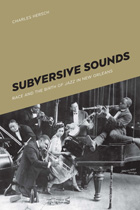 Subversive Sounds: Race and the Birth of Jazz in New Orleans
Charles B. Hersch
University of Chicago Press, 2008 Subversive Sounds probes New Orleans’s history, uncovering a web of racial interconnections and animosities that was instrumental to the creation of a vital American art form—jazz. Drawing on oral histories, police reports, newspaper accounts, and vintage recordings, Charles Hersch brings to vivid life the neighborhoods and nightspots where jazz was born. This volume shows how musicians such as Jelly Roll Morton, Nick La Rocca, and Louis Armstrong negotiated New Orleans’s complex racial rules to pursue their craft and how, in order to widen their audiences, they became fluent in a variety of musical traditions from diverse ethnic sources. These encounters with other music and races subverted their own racial identities and changed the way they played—a musical miscegenation that, in the shadow of Jim Crow, undermined the pursuit of racial purity and indelibly transformed American culture. “More than timely . . . Hersch orchestrates voices of musicians on both sides of the racial divide in underscoring how porous the music made the boundaries of race and class.”—New Orleans Times-Picayune
 Subversive Stages: Theater in Pre- and Post-Communist Hungary, Romania and Bulgaria
Ileana Alexandra Orlich
Central European University Press, 2017 Exploring theater practices in communist and post-communist Hungary, Romania and Bulgaria, this book analyzes intertextuality or "inter-theatricality" as a political strategy, designed to criticize contemporary political conditions while at the same time trying to circumvent censorship. Plays by Romanian, Hungarian and Bulgarian dramatists are examined, who are "retrofitting" the past by adapting the political crimes and horrifying tactics of totalitarianism to the classical theatre (with Shakespeare a favorite) to reveal the region's traumatic history. By the sustained analysis of the aesthetic devices used as political tools, Orlich makes a very strong case for the continued relevance of the theater as one of the subtlest media in the public sphere. She embeds her close readings in a thorough historical analysis and displays a profound knowledge of the political role of theater history. In the Soviet bloc the theater of the absurd, experimentation, irony, and intertextual distancing (estrangement) are not seen as mere aesthetic language games but as political strategies that use indirection to say what cannot be said directly.
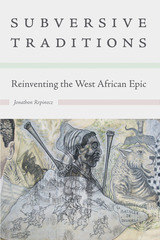 Subversive Traditions: Reinventing the West African Epic
Jonathon Repinecz
Michigan State University Press, 2019 How can traditions be subversive? The kinship between African traditions and novels has been under debate for the better part of a century, but the conversation has stagnated because of a slowness to question the terms on which it is based: orality vs. writing, tradition vs. modernity, epic vs. novel. These rigid binaries were, in fact, invented by colonialism and cemented by postcolonial identity politics. Thanks to this entrenched paradigm, far too much ink has been poured into the so-called Great Divide between oral and writing societies, and to the long-lamented decline of the ways of old. Given advances in social science and humanities research—studies in folklore, performance, invented traditions, colonial and postcolonial ethnography, history, and pop culture—the moment is right to rewrite this calcified literary history. This book is not another story of subverted traditions, but of subversive ones. West African epics like Sunjata, Samori, and Lat-Dior offer a space from which to think about, and criticize, the issues of today, just as novels in European languages do. Through readings of documented performances and major writers like Yambo Ouologuem and Amadou Hampâté Bâ of Mali, Ahmadou Kourouma of Ivory Coast, and Aminata Sow Fall and Boubacar Boris Diop of Senegal, this book conducts an entirely new analysis of West African oral epic and its relevance to contemporary world literature.
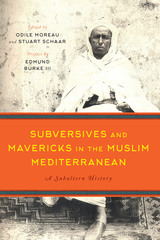 Subversives and Mavericks in the Muslim Mediterranean: A Subaltern History
Edited by Odile Moreau and Stuart Schaar; preface by Edmund Burke III
University of Texas Press, 2016 Subaltern studies, the study of non-elite or underrepresented people, have revolutionized the writing of Middle Eastern history. Subversives and Mavericks in the Muslim Mediterranean represents the next step in this transformation. The book explores the lives of eleven nonconformists who became agents of political and social change, actively organizing new forms of resistance—against either colonial European regimes or the traditional societies in which they lived—that disrupted the status quo, in some cases, with dramatic results. These case studies highlight cross-border connections in the Mediterranean world, exploring how these channels were navigated. Chapters in the book examine the lives of subversives and mavericks, such as Tawhida ben Shaykh, the first Arab woman to receive a medical degree; Mokhtar al-Ayari, a radical Tunisian labor leader; Nazli Hanem, Kmar Bayya, and Khiriya bin Ayyad, three aristocractic women who resisted the patriarchal structures of their societies by organizing and participating in intellectual salons for men and women and advocating social reform; Qaid Najim al-Akhsassi, an ex-slave and military officer, who fought against French and Spanish colonial expansion; and Boubeker al-Ghandjawi, a nearly illiterate trader who succeeded, though his diverse connections, in establishing important relations between the Moroccan sultan and the representative of the British government. Although based on individual and local perspectives, Subversives and Mavericks in the Muslim Mediterranean reveals new and unrecognized trans-local connections across the Muslim world, illuminating our understanding of these societies beyond narrow elite circles.
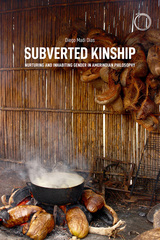 Subverted Kinship: Nurturing and Inhabiting Gender in Amerindian Philosophy
Diego Madi Dias
HAU, 2020 Through a rich narrative ethnography of domestic life, this book explores the philosophy of social relations among the Guna (Cuna), an Amerindian people of Panama. This intimate study brings us into the heart of the family economy, describing its nuanced interactions among coresidents through two dimensions: an aesthetic of production resting on the gendered division of labor and an ethic of affects informing the language and enactment of kinship. By exploring local techniques of nurture—child-rearing, singing, feeding, and care practices—the book shows how the Guna create kinship and inhabit gender. The acceptance the Guna show for same-sex relationships and cross-gender roles—which they accorded to the author himself—allows kinship to be both subverted and affirmed at the same time. Subverting kinship does not undermine the structure or dynamics of residential interrelations; on the contrary, it dramatically foregrounds kinship as a lived experience of reciprocal nurture, thus enabling gender to be modulated, and inhabited in multiple ways.
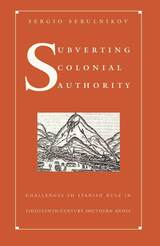 Subverting Colonial Authority: Challenges to Spanish Rule in Eighteenth-Century Southern Andes
Sergio Serulnikov
Duke University Press, 2003 This innovative political history provides a new perspective on the enduring question of the origins and nature of the Indian revolts against the Spanish that exploded in the southern Andean highlands in the 1780s. Subverting Colonial Authority focuses on one of the main—but least studied—centers of rebel activity during the age of the Túpac Amaru revolution: the overwhelmingly indigenous Northern Potosí region of present-day Bolivia. Tracing how routine political conflict developed into large-scale violent upheaval, Sergio Serulnikov explores the changing forms of colonial domination and peasant politics in the area from the 1740s (the starting point of large political and economic transformations) through the early 1780s, when a massive insurrection of the highland communities shook the foundations of Spanish rule. Drawing on court records, government papers, personal letters, census documents, and other testimonies from Bolivian and Argentine archives, Subverting Colonial Authority addresses issues that illuminate key aspects of indigenous rebellion, European colonialism, and Andean cultural history. Serulnikov analyzes long-term patterns of social conflict rooted in local political cultures and regionally based power relations. He examines the day-to-day operations of the colonial system of justice within the rural villages as well as the sharp ideological and political strife among colonial ruling groups. Highlighting the emergence of radical modes of anticolonial thought and ethnic cooperation, he argues that Andean peasants were able to overcome entrenched tendencies toward internal dissension and fragmentation in the very process of marshaling both law and force to assert their rights and hold colonial authorities accountable. Along the way, Serulnikov shows, they not only widened the scope of their collective identities but also contradicted colonial ideas of indigenous societies as either secluded cultures or pliant objects of European rule.
 Subway City: Riding the Trains, Reading New York
Brooks, Michael
Rutgers University Press, 1997 None of the world's great cities is as closely identified with its subway as New York. Its trains provide much more than just rapid transit. They give New Yorkers a powerful symbol of their metropolis, one that they use to express both their hopes and their fears for the urban future. Subway City explores New York's transit system as both fact and metaphor. Brooks traces the development of the subway from its inception as the newest and most efficient public transportation system to its decline as an overcrowded and dangerous part of city life. The crowded cars gave Harold Lloyd material for comedy, fueled William Randolph Hearst's crusade against the Traction Trust, and convinced Lewis Mumford that the subway was a futile effort to solve the city's problems. Brooks explores films which have dramatized the dangers lurking below ground, and examines the infamous Bernhard Goetz shooting that made the subway a symbol of urban decay. More hopefully, he describes the Metropolitan Transportation Authority's station improvements and ambitious programs for Music Underground, Poetry in Transit, and Arts-in-Transit, as keys to the city's renewal.
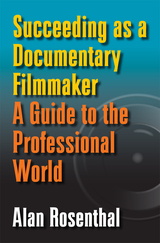 Succeeding as a Documentary Filmmaker: A Guide to the Professional World
Alan Rosenthal
Southern Illinois University Press, 2011 While many film programs prepare students for the realities of Hollywood, comparatively little guidance is provided for the aspiring documentary filmmaker. Alan Rosenthal fills this void with Succeeding as a Documentary Filmmaker: A Guide to the Professional World. Unlike traditional manuals on documentary filmmaking, which focus primarily on the creation of films, this user-friendly volume draws upon real-world examples and the advice of experienced filmmakers to provide essential information about the nonfiction movie business. From the basics of the current film business environment and how to navigate it, to tips on how to maximize distribution and sales for a finished film, Rosenthal leads novice filmmakers step-by-step through the professional arena of documentary moviemaking. Included here are recommendations for how to make the most of a film school education; the best ways to find financing for a film and the realities of working with a budget; how to develop a successful proposal for a project; the intricacies of working both as an independent filmmaker and for others; and insight into the often complicated arenas of contracts and markets. Throughout the volume, Rosenthal shares the expertise of actual filmmakers on such subjects as film school and starting a career; pitching and funding projects; contract negotiation; effective marketing; and commissioning editors and legal help. Not limiting himself to merely the documentary world, the author also offers valuable information and advice for filmmakers interested in other genres of nonfiction movies - such as industrial, public relations, travel, and educational films - to provide a truly comprehensive and one-of-a-kind guide for readers. Packed with useful tips for novices, film students, and practitioners alike, Succeeding as a Documentary Filmmaker is an indispensable addition to the library of anyone involved in the world of nonfiction filmmaking.
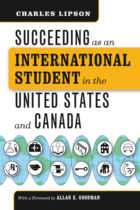 Succeeding as an International Student in the United States and Canada
Charles Lipson
University of Chicago Press, 2008 Each year, 700,000 students from around the world come to the United States and Canada to study. For many, the experience is as challenging as it is exciting. Far from home, they must adapt to a new culture, new university system, and in many cases, a new language. The process can be overwhelming, but as Charles Lipson’s Succeeding as an International Student in the United States and Canada assures us, it doesn’t have to be.
Succeeding is designed to help students navigate the myriad issues they will encounter—from picking a program to landing a campus job. Based on Lipson’s work with international students as well as extensive interviews with faculty and advisers, Succeeding includes practical suggestions for learning English, participating in class, and meeting with instructors. In addition it explains the rules of academic honesty as they are understood in U.S. and Canadian universities.
Life beyond the classroom is also covered, with handy sections on living on or off campus, obtaining a driver’s license, setting up a bank account, and more. The comprehensive glossary addresses both academic terms and phrases heard while shopping or visiting a doctor. There is even a chapter on the academic calendar and holidays in the United States and Canada. Coming to a new country to study should be an exciting venture, not a baffling ordeal. Now, with this trustworthy resource, international students have all the practical information they need to succeed, in and out of the classroom.
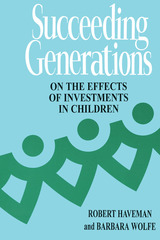 Succeeding Generations: On the Effects of Investments in Children
Robert Haveman
Russell Sage Foundation, 1994 Drawn from an extensive two-decade longitudinal survey of American families, Succeeding Generations traces a representative group of America's children from their early years through young adulthood. It evaluates the many background factors that are most influential in determining how much education children will obtain, whether or not they will become teen parents, and how economically active they will be when they reach their twenties. Succeeding Generations demonstrates how our children's future has been placed at risk by social and economic conditions such as fractured families, a troubled economy, rising poverty rates, and neighborhood erosion. The authors also pinpoint some significant causes of children's later success, emphasizing the importance of parents' education and, despite the apparent loss of time spent with children, the generally positive influence of maternal employment. Haveman and Wolfe supplement their research with a comprehensive review of the many debates among economists, sociologists, developmental psychologists, and other experts on how best to improve the lot of America's children. "A state-of-the-art investigation of the determinants of children's success in the United States....Clearly written, highly readable, and compelling."—Contemporary Sociology "Haveman and Wolfe are professors of economics who bring sophisticated statistical and econometric techniques to the analysis of the economic and educational success of children as they progress into young adulthood."—Choice "This study is one of the most comprehensive of its kind, in part because the researchers collected detailed information about a wide range of children each year for more than two decades." —Wisconsin State Journal "The research at the core of this book addresses critically important questions in social science...an important contribution to the literature." —Robert Plotnick, University of Washington
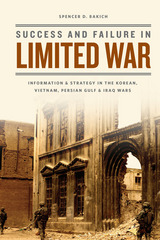 Success and Failure in Limited War: Information and Strategy in the Korean, Vietnam, Persian Gulf, and Iraq Wars
Spencer D. Bakich
University of Chicago Press, 2014 Common and destructive, limited wars are significant international events that pose a number of challenges to the states involved beyond simple victory or defeat. Chief among these challenges is the risk of escalation—be it in the scale, scope, cost, or duration of the conflict. In this book, Spencer D. Bakich investigates a crucial and heretofore ignored factor in determining the nature and direction of limited war: information institutions.
Traditional assessments of wartime strategy focus on the relationship between the military and civilians, but Bakich argues that we must take into account the information flow patterns among top policy makers and all national security organizations. By examining the fate of American military and diplomatic strategy in four limited wars, Bakich demonstrates how not only the availability and quality of information, but also the ways in which information is gathered, managed, analyzed, and used, shape a state’s ability to wield power effectively in dynamic and complex international systems.
Utilizing a range of primary and secondary source materials, Success and Failure in Limited War makes a timely case for the power of information in war, with crucial implications for international relations theory and statecraft.
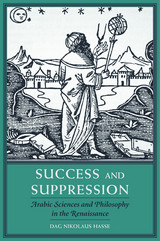 Success and Suppression: Arabic Sciences and Philosophy in the Renaissance
Dag Nikolaus Hasse
Harvard University Press, 2016 The Renaissance marked a turning point in Europe’s relationship to Arabic thought. On the one hand, Dag Nikolaus Hasse argues, it was the period in which important Arabic traditions reached the peak of their influence in Europe. On the other hand, it is the time when the West began to forget, and even actively suppress, its debt to Arabic culture. Success and Suppression traces the complex story of Arabic influence on Renaissance thought.
It is often assumed that the Renaissance had little interest in Arabic sciences and philosophy, because humanist polemics from the period attacked Arabic learning and championed Greek civilization. Yet Hasse shows that Renaissance denials of Arabic influence emerged not because scholars of the time rejected that intellectual tradition altogether but because a small group of anti-Arab hard-liners strove to suppress its powerful and persuasive influence. The period witnessed a boom in new translations and multivolume editions of Arabic authors, and European philosophers and scientists incorporated—and often celebrated—Arabic thought in their work, especially in medicine, philosophy, and astrology. But the famous Arabic authorities were a prominent obstacle to the Renaissance project of renewing European academic culture through Greece and Rome, and radical reformers accused Arabic science of linguistic corruption, plagiarism, or irreligion. Hasse shows how a mixture of ideological and scientific motives led to the decline of some Arabic traditions in important areas of European culture, while others continued to flourish.
 Success and Understanding
Jean Piaget
Harvard University Press, 1978 Jean Piaget has spent a major part of his life work showing how thought is fundamentally derived from action. In Success and Understanding, this master psychologist inverts the question for the first time and considers how action is controlled by thought.
In a series of ingenious experiments, children are presented with physical puzzles just difficult enough to challenge their emerging skills. Under these conditions, Piaget reveals how the child comes to use his developing conceptual system to design strategies that result in successful actions. According to Piaget, it takes time for thought and action to enter into their familiar partnership. The young child has trouble using his ideas to guide his actions and must pass through several interesting stages before he can routinely coordinate idea and act.
Success and Understanding completes the Piagetian scheme for relating thought to action that was so brilliantly initiated in The Grasp of Consciousness (Harvard, 1976). Together, the two books form a major episode in the history of Piaget's remarkable career.
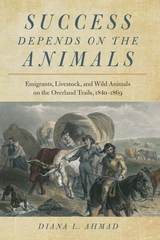 Success Depends on the Animals: Emigrants, Livestock, and Wild Animals on the Overland Trails, 1840–1869
Diana L. Ahmad
University of Nevada Press, 2016 Between 1840 and 1869, thousands of people crossed the American continent looking for a new life in the West. Success Depends on the Animals explores the relationships and encounters that these emigrants had with animals, both wild and domestic, as they traveled the Overland Trail. In the longest migration of people in history, the overlanders were accompanied by thousands of work animals such as horses, oxen, mules, and cattle. These travelers also brought dogs and other companion animals, and along the way confronted unknown wild animals.
Ahmad’s study is the first to explore how these emigrants became dependent upon the animals that traveled with them, and how, for some, this dependence influenced a new way of thinking about the human-animal bond. The pioneers learned how to work with the animals and take care of them while on the move. Many had never ridden a horse before, let alone hitched oxen to a wagon. Due to the close working relationship that the emigrants were forced to have with these animals, many befriended the domestic beasts of burden, even attributing human characteristics to them.
Drawing on primary sources such as journals, diaries, and newspaper accounts, Ahmad explores how these new experiences influenced fresh ideas about the role of animals in pioneer life. Scholars and students of western history and animal studies will find this a fascinating and distinctive analysis of an understudied topic.
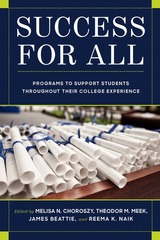 Success for All: Programs to Support Students Throughout Their College Experience
Melisa N. Choroszy
University of Nevada Press, 2019 While the most important measure of success for many degree-seeking students is the timely attainment of a Bachelor’s degree, there remains a host of other indicators of student success that vary by student population and students’ personal goals. Many of these smaller successes lead to the ultimate goal of graduation and are significant triumphs throughout the journey through higher education.
Success for All is a strategic guide for administrators and educators that offers methods for advising students through the myriad of challenges they face. Every bit of success contributes to the accomplishment of a larger goal, and this book highlights success at every level. It provides a specific roadmap to the research, services, and programs at the University of Nevada, Reno and Truckee Meadows Community College that support student success in undergraduate and graduate programs regardless of a student’s social, emotional, or prior academic experiences. Contributors discuss how to make students feel welcome in their social and educational environments and how to directly assist them with the timely completion of their degree. Administrators and educators demonstrate how these programs help make a positive contribution to the students and the institutions they serve while implementing practical solutions to increase graduation rates.
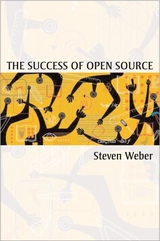 The Success of Open Source
Steven Weber
Harvard University Press, 2004 Much of the innovative programming that powers the Internet, creates operating systems, and produces software is the result of “open source” code, that is, code that is freely distributed—as opposed to being kept secret—by those who write it. Leaving source code open has generated some of the most sophisticated developments in computer technology, including, most notably, Linux and Apache, which pose a significant challenge to Microsoft in the marketplace. As Steven Weber discusses, open source’s success in a highly competitive industry has subverted many assumptions about how businesses are run, and how intellectual products are created and protected.
Traditionally, intellectual property law has allowed companies to control knowledge and has guarded the rights of the innovator, at the expense of industry-wide cooperation. In turn, engineers of new software code are richly rewarded; but, as Weber shows, in spite of the conventional wisdom that innovation is driven by the promise of individual and corporate wealth, ensuring the free distribution of code among computer programmers can empower a more effective process for building intellectual products. In the case of Open Source, independent programmers—sometimes hundreds or thousands of them—make unpaid contributions to software that develops organically, through trial and error.
Weber argues that the success of open source is not a freakish exception to economic principles. The open source community is guided by standards, rules, decisionmaking procedures, and sanctioning mechanisms. Weber explains the political and economic dynamics of this mysterious but important market development.
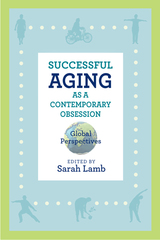 Successful Aging as a Contemporary Obsession: Global Perspectives
Lamb, Sarah
Rutgers University Press, 2017 In recent decades, the North American public has pursued an inspirational vision of successful aging—striving through medical technique and individual effort to eradicate the declines, vulnerabilities, and dependencies previously commonly associated with old age. On the face of it, this bold new vision of successful, healthy, and active aging is highly appealing. But it also rests on a deep cultural discomfort with aging and being old.
The contributors to Successful Aging as a Contemporary Obsession explore how the successful aging movement is playing out across five continents. Their chapters investigate a variety of people, including Catholic nuns in the United States; Hindu ashram dwellers; older American women seeking plastic surgery; aging African-American lesbians and gay men in the District of Columbia; Chicago home health care workers and their aging clients; Mexican men foregoing Viagra; dementia and Alzheimer sufferers in the United States and Brazil; and aging policies in Denmark, Poland, India, China, Japan, and Uganda. This book offers a fresh look at a major cultural and public health movement of our time, questioning what has become for many a taken-for-granted goal—aging in a way that almost denies aging itself.
Successful Fisheries Management: Issues, Case Studies, Perspectives
Edited by Stephen Cunningham and Tim Bostock
Eburon Academic Publishers, 2005 More than eighty percent of the world's fish population lives in fisheries. At the same time, nearly three-quarters of the world's most important fish species face extinction due to overfishing and environmental contamination. Successful Fisheries Management explores the possibilities for effective and sustainable fisheries management across the globe. Seven case studies examine both the successes and failures of fisheries from India to Australia to Senegal. Experts in their field, the contributors offer their audience a unique and absolutely essential examination of international fisheries management.
Succession to High Office in Botswana: Three Case Studies
Jack Parson
Ohio University Press, 1990 This book examines the process through which the mantle of leadership passed from one leader to another in Botswana. It concerns the succession to high office in Botswana over the course of more than half a century from the colonial time to the present. Three case studies explore the relationship between the British colonial authorities and the tribal leaders in affirming the legitimacy of the tribal chiefs of the Bangwato tribe in the former Bechuanaland protectorate. The studies examine the succession crises of the Bangwato first in 1925 and again between 1948 to 1953 and the political changes from the Botswana National Archives contained in the appendices fully support the text.
Such a Good Man
Dustin M. Hoffman
University of Wisconsin Press, 2025 In these inventive and formally daring stories, Dustin M. Hoffman shines a light into the dark corners of American suburbia. The housepainters, contractors, formerly incarcerated carnival workers, and fathers that populate these pages are doing their best to overcome life’s brutal indifference. With brilliance and perception, Hoffman interrogates the intersections of labor and masculinity, peeling back the spackled facades of class, family, and domesticity. Such a Good Man depicts darkness, cruelty, and absurdity without flinching—and reveals the eternal human desire for intimacy, especially when it remains just out of reach.
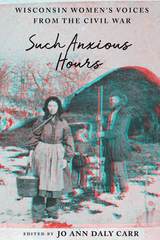 Such Anxious Hours: Wisconsin Women's Voices from the Civil War
Jo Ann Daly Carr
University of Wisconsin Press, 2020 Letters from soldiers to their families often provide prominent narratives of the Civil War. But what about the messages from the women who maintained homes and farmsteads alone, all while providing significant emotional support to their loved ones at the front? The letters and diaries of these eight women echo the ever-growing horrors of the conflict and reveal the stories of the Wisconsin home front. Twenty-one-year-old Emily Quiner sought a way to join the war effort that would feed her heart and mind. Annie Cox wrote to her pro-slavery fiancé to staunchly defend her abolitionist principles. Sisters Susan Brown and Ann Waldo faced the unexpected devastation that each battle brought to families.
In Such Anxious Hours, Jo Ann Daly Carr places this material in historical context, detailing what was happening simultaneously in the nation, state, and local communities. Civil War history enthusiasts will appreciate these enlightening perspectives that demonstrate the variety of experiences in the Midwest during the bloody conflict.
Such Rich Hour
Cole Swensen
University of Iowa Press, 2001 Covering a variety of subjects—from the plague and the first danse macabre to the development of perspective and recipes for pigments—the poems in Cole Swensen's new collection are set in fifteenth-century France and explore the end of the medieval world and its gradual transition into the Renaissance. The collection is loosely based on the calendar illuminations from the Très Riches Heures, the well-known book of hours, and uses them to explore the ways that the arts—visual and verbal—interact with history, at times prefiguring it, at times shaping it, and at times offering wry commentary or commiseration.
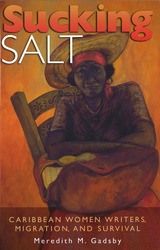 Sucking Salt: Caribbean Women Writers, Migration, and Survival
Meredith M. Gadsby
University of Missouri Press, 2006 It is a persistent image in Caribbean literature. But for Caribbean women especially, salt—particularly the image of sucking salt—has long signified how they have endured hardship and found ways to transcend it. In this study of Caribbean women writers, Meredith Gadsby examines the fiction and poetry of both emigrant and island women to explore strategies they have developed for overcoming the oppression of racism, sexism, and economic deprivation in their lives and work. She first reviews the cultural and historical significance of salt in the Caribbean, then delineates creative resistance to oppression as expressed in the literature of Caribbean women writing about their migration to the United States, Great Britain, and Canada. From British poet Dorothea Smartt to Edwidge Danticat of New York’s Haitian community—and with a special emphasis on the creative artistry of Paule Marshall—Gadsby shows how, through migration, these writers’ protagonists move into and through metropolitan spaces to create new realities for themselves, their families, and their communities. Her work draws on critical and ethnographic studies as well as creative works to take in a range of topics, not only considering the salty sexuality of calypso songs and offering new insights into Jamaican slackness culture but also plumbing her own family history to weave the travels of her mother and aunts from Barbados into her studies of migrating writers. Through these close readings, Gadsby shows that Caribbean women express complex identities born out of migration and develop practical approaches to hardship that enable them to negotiate themselves out of difficulty. Her innovative study reveals that “sucking salt” is an articulation of a New World voice connoting adaptation, improvisation, and creativity—and lending itself to new understandings of diaspora, literature, and feminism.
 Sudden Death and the Myth of CPR
Stefan Timmermans, foreword by Bern Shen
Temple University Press, 1999 Sudden Death and the Myth of CPR is for anyone who has taken a CPR course or who believes the images from television dramas. It is also for families of victims and survivors of CPR. It will engage emergency personnel, others in the medical field, and anyone concerned with ethical issues of death and dying.
Anyone who has ever taken a CPR course has wondered, "What would happen if I actually had to use CPR?" In Western societies, the lifesaving power of resuscitation has the status of a revered cultural myth. It promises life in the face of sudden death, but the reality is that lives are rarely saved. Medical researchers estimate the survival rate for out-of-hospital CPR to be between 1 and 3 percent. Sudden Death and the Myth of CPR explores the history of this medical innovation and the promotion of its effectiveness.
The overuse of resuscitation, Timmermans explains, defines people's experience with sudden death, something he learned firsthand by following the practice of lifesaving from street corner to emergency room. He argues that very few people are successfully resuscitated without brain damage despite the promotion of CPR's effectiveness through powerful media images. In vivid accounts of the day-to-day practices of cardiopulmonary resuscitation in one of the only studies o f sudden death, Timmermans records the astonishingly frank comments of emergency personnel. Doctors, nurses, social workers, and paramedics express emotions from cynicism about going through the futile motions to genuine concern for victims' family members.
If a person who was supposed to keep on living dies at the end of a resuscitative attempt, how socially meaningful is the dying? Timmermans asks tough questions and addresses the controversial ethical issues about the appropriateness of interfering with life and death. He suggests policy reform and the restoration of dignity to sudden death.
 Sudden Deaths in St. Louis: Coroner Bias in the Gilded Age
Sarah E. Lirley
Southern Illinois University Press, 2024 Honorable Mention, 2025 Society of Midland Authors Award in History!
A social history of death investigations in the urban Midwest
The scene of myriad grisly deaths, late nineteenth-century St. Louis was a hotbed for homicide, suicide, alcoholism, abortion, and workplace accidents. The role of the city’s Gilded Age coroners has not been fully examined, contextualized, or interrogated until now. Sarah E. Lirley investigates the process in which these outcomes were determined, finding coroners’ rulings were not uniform, but rather varied by who was conducting the inquest. These fascinating case studies explore the lives of the deceased, as well as their families, communities, press coverage of the events, and the coroners themselves.
Sudden Deaths in St. Louis is a study of 120 coroners’ inquests conducted between 1875 and 1885. Each chapter analyzes the typical versus the atypical in verdicts of death. At the time, inaccurate findings and cursory investigations fueled criticisms of coroner’s offices for employing poorly trained laymen. The coroners featured in this book had the power to shape public perception of the deceased, and they often relied on preexisting reputations to determine cause of death. For instance, women who worked as prostitutes were likely to be ruled as suicides, whether or not that was actually the case, and women who were respected members of their communities, particularly mothers, frequently received rulings of suicide caused by insanity. Verdicts also depended in part on availability of witnesses, including family members, to determine whether another person could be held liable for the death. Lirley’s book highlights the stories of ordinary men and women whose lives were tragically cut short, and the injustice they received even after death.
Sudden Position Guide to Cataloging & Metadata
Jeremy Myntti
American Library Association, 2021 Have you been given cataloging or metadata responsibilities in your library without formal training? Do you have experience cataloging one specific type of resource, and now you have been asked to catalog unfamiliar items? Or are you just beginning your library cataloging career and you aren’t sure where to find the help that you need? Sudden Position Guide to Cataloging and Metadata will be a good starting point to learn about the principles and standards of resource description in order to prepare you to tackle your new cataloging or metadata duties. Throughout this guide, many resources and tools are shared to help you have more success in your cataloging and metadata career.
 The Sudden Selector's Guide to Anthropology Resources
Miriam Rigby and John Russell
American Library Association, 2022 Anthropology is arguably one of the most diverse fields in academe. It ranges in focus from archaeology to evolution and primate studies, to linguistics, and to observation of current cultural practices. Methodologically, it may include any combination of lab work, library and archival research, and fieldwork. The materials vary significantly, including visual records such as film and photography, sound recordings, ancient artifacts, dusty notebooks, digital records, and biological materials. In practice it is highly interdisciplinary, intersecting with biology, political science, geography, art history, literature, religion, sociology, history, and more. Collection development for any subject can be a challenging task; anthropology, with its many subfields, may exceed the typical challenge. Whether you are brand new to anthropology, or well-versed in many of its facets, Sudden Selector’s Guide to Anthropology is designed to provide you with an access point to the diverse realms of the field and the resources that will allow you to build and maintain strong collections to serve your community, no matter where their research interests lie. The Sudden Selector’s series is designed to help library workers become acquainted with the tools, resources, individuals, and organizations that can assist in developing collections in new or unfamiliar subject areas. This guide is designed to facilitate collection development processes in two ways: it is a bibliography of resources and can be used as a mini-course in anthropology librarianship.
Sudden Shelter: UUAP 103
Jesse D. Jennings
University of Utah Press, 1980 Sudden Shelter was a prehistoric site located in Sevier County, central Utah. The University of Utah conducted a salvage investigation of this site, as it was in the right-of-way during the construction of I-70. This descriptive report summarizes the excavation and findings.
 A Sudden Terror: The Plot to Murder the Pope in Renaissance Rome
Anthony F. D'Elia
Harvard University Press, 2009 In 1468, on the final night of Carnival in Rome, Pope Paul II sat enthroned above the boisterous crowd, when a scuffle caught his eye. His guards had intercepted a mysterious stranger trying urgently to convey a warning—conspirators were lying in wait to slay the pontiff. Twenty humanist intellectuals were quickly arrested, tortured on the rack, and imprisoned in separate cells in the damp dungeon of Castel Sant’Angelo.
Anthony D’Elia offers a compelling, surprising story that reveals a Renaissance world that witnessed the rebirth of interest in the classics, a thriving homoerotic culture, the clash of Christian and pagan values, the contest between republicanism and a papal monarchy, and tensions separating Christian Europeans and Muslim Turks. Using newly discovered sources, he shows why the pope targeted the humanists, who were seen as dangerously pagan in their Epicurean morals and their Platonic beliefs about the soul and insurrectionist in their support of a more democratic Church. Their fascination with Sultan Mehmed II connected them to the Ottoman Turks, enemies of Christendom, and the love of the classical world tied them to recent rebellious attempts to replace papal rule with a republic harking back to the glorious days of Roman antiquity.
From the cosmetic-wearing, parrot-loving pontiff to the Turkish sultan, savage in war but obsessed with Italian culture, D’Elia brings to life a Renaissance world full of pageantry, mayhem, and conspiracy and offers a fresh interpretation of humanism as a dynamic communal movement.
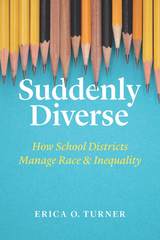 Suddenly Diverse: How School Districts Manage Race and Inequality
Erica O. Turner
University of Chicago Press, 2020 For the past five years, American public schools have enrolled more students identified as Black, Latinx, American Indian, and Asian than white. At the same time, more than half of US school children now qualify for federally subsidized meals, a marker of poverty. The makeup of schools is rapidly changing, and many districts and school boards are at a loss as to how they can effectively and equitably handle these shifts.
Suddenly Diverse is an ethnographic account of two school districts in the Midwest responding to rapidly changing demographics at their schools. It is based on observations and in-depth interviews with school board members and superintendents, as well as staff, community members, and other stakeholders in each district: one serving “Lakeside,” a predominately working class, conservative community and the other serving “Fairview,” a more affluent, liberal community. Erica O. Turner looks at district leaders’ adoption of business-inspired policy tools and the ultimate successes and failures of such responses. Turner’s findings demonstrate that, despite their intentions to promote “diversity” or eliminate “achievement gaps,” district leaders adopted policies and practices that ultimately perpetuated existing inequalities and advanced new forms of racism.
While suggesting some ways forward, Suddenly Diverse shows that, without changes to these managerial policies and practices and larger transformations to the whole system, even district leaders’ best efforts will continue to undermine the promise of educational equity and the realization of more robust public schools.
 Suddenly Jewish: Jews Raised as Gentiles Discover Their Jewish Roots
Barbara Kessel
Brandeis University Press, 2007 One woman learned on the eve of her Roman Catholic wedding. One man as he was studying for the priesthood. Madeleine Albright famously learned from the Washington Post when she was named Secretary of State. "What is it like to find out you are not who you thought you were?" asks Barbara Kessel in this compelling volume, based on interviews with over 160 people who were raised as non-Jews only to learn at some point in their lives that they are of Jewish descent. With humor, candor, and deep emotion, Kessel's subjects discuss the emotional upheaval of refashioning their self-image and, for many, coming to terms with deliberate deception on the part of parents and family. Responses to the discovery of a Jewish heritage ranged from outright rejection to wholehearted embrace. For many, Kessel reports, the discovery of Jewish roots confirmed long-held suspicions or even, more mysteriously, conformed to a long-felt attraction toward Judaism. For some crypto-Jews in the southwest United States (descendants of Jews who fled the Spanish Inquisition), the only clues to their heritage are certain practices and traditions handed down through the generations, whose significance may be long since lost. In Poland and other parts of eastern Europe, many Jews who were adopted as infants to save them from the Holocaust are now learning of their heritage through the deathbed confessions of their adoptive parents. The varied responses of these disparate people to a similar experience, presented in their own words, offer compelling insights into the nature of self-knowledge. Whether they had always suspected or were taken by surprise, Kessel's respondents report that confirmation of their Jewish heritage affected their sense of self and of their place in the world in profound ways. Fascinating, poignant, and often very funny, Suddenly Jewish speaks to crucial issues of identity, selfhood, and spiritual community.
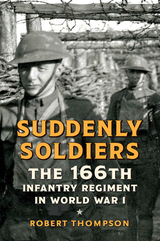 Suddenly Soldiers: The 166th Infantry Regiment in World War I
Robert Thompson
Westholme Publishing, 2020 Finalist for the 2021 Army Historical Foundation Distinguished Writing Awards in Unit Histories
Americans Face the Horror of a Modern European War for the First Time
When America entered World War I in April 1917, state National Guard units had never planned to mobilize for this kind of war, and the men who made up the hometown companies of each regiment never imagined that they would be asked to fight in what was then the most savage war in human history—they were “innocents” being thrown into a horrendous European conflagration. Made up of companies from ten Ohio towns, the 166th Infantry Regiment became part of the famous 42nd Division, known as the “Rainbow Division.” They were the third American division to arrive in France, where they fought courageously in the trenches at Lunéville and Baccarat before being a key part of the American effort in the Second Battle of the Marne and the Saint Mihiel and Meuse-Argonne offensives. Despite their initial lack of training in modern warfare and weapons, the 166th Infantry compiled an impressive combat record. However, that record came at a terrible cost, with the regiment suffering over two thousand casualties in just nine months of fighting. While they battled the Germans, these hometown Guardsmen lived in trenches and foxholes for weeks at a time, while subsisting on canned beef and coffee amid near constant rain, deep mud, rats, and body lice that made their lives miserable. Because of poor planning and leadership from higher headquarters, they were often asked to achieve impossible objectives amid withering enemy machine-gun fire without proper logistics or artillery support. Yet, despite these challenges, they would persevere, overcome, and emerge victorious.
Using regimental histories and the letters and diaries of the soldiers who fought in France, Suddenly Soldiers: The 166th Infantry Regiment in World War I by author and historian Robert Thompson tells the compelling story of the young men—“citizen soldiers”—who have always borne the cost of America’s freedom with quiet courage.
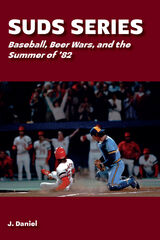 Suds Series: Baseball, Beer Wars, and the Summer of '82
J. Daniel
University of Missouri Press, 2023 In Suds Series, J. Daniel takes readers back forty years, telling a story that is part baseball history, part urban history, and part U.S. cultural history, the narrative weaving together the development of the Midwest cities of St. Louis and Milwaukee through their engagement with beer and baseball. As the National and American League champions squared off for the 1982 Fall Classic, the St. Louis Cardinals, owned by Anheuser-Busch, took on the Milwaukee Brewers, so named by owner Bud Selig in homage to the city’s baseball and brewing past.
Even nominal baseball fans will enjoy reading about legendary players, teams, and personalities that emerged in the 1982 season: the year Ricky Henderson stole 130 bases; Reggie Jackson led the league in home runs; and Cal Ripken Jr. began his remarkable playing streak. Readers will also enjoy the cultural references, including the Pac-Man craze, a chart-topping album by Rush, and the “Light Beer Wars” waged by Anheuser-Busch and the Miller Brewing Company through a series of humorous TV commercials featuring well-loved professional sports figures.
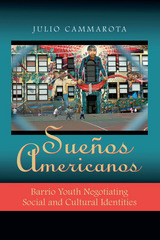 Sueños Americanos: Barrio Youth Negotiating Social and Cultural Identities
Julio Cammarota
University of Arizona Press, 2012 Education is a primary route to rewarding employment and economic security. It is particularly significant for the future prospects of children who are ethnic minorities, were born into disadvantaged economic circumstances, or are dealing with language barriers.
For nearly a decade Julio Cammarota interviewed and observed Latino youth between the ages of seventeen and twenty-four who lived in a barrio in a city on the California coast. He conducted forty life interviews, selecting six people to investigate in depth. Twenty of the study participants worked at a fast-food restaurant, while the other twenty worked at a community cultural center.
Focusing on the experiences of his subjects in the primary settings of family, work, and school, Cammarota structured his research to examine how Latino youth negotiate myriad social conditions and hostile economic and political pressures in their daily lives. His extensive interviews and incisive analyses illuminate the complex relationships among low-wage employment, cultural standards, education, class oppression, and gender expectations.
Among other topics, Cammarota investigates how working affects Latino education; how gender influences social relationships and life choices; how Latinos and Latinas try to maintain their distinct ethnic identity while attempting to transcend marginalization; whether the Latino culture helps young people work hard for their families and for a better future; and how the connections and disconnections among work, family, and school constitute formative processes that shape the cultural identities of Latino youth.
One of the most extensive studies of barrio youth available, Sueños Americanos concludes with a discussion of social justice education for Latino youth and how this educational approach meets their academic needs while providing opportunities for self-determination and community activism.
 Suffer the Future: Policy Choices in Southern Africa
Robert I. Rotberg
Harvard University Press, 1980 Will southern Africa explode? Are there alternatives to violent revolution? Can other countries assist South Africa, Namibia, and Zimbabwe in achieving majority rule? Or can the problems be solved only by the peoples of each nation? And what should be done by the West to aid development, encourage racial harmony, and promote the general welfare?
For more than a generation Robert Rotberg has visited and written about southern Africa. He has not only studied the history and politics of the area but also has steeped himself in the economic, environmental, and geographic factors that have helped create conflict there. Rotberg has blended sophisticated political knowledge with personal experience to recount the past and make possible an understanding of the future. The result is a timely, wise, and lucid portrait of three nations in search of a destiny. Suffer the Future is a balanced account aimed at making general readers, as well as students of international problems, aware of the realistic alternatives for policy in and toward southern Africa.
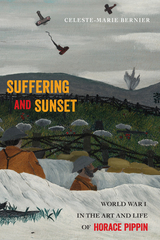 Suffering and Sunset: World War I in the Art and Life of Horace Pippin
Celeste-Marie Bernier
Temple University Press, 2017 For self-made artist and soldier Horace Pippin—who served in the 369th all-black infantry in World War I until he was wounded—war provided a formative experience that defined much of his life and work. His ability to transform combat service into canvases of emotive power, psychological depth, and realism showed not only how he viewed the world but also his mastery as a painter. In Suffering and Sunset, Celeste-Marie Bernier painstakingly traces Pippin’s life story of art as a life story of war. Illustrated with more than sixty photographs, including works in various mediums—many in full color—this is the first intellectual history and cultural biography of Pippin. Working from newly discovered archives and unpublished materials, Bernier provides an in-depth investigation into the artist’s development of an alternative visual and textual lexicon and sheds light on his work in its aesthetic, social, and political contexts. Suffering and Sunset illustrates Pippin’s status as a groundbreaking artist as it shows how this African American painter suffered from but also staged many artful resistances to racism in a white-dominated art world.
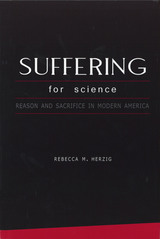 Suffering For Science: Reason and Sacrifice in Modern America
Herzig, Rebecca
Rutgers University Press, 2006 From gruesome self-experimentation to exhausting theoretical calculations, stories abound of scientists willfully surrendering health, well-being, and personal interests for the sake of their work. What accounts for the prevalence of this coupling of knowledge and pain-and for the peculiar assumption that science requires such suffering? In this lucid and absorbing history, Rebecca M. Herzig explores the rise of an ethic of "self-sacrifice" in American science. Delving into some of the more bewildering practices of the Gilded Age and the Progressive Era, she describes when and how science-the supposed standard of all things judicious and disinterested-came to rely on an enthralled investigator willing to embrace toil, danger, and even lethal dismemberment. With attention to shifting racial, sexual, and transnational politics, Herzig examines the suffering scientist as a way to understand the rapid transformation of American life between the Civil War and World War I.
Suffering for Science reveals more than the passion evident in many scientific vocations; it also illuminates a nation's changing understandings of the purposes of suffering, the limits of reason, and the nature of freedom in the aftermath of slavery.
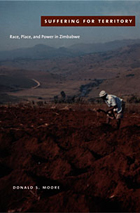 Suffering for Territory: Race, Place, and Power in Zimbabwe
Donald S. Moore
Duke University Press, 2005 Since 2000, black squatters have forcibly occupied white farms across Zimbabwe, reigniting questions of racialized dispossession, land rights, and legacies of liberation. Donald S. Moore probes these contentious politics by analyzing fierce disputes over territory, sovereignty, and subjection in the country’s eastern highlands. He focuses on poor farmers in Kaerezi who endured colonial evictions from their ancestral land and lived as refugees in Mozambique during Zimbabwe’s guerrilla war. After independence in 1980, Kaerezians returned home to a changed landscape. Postcolonial bureaucrats had converted their land from a white ranch into a state resettlement scheme. Those who defied this new spatial order were threatened with eviction. Moore shows how Kaerezians’ predicaments of place pivot on memories of “suffering for territory,” at once an idiom of identity and entitlement. Combining fine-grained ethnography with innovative theoretical insights, this book illuminates the complex interconnections between local practices of power and the wider forces of colonial rule, nationalist politics, and global discourses of development. Moore makes a significant contribution to postcolonial theory with his conceptualization of “entangled landscapes” by articulating racialized rule, situated sovereignties, and environmental resources. Fusing Gramscian cultural politics and Foucault’s analytic of governmentality, he enlists ethnography to foreground the spatiality of power. Suffering for Territory demonstrates how emplaced micro-practices matter, how the outcomes of cultural struggles are contingent on the diverse ways land comes to be inhabited, labored upon, and suffered for.
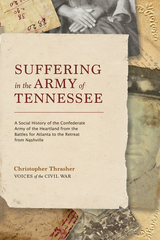 Suffering in the Army of Tennessee: A Social History of the Confederate Army of the Heartland from the Battles for Atlanta to the Retreat from Nashville
Christopher Thrasher
University of Tennessee Press, 2021 Winner of the 2022 Douglas Southall Freeman Award!
Confederate historiography of the Civil War is rich with stories of leaders and decision makers—oft-repeated names immortalized by their association with America’s great trial of the 1860s. But while scholarship exploring the roles of Confederate generals and politicians abounds, a major part of the story remains untold: that of the ordinary people who became soldiers and turned the very pages of Civil War history.
Part of the Voices of the Civil War series, Suffering in the Army of Tennessee doesn’t just draw upon one single diary or letter collection, and it does not use brief quotations as a way to fill out a larger narrative. Rather, across eight chapters spanning the Atlanta Campaign to the Battle of Nashville in 1864, Thrasher draws upon a remarkably broad set of primary sources—newspapers, manuscripts, archives, diaries, and official documents—to tell a story that knits together accounts of senior officers, the final campaigns of the Western Theater, and the experiences of the civilians and rebel soldiers who found themselves deep in the trenches of a national reckoning. While volumes have been written on the Atlanta Campaign or the Battles of Nashville and Franklin, no previous historian has constructed what amounts to a sweeping social history of the Army of Tennessee—the daily details of soldiering and the toll it took on the men and boys who mustered into service foreseeing only a small skirmish among the states.
While this volume will appeal to Civil War buffs and military history scholars, its accessible structure and engaging narrative style will likewise captivate American history enthusiasts, students, and general readers.
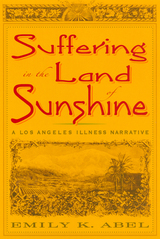 Suffering in the Land of Sunshine: A Los Angeles Illness Narrative
Abel, Emily K.
Rutgers University Press, 2006 The history of medicine is much more than the story of doctors, nurses, and hospitals. Seeking to understand the patient’s perspective, historians scour the archives, searching for rare personal accounts. Bringing together a trove of more than 400 family letters by Charles Dwight Willard, Suffering in the Land of Sunshine provides a unique window into the experience of sickness.
A Los Angeles civic leader at the turn of the twentieth century, Willard is well known to historians of the West, but exclusively for his public life as a booster and reformer. Willard’s evocative story offers fresh insights into several critical issues, including how concepts of gender, class, and race shape patients’ representations of their illness, how expectations of cure affect the illness experience, how different cultures constrain the coping strategies of the sick, and why robust health is such an exalted value in certain societies.
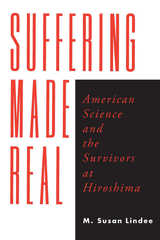 Suffering Made Real: American Science and the Survivors at Hiroshima
M. Susan Lindee
University of Chicago Press, 1994 The atomic bombs dropped on Hiroshima and Nagasaki in August of 1945 unleashed a force as mysterious as it was deadly—radioactivity. In 1946, the United States government created the Atomic Bomb Casualty Commission (ABCC) to serve as a permanent agency in Japan with the official mission of studying the medical effects of radiation on the survivors. The next ten years saw the ABCC's most intensive research on the genetic effects of radiation, and up until 1974 the ABCC scientists published papers on the effects of radiation on aging, life span, fertility, and disease.
Suffering Made Real is the first comprehensive history of the ABCC's research on how radiation affected the survivors of the atomic bomb. Arguing that Cold War politics and cultural values fundamentally shaped the work of the ABCC, M. Susan Lindee tells the compelling story of a project that raised disturbing questions about the ethical implications of using human subjects in scientific research.
How did the politics of the emerging Cold War affect the scientists' biomedical research and findings? How did the ABCC document and publicly present the effects of radiation? Why did the ABCC refuse to provide medical treatment to the survivors? Through a detailed examination of ABCC policies, archival materials, the minutes of committee meetings, newspaper accounts, and interviews with ABCC scientists, Lindee explores how political and cultural interests were reflected in the day-to-day operations of this controversial research program.
Set against a period of conflicting views of nuclear weapons and nuclear power, Suffering Made Real follows the course of a politically charged research program and reveals in detail how politics and cultural values can shape the conduct, results, and uses of science.
Suffering Presence
Stanley Hauerwas
University of Notre Dame Press, 1986 "Stanley Hauerwas challenges the dominant paradigms of contemporary ethics and views the moral crisis in medicine in this excellent collection of essays. He provides fresh insights into such diverse issues as whether the goal of medicine is to forestall death, how moral relations in a family may be redefined in response to novel reproductive techniques, and whether there are limits to the duties of parents of children who are disabled." --Cynthia B. Cohen, Ph.D., J.D., The Hastings Center
"A well-formed theological perspective that illuminates the moral life, particularly medical care and the care of children and the handicapped." --James S. Childress, University of Virginia
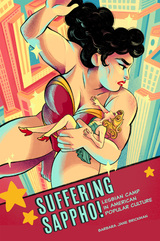 Suffering Sappho!: Lesbian Camp in American Popular Culture
Barbara Jane Brickman
Rutgers University Press, 2024 An ever-expanding and panicked Wonder Woman lurches through a city skyline begging Steve to stop her. A twisted queen of sorority row crashes her convertible trying to escape her queer shame. A suave butch emcee introduces the sequined and feathered stars of the era’s most celebrated drag revue. For an unsettled and retrenching postwar America, these startling figures betrayed the failure of promised consensus and appeasing conformity. They could also be cruel, painful, and disciplinary jokes. It turns out that an obsession with managing gender and female sexuality after the war would hardly contain them. On the contrary, it spread their campy manifestations throughout mainstream culture. Offering the first major consideration of lesbian camp in American popular culture, Suffering Sappho! traces a larger-than-life lesbian menace across midcentury media forms to propose five prototypical queer icons—the sicko, the monster, the spinster, the Amazon, and the rebel. On the pages of comics and sensational pulp fiction and the dramas of television and drive-in movies, Barbara Jane Brickman discovers evidence not just of campy sexual deviants but of troubling female performers, whose failures could be epic but whose subversive potential could inspire. Supplemental images of interest related to this title: George and Lomas; Connie Minerva; Cat On Hot Tin; and Beulah and Oriole.
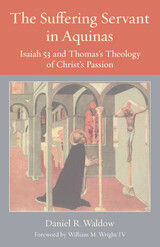 The Suffering Servant in Aquinas: Isaiah 53 and Thomas's Theology of Christ's Passion
Daniel R. Waldow
Catholic University of America Press, 2024 The “Suffering Servant” text of Isaiah 53 is a perennial topic of debate within Jewish and Christian biblical theology. Is the Suffering Servant an individual, a group, or both? How and why did he suffer? What role did God play in his suffering? How is his suffering related to human salvation? The answers to these questions often divide Jewish and Christian readers of Scripture as well as Christians across different denominations. In particular, Isaiah 53 tends to inform different Christian accounts of the origin, nature, and saving value of Christ’s Passion.
The Suffering Servant in Aquinas contributes to the debate on the meaning of Isaiah 53 and its bearing upon the Passion of Christ by examining how St. Thomas Aquinas engaged this biblical text. This book examines every explicit reference to Isaiah 53 that Aquinas makes in his biblical commentaries, Commentary on the Sentences, Summa Theologiae, and Opuscula. It analyzes how and why Aquinas interprets Isaiah 53 in the ways that he does. It focuses especially upon how Aquinas draws upon Isaiah 53 to shed light on the saving mystery of Christ’s Passion. Readers will see how Aquinas articulates the relationship between God’s will and Christ’s suffering, the diverse forms of Christ’s pain, the degree to which the Passion can be considered a “punishment,” and the saving functions of the Passion as example, merit, satisfaction, and sacrifice.
This book makes an original contribution to the growing field of Biblical Thomism. It examines Aquinas’s exegetical methods as well as the role of Scripture within his speculative theology. And it properly contextualizes Aquinas’s exegesis by considering the differences between his Latin version of Isaiah 53 and contemporary renderings of Hebrew and Greek versions. Readers will see that Aquinas’s Christological interpretations of Isaiah 53 are both exegetically intriguing and theologically rich.
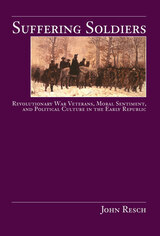 Suffering Soldiers: Revolutionary War Veterans, Moral Sentiment, and Political Culture in the Early Republic
John Resch
University of Massachusetts Press, 1999 This book examines how the moral sentiment of gratitude, as expressed in the image of the suffering soldier, transformed the memory of the Revolutionary War, political culture, and public policy in the early American republic. This popular depiction removed the stigma of vice and treason from the Continental Army, legitimized the army as a republican institution, and credited it with securing independence. By glorifying the now aged, impoverished, and infirm Continental soldiers as republican warriors, the image also accentuated the nation's guilt for its ingratitude toward the veterans. Using Peterborough, New Hampshire, as a case study, John P. Resch shows that the power of the suffering soldier image lay partly in its reflection of reality. The citizen-soldiers from Peterborough who fought in the Continental Army did indeed represent a cross-section of the town, and they experienced greater postwar deprivation and alienation than their peers who had not gone to war. Personal and political sympathy toward the veterans eventually led to the passage of the Revolutionary War Pension Act in 1818. The War Department further validated the soldiers' claims and public gratitude through its liberal administration of the pension program, which attracted more than 20,000 applications.
Suffrage and citizenship in Ireland, 1912-18
Senia Pašeta
University of London Press, 2019 Professor Senia Pašeta argues that our understanding of modern Irish and British politics would be enormously enriched if we recognized two things: that the Irish and British suffrage movements were deeply connected; and that the women’s suffrage movement across the United Kingdom was shaped in fundamental ways by the Irish Question from the late nineteenth century and into the twentieth. In other words, the women’s suffrage movement did not exist in a political vacuum. It interacted with, influenced and was influenced by the other main political questions of the day, and with the main political question of the day - Ireland.
A Suffragette in America: Reflections on Prisoners, Pickets and Political Change
Sylvia Pankhurst
Pluto Press, 2019 In 1911, leading English suffragette Sylvia Pankhurst visited America. Unlike other suffragette leaders, who spent their time in America among the social elite, Pankhurst wasted no time getting right to the heart of America’s social problems. She visited striking laundry workers in New York and female prisoners in Philadelphia and Chicago, and she grappled firsthand with shocking racism in Nashville.
This book gathers Pankhurst’s writings from the year-long visit, in which she reveals her shock at the darkness hidden in American life, and draws parallels to her experiences of imprisonment and misogyny in her own country. Never before published, these writings mark an important stage in the development of the suffragette's thought, which she brought back to Britain to inform the burgeoning suffrage campaign there.
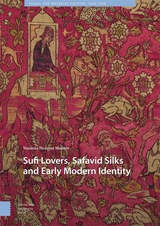 Sufi Lovers, Safavid Silks and Early Modern Identity
Nazanin Hedayat Munroe
Amsterdam University Press, 2023 This book examines a group of sixteenth- and seventeenth-century figural silks depicting legendary lovers from the Khamsa (Quintet) of epic Persian poetry. Codified by Nizami Ganjavi in the twelfth century, the Khamsa gained popularity in the Persian-speaking realm through illustrated manuscripts produced for the elite, creating a template for illustrating climactic scenes in the love stories of “Layla and Majnun” and “Khusrau and Shirin” that appear on early modern silks. Attributed to Safavid Iran, the publication proposes that dress fashioned from these silks represented Sufi ideals based on the characters. Migration of weavers between Safavid and Mughal courts resulted in producing goods for a sophisticated and educated elite, demonstrating shared cultural values and potential reattribution. Through an examination of primary source materials, literary analysis of the original text, and close iconographical study of figural designs, the study presents original cross-disciplinary arguments about patronage, provenance, and the socio-cultural significance of wearing these silks.
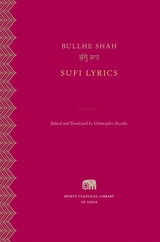 Sufi Lyrics
Bullhe Shah
Harvard University Press, 2015 A modern translation of verses by Bullhe Shah, the iconic eighteenth-century Sufi poet, treasured by readers worldwide to this day.
The poetry of Bullhe Shah (d. 1758) is considered one of the glories of premodern Panjabi literature. Born in Uch, Panjab, in present-day Pakistan, Bullhe Shah drew profoundly upon Sufi mysticism in his writings. His lyrics, famous for their vivid style and outspoken denunciation of artificial religious divisions, have long been held in affection by Hindus, Muslims, and Sikhs, and they continue to win audiences today across national boundaries and in the global Panjabi diaspora. Indeed, many young people in South Asia are already acquainted—albeit unknowingly at times—with the iconic eighteenth-century Panjabi poet’s words through popular musical genres of the twenty-first century.
The striking new translation in English is presented alongside the Panjabi text, in the Gurmukhi script, re-edited on the basis of the best modern Pakistani and Indian editions. Bullhe Shah’s Sufi Lyrics thus offers at once the most complete and most approachable version of this great poet’s works yet available.
Sufi Lyrics: Selections from a World Classic
Bullhe Shah
Harvard University Press, 2021 A modern translation of verses by Bullhe Shah, the iconic eighteenth-century Sufi poet, treasured by readers worldwide to this day.
Bullhe Shah’s work is among the glories of Panjabi literature, and the iconic eighteenth-century poet is widely regarded as a master of mystical Sufi poetry. His verses, famous for their vivid style and outspoken denunciation of artificial religious divisions, have long been beloved and continue to win audiences around the world. This striking new translation is the most authoritative and engaging introduction to an enduring South Asian classic.
Sufi Masters and the Creation of Saintly Spheres in Medieval Syria
Daphna Ephrat
Arc Humanities Press, 2021 This book explores the creation of saintly spheres surrounding Sufi masters who functioned as embodiments of Islamic sainthood and imprinted their tangible mark on the land. Situated in the Syrian milieu of the counter-crusader period that was marked by intense religious excitement and re-sanctification of the landscape, the study centres on the role of Sufi saints as revivers of the prophetic legacy and as patrons of fellow believers, and their association with the glorious history of ancient Syrian cities and the expanding sacred landscape. Based upon a variety of literary sources, including hitherto unexplored saintly vitas, the investigation aims to contribute to an understanding of the process through which the religious and charismatic leadership of the venerated shaykhs was sustained and diffused, and their holiness emplaced and commemorated.
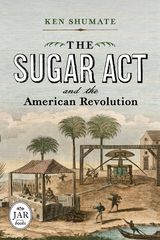 The Sugar Act and the American Revolution
Ken Shumate
Westholme Publishing, 2022 The first act of Parliament to levy direct taxation on the colonies, the Sugar Act of 1764 defined a new colonial policy and prompted a decade of protests that ended in open rebellion against Great Britain. The initial Sugar Act of 1733—also known as the Molasses Act—was designed to secure and encourage the trade of British colonies in the West Indies by placing prohibitive duties on the products of competing foreign colonies. The dramatic revision to that act in 1764 imposed duties for both revenue and trade regulation, in addition strengthening the laws of trade so as to tighten the connection between Great Britain and the colonies. In 1766, a revision to the act of 1764 responded to American grievances, but also transformed the Sugar Act into an explicit law for taxation. Americans, having long seen the act as within Parliament’s authority to regulate their trade, did not at first see the duties as taxes—and paid them without complaint. The resulting revenue was greater than that exacted by any other parliamentary tax on America.
The Sugar Act and the American Revolution by Ken Shumate is the only book-length treatment of this first great challenge of the revolutionary era. For each of the three incarnations of the act, the author provides a clause-by-clause description, including the British reasoning behind the duties and trade restrictions, and a summary of the resulting American grievance. Following the explanation of each act are chapters describing the protests of American merchants and popular leaders, and the British response to those protests. As a consequence of further parliamentary acts of taxation, the story ends with the demand in 1774 by the First Continental Congress for Parliament to repeal the Sugar Act as being “essentially necessary in order to restore harmony between Great Britain and the American colonies.”
Sugar and Slavery in Puerto Rico: The Plantation Economy of Ponce, 1800–1850
Francisco A. Scarano
University of Wisconsin Press, 1984 This important study of Ponce, a major sugar-producing district in Puerto Rico, examines in detail the processes by which a predominantly peasant economy an society was transformed into a plantation system. Scarano’s work, one of the first full investigations into Puerto Rico’s nineteenth-century economic history, dispels the long-held belief that slavery was an inconsequential factor in this society; indeed, he finds that the new plantation system was fully dependent on African slave labor, and that the initial stimuli for economic change came from immigrants.
Sugar and Society in China: Peasants, Technology, and the World Market
Sucheta Mazumdar
Harvard University Press, 1998 In this wide-ranging study, Sucheta Mazumdar offers a new answer to the fundamental question of why China, universally acknowledged as one of the most developed economies in the world through the mid-eighteenth century, paused in this development process in the nineteenth.
Focusing on cane-sugar production, domestic and international trade, technology, and the history of consumption for over a thousand years as a means of framing the larger questions, the author shows that the economy of late imperial China was not stagnant, nor was the state suppressing trade; indeed, China was integrated into the world market well before the Opium War. But clearly the trajectory of development did not transform the social organization of production or set in motion sustained economic growth.
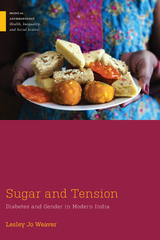 Sugar and Tension: Diabetes and Gender in Modern India
Weaver, Lesley Jo
Rutgers University Press, 2019 Women in North India are socialized to care for others, so what do they do when they get a disease like diabetes that requires intensive self-care? In Sugar and Tension, Lesley Jo Weaver uses women’s experiences with diabetes in New Delhi as a lens to explore how gendered roles and expectations are taking shape in contemporary India. Weaver argues that although women’s domestic care of others may be at odds with the self-care mandates of biomedically-managed diabetes, these roles nevertheless do important cultural work that may buffer women’s mental and physical health by fostering social belonging. Weaver describes how women negotiate the many responsibilities in their lives when chronic disease is at stake. As women weigh their options, the choices they make raise questions about whose priorities should count in domestic, health, and family worlds. The varied experiences of women illustrate that there are many routes to living well or poorly with diabetes, and these are not always the ones canonized in biomedical models of diabetes management.
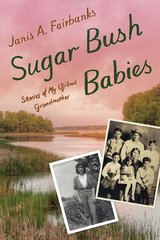 Sugar Bush Babies: Stories of My Ojibwe Grandmother
Janis A. Fairbanks
University of Minnesota Press, 2025 A memoir of lessons learned from an Ojibwe grandmother during the time of Relocation
Why, her mother asked, did Janis keep running away from kindergarten? She wanted to go home. But not to the house they had just moved to in Duluth, with its gravel yard and traffic noise. She was a country girl, and home was the log cabin among the wildflowers on the Leech Lake Indian Reservation in Bena, Minnesota. Knowing they were now going to stay in the city, Janis’s parents offered her a compromise: during the summer, Janis could leave the bustle of Duluth and live with her grandmother on the Fond du Lac Reservation, listening to stories, learning Ojibwe, and finding her place in the world. In Sugar Bush Babies, Janis A. Fairbanks returns to that time of Relocation, dislocation, and discovery, taking us home with her through stories of childhood and lessons learned at her grandmother’s knee, enveloped in love and tradition. Through the eyes of a child and the teachings of an elder, Fairbanks revisits her life during Indian Relocation from reservations to urban areas, from Ojibwe villages to white communities whose ideas about Indians came from Hollywood Westerns. Recalling her early childhood at Leech Lake, her school days in Duluth, and her summers in Fond du Lac, Janis brings the gifts of living history full circle, continuing the traditions of carrying family lore, women’s wisdom, and Indigenous culture from generation to generation. There are tales told at nighttime or during thunderstorms; lessons in Native medicine; stories of Grandma’s recollections of boarding school, Daddy’s days as a lumberjack, and Mother’s special powers; memories of wash days and dancing, of powwows and Girl Scout camp, of snaring rabbits, selling lilacs, and attending the circus. A lyrical memoir, Sugar Bush Babies conveys the eloquence of women speaking and sharing through generations and the lasting power of tradition.
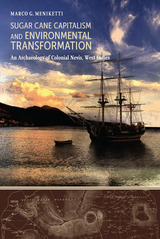 Sugar Cane Capitalism and Environmental Transformation: An Archaeology of Colonial Nevis, West Indies
Marco G. Meniketti
University of Alabama Press, 2015 Offers a rare exploration of the substantial environmental impact of capitalist sugar agriculture, colonial settlement, and the Atlantic slave trade on the Caribbean island of Nevis
In this deeply researched and multifaceted study, Marco G. Meniketti demonstrates how the landscape of the small Caribbean island of Nevis preserves and reveals artifacts and evidence of the highly complex and interrelated seventeenth- to nineteenth-century “Atlantic Economy,” comprising early capitalist sugar production, the African slave trade, and European settlement.
Sugar Cane Capitalism and Environmental Transformation is based on twelve seasons of meticulous archaeological field work and documentary research. Although Nevis was once a bustling hub of the British colonial project, the emigration of emancipated slaves and abandonment by European planters left large swathes of Nevis vacant. Reclaimed by forests and undisturbed by later waves of economic development, the island—dotted with fascinating ruins, debris from the sugar industry, windmills, chimneys, and multistoried great house—provided Meniketti with an ideal subject for archaeological inquiry.
Through intensive archaeological and landscape surveys of multiple key plantation sites, Meniketti traces the development of Nevis from its initial European settlement in 1627 to its central role as a British mercantile hub and a laboratory and prototype of capitalist sugar cultivation. His nuanced analysis explains the backdrop of European political and economic rivalries, of which the colonial agro-industrial enterprises were the physical manifestations, and makes telling comparisons with Dutch and French archaeological sites. The work also compares and contrasts the adoption of capitalist modes of sugar production and socialization at wealthy and middling plantation sites.
Supported with a wealth of photos, tables, and maps, Sugar Cane Capitalism and Environmental Transformation offers a vital case study of one island whose environment and archaeological record illuminates the complex webs of Atlantic history.
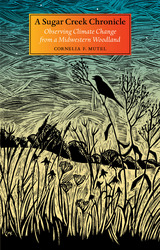 A Sugar Creek Chronicle: Observing Climate Change from a Midwestern Woodland
Cornelia F. Mutel
University of Iowa Press, 2016 In 2010, while editing a report on the effects of climate change in Iowa, ecologist Cornelia Mutel came to grips with the magnitude and urgency of the problem. She already knew the basics: greenhouse gas emissions and global average temperatures are rising on a trajectory that could, within decades, propel us beyond far-reaching, irreversible atmospheric changes; the results could devastate the environment that enables humans to thrive. The more details she learned, the more she felt compelled to address this emerging crisis. The result is this book, an artful weaving together of the science behind rising temperatures, tumultuous weather events, and a lifetime devoted to the natural world. Climate change isn’t just about melting Arctic ice and starving polar bears. It’s weakening the web of life in our own backyards.
Moving between two timelines, Mutel pairs chapters about a single year in her Iowa woodland with chapters about her life as a fledgling and then professional student of nature. Stories of her childhood ramblings in Wisconsin and the solace she found in the Colorado mountains during early adulthood are merged with accounts of global environmental dilemmas that have redefined nature during her lifespan. Interwoven chapters bring us into her woodland home to watch nature’s cycles of life during a single year, 2012, when weather records were broken time and time again. Throughout, in a straightforward manner for a concerned general audience, Mutel integrates information about the science of climate change and its dramatic alteration of the planet in ways that clarify its broad reach, profound impact, and seemingly relentless pace.
It is not too late, she informs us: we can still prevent the most catastrophic changes. We can preserve a world full of biodiversity, one that supports human lives as well as those of our myriad companions on this planet. In the end, Mutel offers advice about steps we can all take to curb our own carbon emissions and strategies we can suggest to our policy-makers.
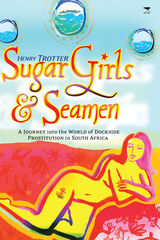 Sugar Girls & Seamen: A Journey into the World of Dockside Prostitution in South Africa
Henry Trotter
Ohio University Press, 2011 Sugar Girls and Seamen illuminates the shadowy world of dockside prostitution in South Africa, focusing on the women of Cape Town and Durban who sell their hospitality to foreign sailors. Dockside “sugar girls” work at one of the busiest cultural intersections in the world. Through their continual interactions with foreign seamen, they become major traffickers in culture, ideas, languages, styles, goods, currencies, genes, and diseases. Many learn the seamen’s languages, develop emotional relationships with them, have their babies, and become entangled in vast webs of connection. Henry Trotter argues that these South African women are the ultimate cosmopolitans, the unsung sirens of globalization. Based on research at the seamen’s nightclubs, plus countless interviews with sugar girls, sailors, club owners, cabbies, bouncers, and barmaids, this book provides a comprehensive account of dockside prostitution at the southern tip of Africa. Through stories, analysis, and firsthand experiences, it reveals this gritty world in all its raw vitality and fragile humanity. Sugar Girls and Seamen is simultaneously racy and light, critical and profound.
 The Sugar Hacienda of the Marqueses Del Valle
Ward J. Barrett
University of Minnesota Press, 1970
The Sugar Hacienda of the Marqueses Del Valle was first published in 1970. Minnesota Archive Editions uses digital technology to make long-unavailable books once again accessible, and are published unaltered from the original University of Minnesota Press editions.
This is a detailed history of a Mexican sugar plantation, the first such account to be published in English. The subject of the study is the Cortes plantation, which was established on the outskirts of Cuernavaca in about 1535 by Hernan Cortes, the conqueror of New Spain and the first Marques del Valle de Oaxaca. The plantation remained the property of his heirs and descendents until the twentieth century when, like most other sugar plantations in Morelos, it ceased production.
Professor Barrett bases his account largely on the records of the Cortes plantation, a remarkably continuous series of documents for an agricultural enterprise. He deals with the records in three principal ways: as representative of the history of the sugar industry in Mexico; as representative of the history, external relationships, structure, and management of Spanish colonial plantations; and as a chapter in the history of sugar technology. He presents a detailed picture of the entire operation of the plantation. He explains how water and land rights were acquired, the latter little by little, until a goodsized plantation was formed. He describes methods of irrigation, planting cycles, weeding and harvesting schedules, and, with the aid of charts and inventories, reconstructs the plan of the mill, describes its equipment, and traces the processing of the cane into sugar. Finally, he discusses the livestock and labor needed to run the plantation and mill—oxen and mules to plow, mules to carry the sugar to market, unskilled fieldworkers, both slave and hired, and highly skilled sugarmasters. The appendixes contain much useful supplementary material. The book is illustrated with drawings, maps, and reproductions of manuscripts.
Sugar Run Road
Ed Ochester
Autumn House Press, 2015 In his eigth full-length collection of poetry, Ochester is at his best: straight-forward and tender, he views the world with no illusions and a great deal of compassion.
The Sugarbush Coloring Book: Ojibwe Traditions Coloring Book Series
Cassie Brown
Wisconsin Historical Society Press, 2018 This series offers children and their families the opportunity to learn about Ojibwe lifeways and teachings in an engaging and accessible manner. Included in each coloring book are word scrambles, mazes, and other activities to help children and their families engage more deeply with the information and have fun at the same time. While younger children (3+) can enjoy simply coloring the images, older children (6+) can also use the stories and glossaries to start learning more about the language and traditions of the Ojibwe people. The four books in this series focus on different aspects of Ojibwe life and traditions, from the powwow to wild ricing.
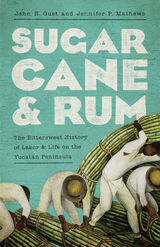 Sugarcane and Rum: The Bittersweet History of Labor and Life on the Yucatán Peninsula
John R. Gust and Jennifer P. Mathews
University of Arizona Press, 2020 While the Yucatán Peninsula of Mexico may conjure up images of vacation getaways and cocktails by the sea, these easy stereotypes hide a story filled with sweat and toil. The story of sugarcane and rum production in the Caribbean has been told many times. But few know the bittersweet story of sugar and rum in the jungles of the Yucatán Peninsula during the nineteenth century. This is much more than a history of coveted commodities. The unique story that unfolds in John R. Gust and Jennifer P. Mathews’s new history Sugarcane and Rum is told through the lens of Maya laborers who worked under brutal conditions on small haciendas to harvest sugarcane and produce rum. Gust and Mathews weave together ethnographic interviews and historical archives with archaeological evidence to bring the daily lives of Maya workers into focus. They lived in a cycle of debt, forced to buy all of their supplies from the company store and take loans from the hacienda owners. And yet they had a certain autonomy because the owners were so dependent on their labor at harvest time. We also see how the rise of cantinas and distilled alcohol in the nineteenth century affected traditional Maya culture and that the economies of Cancún and the Mérida area are predicated on the rum-influenced local social systems of the past. Sugarcane and Rum brings this bittersweet story to the present and explains how rum continues to impact the Yucatán and the people who have lived there for millennia.
 Sugarland: The Transformation of the Countryside in Communist Albania
Artan R. Hoxha
Central European University Press, 2023 In this historical monograph on non-urban communist Albania, Artan Hoxha discusses the ambitious development project that turned a swampland into a site of sugar production after 1945. The author seeks to free the history of Albanian communism from the stereotypes that still circulate about it with stigmas of an aberration, paranoia, extreme nationalism, and xenophobia. This micro-history of the agricultural and industrial transformation of a zone in southeastern Albania, explores a wide range of issues including modernization, development, and social, cultural, and economic policies. In addition to analyzing the collectivization of agriculture, Hoxha shows how communism affected the lives of ordinary rural people. As elsewhere in the Communist Bloc, the Albanian regime borrowed developmental projects from the past and implemented them using social mobilization and a command economy. The abundant archival resources along with interviews in the field attest to the authorities’ efforts to increase consumption and to radically transform people’s tastes. But the book argues that despite the repressive environment, people involved in the sugar project were not simply passive receivers of models from the nation's capital. The author also describes that—in defiance of Cold War bipolarity—technological requirements and social policy considerations required a degree of engagement with the broader world.
 Sugarless: A Novel
James Magruder
University of Wisconsin Press, 2009 Things look bad for Rick Lahrem, a high school sophomore in a cookie-cutter Chicago suburb in 1976. His mother’s second husband is a licensed psychologist who eats like an ape, his stepsister is a stoner slut, and his father is engaged to a Southern belle. Rick’s only solace is his growing collection of original Broadway-cast LPs, bought on the sly at Wax Trax.
After he brings two girls in speech class to tears by reading a story aloud, Rick is coaxed onto the interscholastic forensics team to perform an eight-minute dramatic interpretation of The Boys in the Band, the controversial sixties play about homosexuality. Unexpectedly successful at this oddball event, Rick begins winning tournaments and making friends with his teammates.
Rick also discovers the joys of sex—with a speech coach from a rival school—just as his mother, reacting to a deteriorating home environment, makes an unnerving commitment to Christ. The newly confident Rick assumes this too shall pass—until the combined forces of family, sex, and faith threaten to undo him at the state meet in Peoria.
James Magruder’s Sugarless offers a ruefully entertaining take on the simultaneous struggles of coming-out, coming-of-age, and coming-to-Jesus. A selection of InsightOut Book Club
Finalist, Lambda Book Award for Gay Debut Fiction, Lambda Literary Foundation
Finalist, TLA Gaybie Award for Best Gay Fiction
Semi-finalist, James Branch Cabell First Novelist Award, Virginia Commonwealth University
Semi-finalist, William Saroyan International Prize For Writing, Stanford University
 Sugar's Life in the Hood: The Story of a Former Welfare Mother
By Sugar Turner and Tracy Bachrach Ehlers
University of Texas Press, 2002 All her life, Sugar Turner has had to hustle to survive. An African American woman living in the inner city, she has been a single mother juggling welfare checks, food stamps, boyfriends and husbands, illegal jobs, and home businesses to make ends meet for herself and her five children. Her life's path has also wandered through the wilderness of crack addiction and prostitution, but her strong faith in God and her willingness to work hard for a better life pulled her through. Today, Turner is off welfare and is completing her education. She is computer literate, holds a job in the local school system, has sent three of her children to college, and is happily married. In this engrossing book, Sugar Turner collaborates with anthropologist Tracy Bachrach Ehlers in telling her story. Through conversations with Ehlers, diary entries, and letters, Turner vividly and openly describes all aspects of her life, including motherhood, relationships with men, welfare and work, and her attachment to her friends, family, and life in the "hood." Ehlers also gives her reactions to Turner's story, discussing not only how it belies the "welfare queen" stereotype, but also how it forced her to confront her own lingering confusions about race, her own bigotry. What emerges from this book is a fascinating story of two women from radically different backgrounds becoming equal witnesses to each other's lives. By allowing us into the real world of an inner-city African American mother, they replace with compassion and insight the stereotypes, half-truths, and scorn that too often dominate public discourse.
 Sugata Saurabha: An Epic Poem from Nepal on the Life of the Buddha
Todd T. Lewis
Harvard University Press This poem belongs of the little-known Newari (Nepal Bhasha) language and literature, specifically to its even less known Buddhist version. It is one of the very rare cases that works in Newari language appear outside Nepal.
In nineteen long cantos, the Sugata Saurabha tells of the life of the Buddha, following the traditional accounts, but situates it in the strongly local context of Newar and Nepali Buddhism. It emulates the classical (Kavya) style of the long-standing Indian tradition, and has been inspired by the 2,000-year-old Sanskrit poem, the Buddhacarita. Consequently, the poet inserts stanzas composed in traditional classical Sanskrit meter, though written in polished Newari.
The poem was composed by the greatest modern writer in Newari language, Chittadhar Hrdaya (1906– 1982), while he was imprisoned by the autocratic strongly pro-Hindu Rana regime that governed Nepal from the mid-nineteenth to the mid-twentieth century.
The poem is the best-known work of the flowering of modern Newari literature that emerged after the restrictions of the Rana regime were lifted in 1950.
 Sui Sin Far / Edith Maude Eaton: A Literary Biography
Annette White-Parks; Foreward by Roger Daniels
University of Illinois Press, 1995 The eldest daughter of a Chinese mother and British father, Edith Maude Eaton was born in the United Kingdom in 1865. Her family moved to Quebec, where she was removed from school at age ten to help support her parents and twelve siblings. In the 1880s and 1890s, Eaton worked as a stenographer, journalist, and fiction writer in Montreal, often writing under the name Sui Sin Far (Water Lily). She lived briefly in Jamaica and then settled in the United States, where she published her one book, Mrs. Spring Fragrance. Annette White-Parks offers the first full-length biography of the woman now remembered as North America's first published Asian writer. White-Parks reveals an author who defied the in vogue style of "yellow peril" literature to show Chinatowns and their inhabitants as complex, feeling human beings. Her insider's sympathy focused in particular on Chinese American women and children. Confronted with social divisions and discrimination, Sui Sin Far experimented with trickster characters and irony, sharing the coping mechanisms used by other writers who struggled to overcome the marginalization forced on them because of their race, gender, or class.
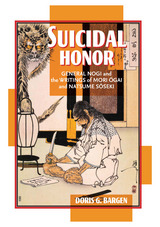 Suicidal Honor: General Nogi and the Writings of Mori Ogai and Natsume Soseki
Doris G. Bargen
University of Hawaii Press, 2006 On September 13, 1912, the day of Emperor Meiji’s funeral, General Nogi Maresuke committed ritual suicide by seppuku (disembowelment). It was an act of delayed atonement that paid a debt of honor incurred thirty-five years earlier. The revered military hero’s wife joined in his act of junshi ("following one’s lord into death"). The violence of their double suicide shocked the nation. What had impelled the general and his wife, on the threshold of a new era, to resort so drastically, so dramatically, to this forbidden, anachronistic practice? The nation was divided. There were those who saw the suicides as a heroic affirmation of the samurai code; others found them a cause for embarrassment, a sign that Japan had not yet crossed the cultural line separating tradition from modernity.
While acknowledging the nation’s sharply divided reaction to the Nogis’ junshi as a useful indicator of the event’s seismic impact on Japanese culture, Doris G. Bargen in the first half of her book demonstrates that the deeper significance of Nogi’s action must be sought in his personal history, enmeshed as it was in the tumultuous politics of the Meiji period. Suicidal Honor traces Nogi’s military career (and personal travail) through the armed struggles of the collapsing shôgunate and through the two wars of imperial conquest during which Nogi played a significant role: the Sino-Japanese War (1894–1895) and the Russo-Japanese War (1904–1905). It also probes beneath the political to explore the religious origins of ritual self-sacrifice in cultures as different as ancient Rome and today’s Nigeria. Seen in this context, Nogi’s death was homage to the divine emperor. But what was the significance of Nogi’s waiting thirty-five years before he offered himself as a human sacrifice to a dead rather than living deity? To answer this question, Bargen delves deeply and with great insight into the story of Nogi’s conflicted career as a military hero who longed to be a peaceful man of letters.
In the second half of Suicidal Honor Bargen turns to the extraordinary influence of the Nogis’ deaths on two of Japan’s greatest writers, Mori Ôgai and Natsume Sôseki. Ôgai’s historical fiction, written in the immediate aftermath of his friend’s junshi, is a profound meditation on the significance of ritual suicide in a time of historical transition. Stories such as "The Sakai Incident" ("Sakai jiken") appear in a new light and with greatly enhanced resonance in Bargen’s interpretation. In Sôseki’s masterpiece, Kokoro, Sensei, the protagonist, refers to the emperor’s death and his general’s junshi before taking his own life. Scholars routinely mention these references, but Bargen demonstrates convincingly the uncanny ways in which Sôseki’s agonized response to Nogi’s suicide structures the entire novel. By exploring the historical and literary legacies of Nogi, Ôgai, and Sôseki from an interdisciplinary perspective, Suicidal Honor illuminates Japan’s prolonged and painful transition from the idealized heroic world of samurai culture to the mundane anxieties of modernity. It is a study that will fascinate specialists in the fields of Japanese literature, history, and religion, and anyone seeking a deeper understanding of Japan’s warrior culture.
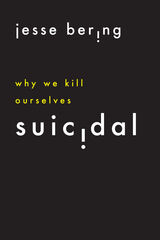 Suicidal: Why We Kill Ourselves
Jesse Bering
University of Chicago Press, 2018 For much of his thirties, Jesse Bering thought he was probably going to kill himself. He was a successful psychologist and writer, with books to his name and bylines in major magazines. But none of that mattered. The impulse to take his own life remained. At times it felt all but inescapable.
Bering survived. And in addition to relief, the fading of his suicidal thoughts brought curiosity. Where had they come from? Would they return? Is the suicidal impulse found in other animals? Or is our vulnerability to suicide a uniquely human evolutionary development? In Suicidal, Bering answers all these questions and more, taking us through the science and psychology of suicide, revealing its cognitive secrets and the subtle tricks our minds play on us when we’re easy emotional prey. Scientific studies, personal stories, and remarkable cross-species comparisons come together to help readers critically analyze their own doomsday thoughts while gaining broad insight into a problem that, tragically, will most likely touch all of us at some point in our lives. But while the subject is certainly a heavy one, Bering’s touch is light. Having been through this himself, he knows that sometimes the most effective response to our darkest moments is a gentle humor, one that, while not denying the seriousness of suffering, at the same time acknowledges our complicated, flawed, and yet precious existence.
Authoritative, accessible, personal, profound—there’s never been a book on suicide like this. It will help you understand yourself and your loved ones, and it will change the way you think about this most vexing of human problems.
|
|
